

Vietnam vs Bali: Which is Better For Travel? Full Comparison
This website contains no sponsored content. The content is written entirely on my own and is based on my personal experience and extensive research. This post may contain affiliate links. If you make a purchase through one of these links, I may receive a small commission at no extra cost to you. As an Amazon Associate I earn from qualifying purchases. Please read the disclaimer for more information.
Vietnam vs Bali – Wondering which is better for your next trip? Both tourist places are extremely popular, have a lot of touristy offerings, and are relatively pocket-friendly. Therefore, this dilemma of whether to go to Vietnam or Bali for your next trip is understandable.
In this post, I will compare and contrast the two destinations based on my personal experience of traveling to the two places to help you determine which should be your next travel destination.
Quick Overview – Vietnam vs Bali While both Vietnam and Bali are excellent choices for your next trip, If you want friendly locals, pristine beaches, and a more relaxed outing – visit Bali. But if you want more variety in terms of tourist attractions, food, and cultural and historic offerings – visit Vietnam. If price is your primary criterion – you can visit either of the places on a small budget. The major differentiating factor would be the cost of flight tickets.
Read on to find out an in-depth comparison of Vietnam vs Bali based on my personal experiences.
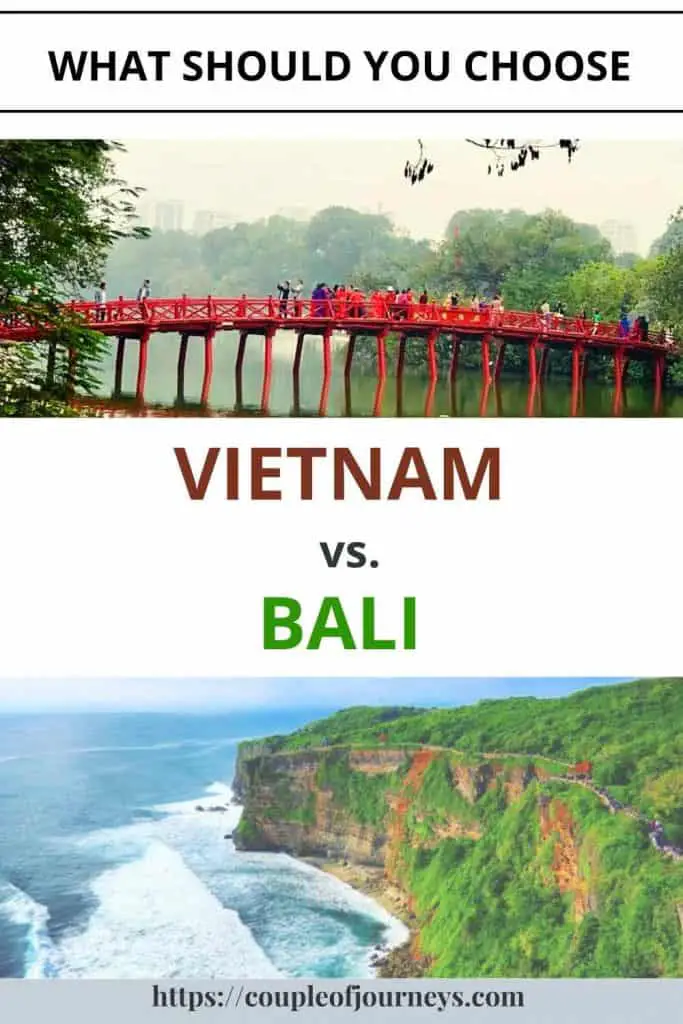
This post may contain affiliate links. If you make a purchase through one of these links, we may receive a small commission at no extra cost to you. Please read the disclaimer for more information.
Vietnam vs Bali: Which is Better For Travel
Cost of travel.
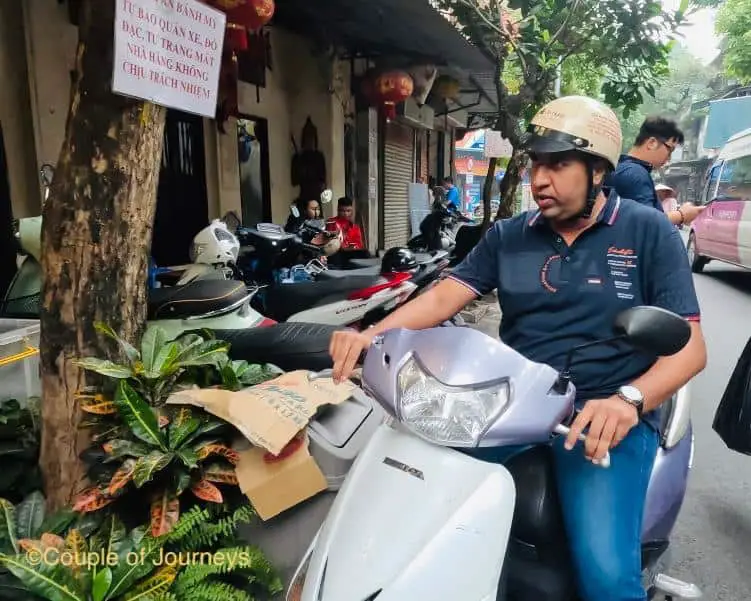
To be honest, both the places are extremely budget-friendly and the difference in the cost of travel only depends on how you choose to spend your money.
Nevertheless, as per Budget your trip , the average daily cost per day per person of Vietnam is USD 51 while that of Bali is USD 59. But just by looking at these numbers, don’t assume that Bali is more expensive than Vietnam.
My observations from traveling to the two places are
- Accommodation is cheaper in Vietnam than Bali.
- Drivers/Cars are more expensive in Vietnam
- Manmade tourist attractions like Zoos, Amusement Parks are more expensive in Bali
- Street food at both places is fairly comparable
- Food at restaurants or cafés is slightly more expensive in Vietnam than in Bali
Thus, you can plan a trip to either place on a relatively low budget.
How Many Days Required
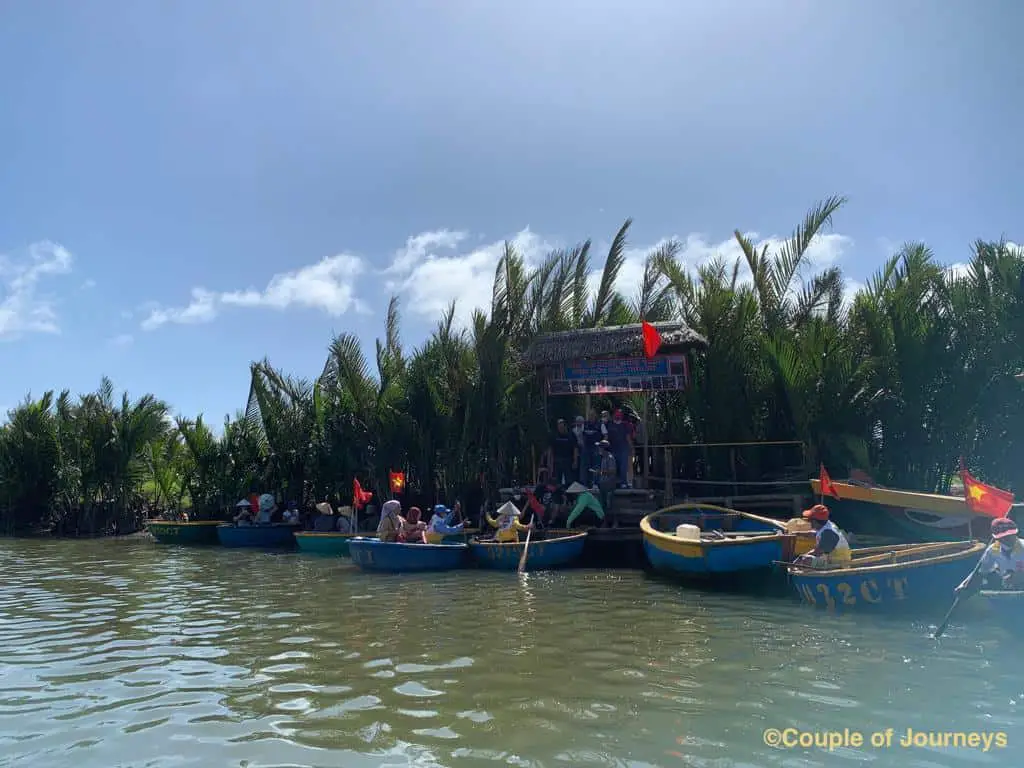
I have a full post on how many days are enough in Bali that you can read. It even includes a sample itinerary to make the most of your Bali trip. The post states that the minimum number of days required to visit Bali is between 7 and 10 . To do proper justice to your time in Bali, it is recommended to split your stay between a beach town in the south like Jimbaran, Nusa Dua or Pandawa and a green hilly area like Ubud.
On the other hand, if you are planning a trip to Vietnam, you need at least 10 days . Vietnam being a full country, there are lots of places to visit. You need to take internal flights or trains to cover the full country. To do justice to each place, you will need to spend about 2-3 days at every destination.
An ideal itinerary would require you to spend time at
- Halong Bay,
- Sapa or Ninh Binh,
- Hoi An or Da Nang
- Ho Chi Minh City
To see Vietnam in greater detail, it would even be advisable to add Ha Giang, Hue, Dalat, or Phu Quoc to your itinerary.
Friendliness of People
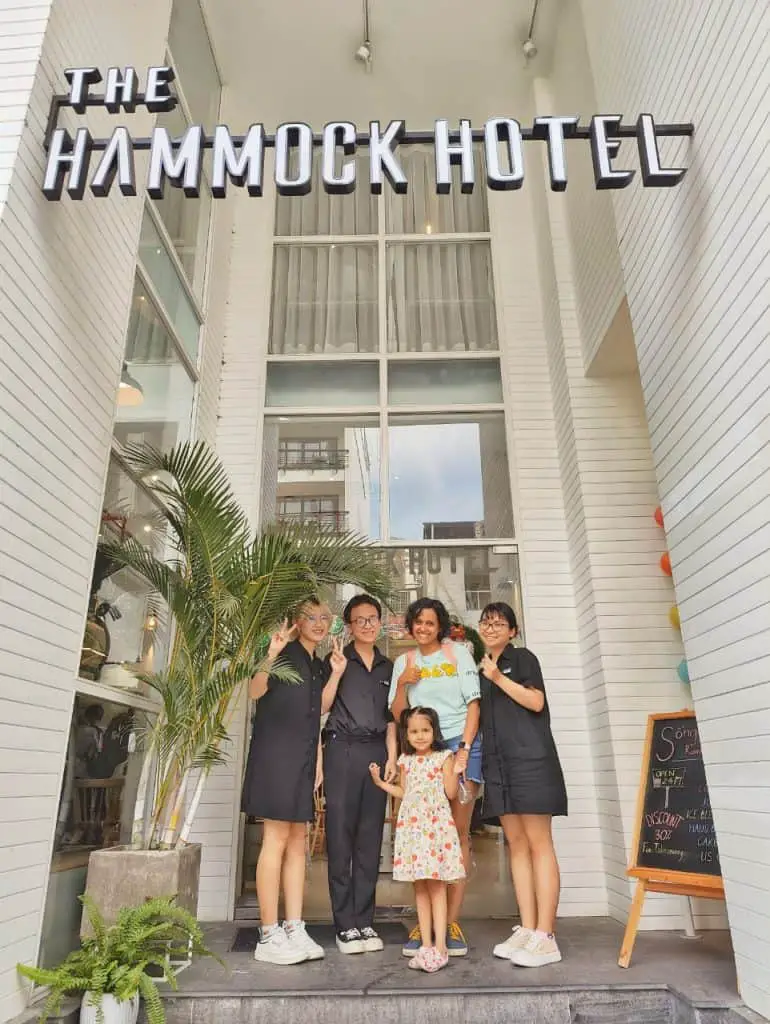
A big part of our overall experience of any place depends on how warm and welcoming the people are towards tourists.
In this regard, I felt that the Balinese people were extremely friendly. I never came across any rude or arrogant Balinese locals on my trips to Bali.
On the other hand, since tourism is not the primary source of income for Vietnamese people, Vietnamese people can come across as slightly rude. You would be rarely received with a warm, welcoming smile. Communication with Vietnamese locals would often even feel more transactional than friendly.
I have spoken all about this and other issues one could face in Vietnam in my post on 14 reasons why you may want to stay away from Vietnam.
(An exception to that was the staff at the Hammock Hotel in Ho Chi Minh City – read the full review of Hammock Hotel here)
It’s also easier to communicate with Balinese people as most understand basic English. Communicating with Vietnamese people without a translator is impossible in most cases.
Thus, from a people-friendliness point of view, Bali enjoys an upper hand over Vietnam
Geography and Climate
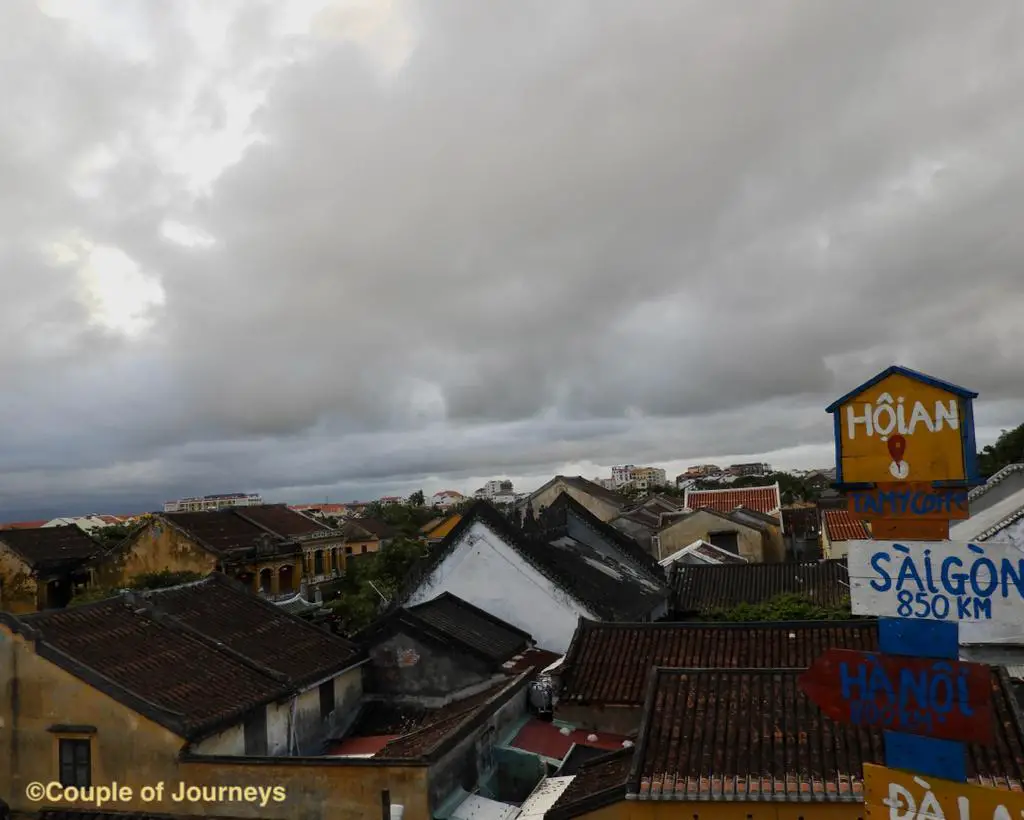
The geography and climate of Bali and Vietnam may be compared as follows
Accommodation
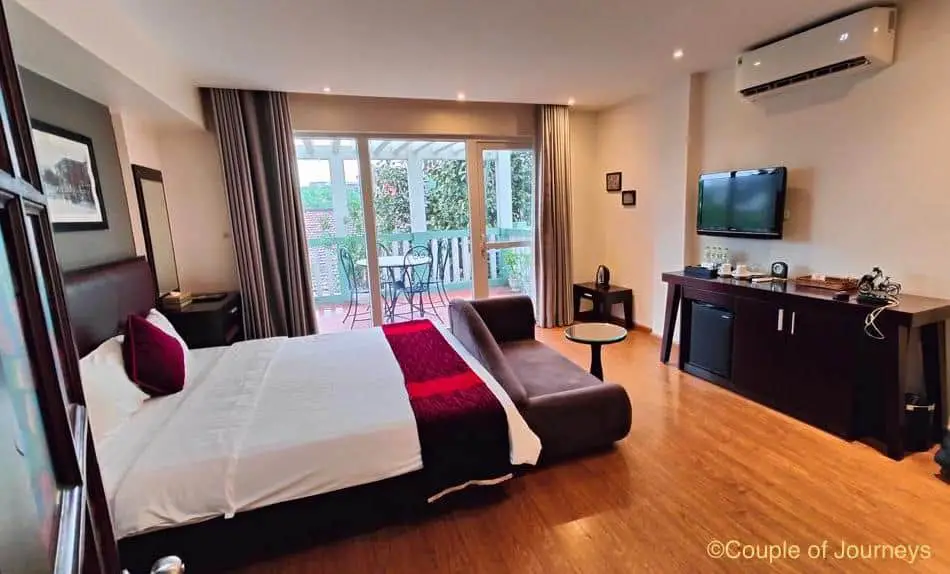
Accommodation in Vietnam and Bali is comparable especially in the budget range. Both places offer good quality budget accommodation either in the form of hostels or budget rooms.
But in the mid-range category, you get much better value for money in Vietnam. In Bali, accommodation expenses can quickly start adding up once you move away from the budget range.
For the same price, you will get
- bigger rooms in Vietnam
- better amenities in Vietnam
- better quality of stay
But the flip side to this is that there isn’t much difference between the offerings of a 3-4 star hotel in Vietnam vs that of a 5-star hotel. But in Bali, the difference in quality is noticeable. A 5-star property feels far more luxurious than a 3-4 star property.
Thus if you are looking to pamper yourself at a luxury property, Bali may be a better option for you. But if you want solid value from a mid-range property, you’ll be pleased with Vietnam.
Transport or Commute
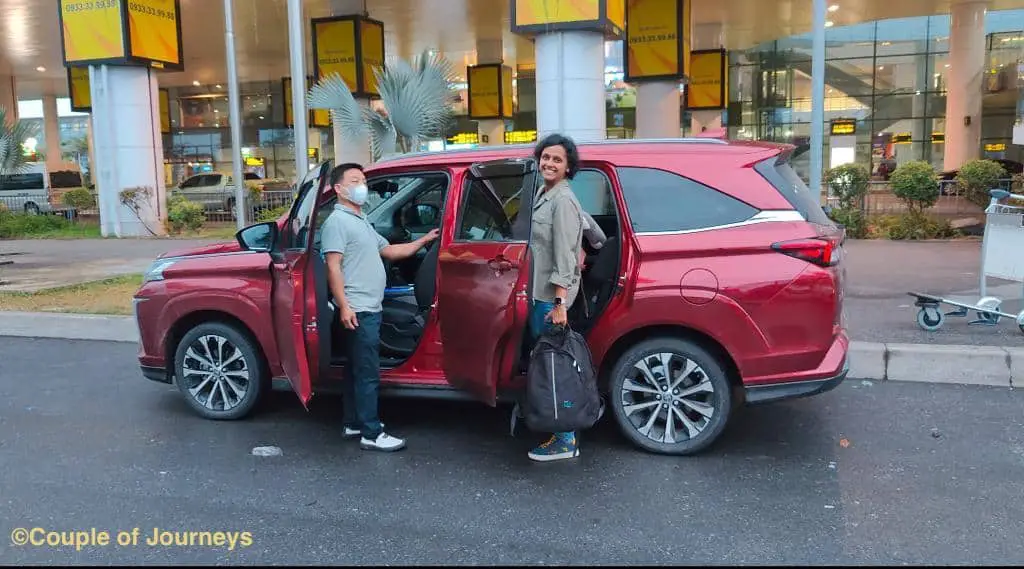
– Public transport in Vietnam is slightly more useful than the almost non-existent public transport in Bali – Renting a two-wheeler in Vietnam is slightly cheaper than in Bali. Vietnam per day scooter rental with petrol costs about USD 7, and Bali per day scooter rental with petrol costs about 9. – Hiring a car with a driver is cheaper in Bali than in Vietnam. In Bali, a full-day car with a driver costs about USD 40. In Vietnam, a full-day car with a driver costs about USD 55-60.
But the costs you save in Vietnam are often nullified because of the costs you need to incur on internal flights or trains to cover the length of the country.
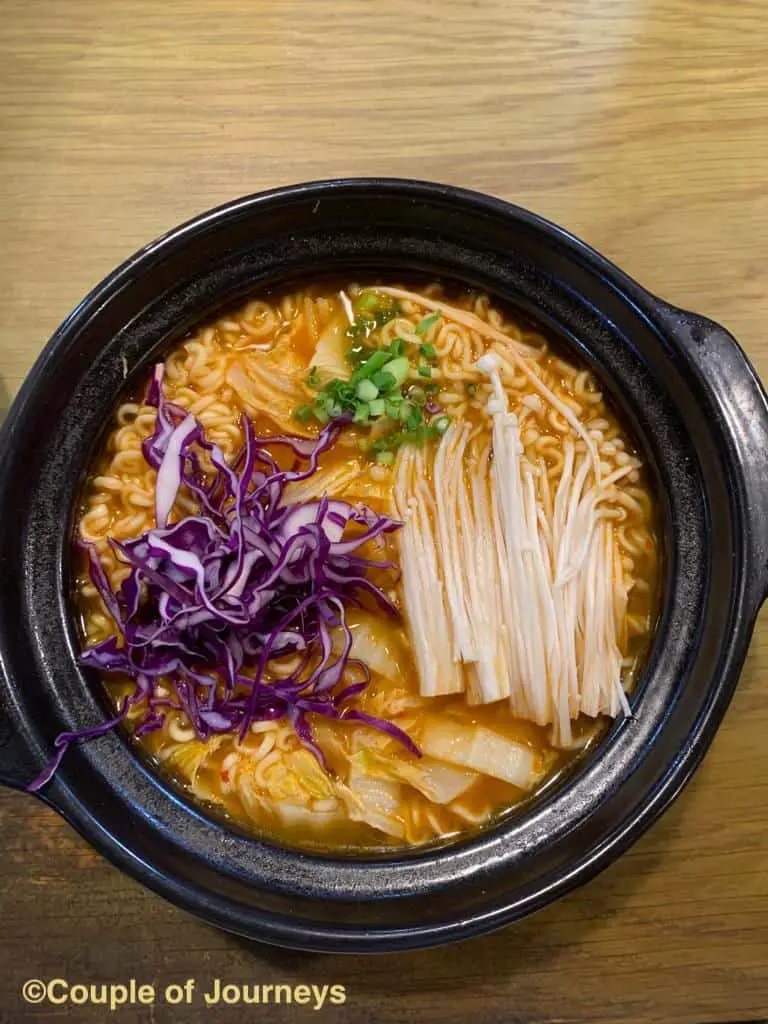
In terms of food, Vietnamese food scores higher than Balinese food for its unique taste and excellent variety.
– The food options in Vietnam include Pho, Banh Mi, Spring Rolls, Bun Cha, Ban Xeo, Egg coffee, Goi Cuon, Com Tam, etc.
Non-vegetarian eaters would also be delighted to see preparations of snails, frogs, octopuses, etc available in street markets.
Vietnamese cold brew coffee and Vietnamese drip coffee are also famous all over the world for their rich, intense aroma.
– Bali, on the other hand, serves Nasi Goreng, Nasi Campur, Mie Goreng, Sate, Babi Guling, Bebek Betutu, Gado-Gado, etc. The cuisine relies heavily on rice and meat derived from pig, chicken, and duck.
But, international preparations like pasta, pizza, burgers, etc. are more easily available in Bali than in Vietnam where you need to mostly rely on local dishes.
In terms of vegetarian or vegan food availability, Bali scores higher than Vietnam
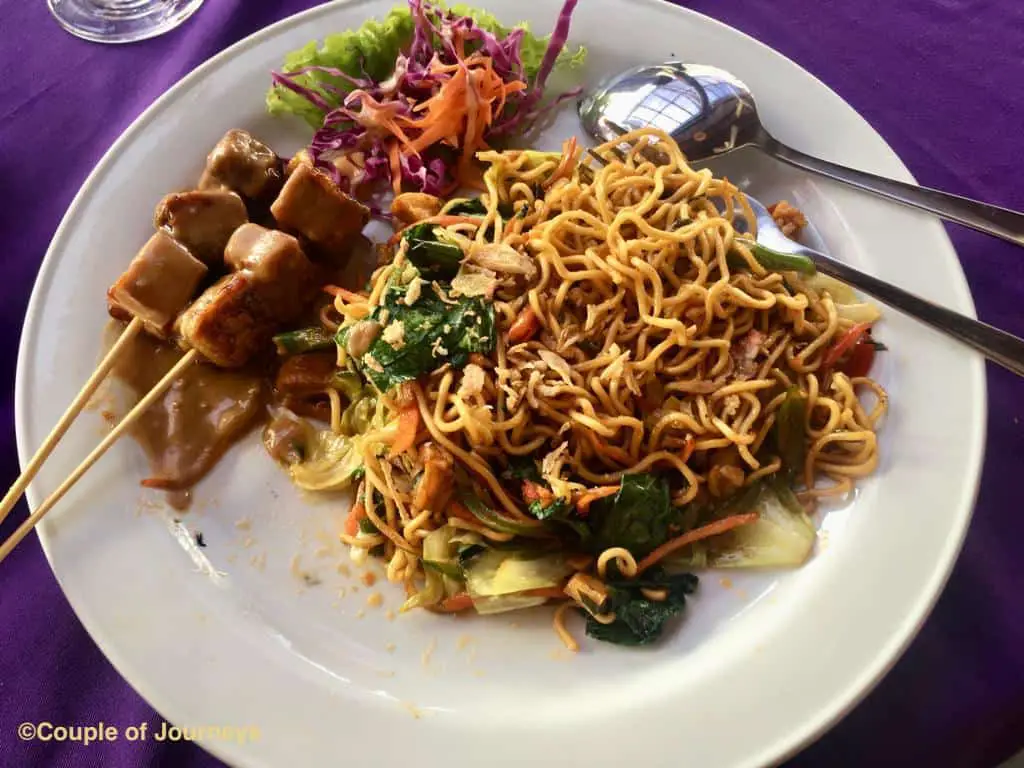
Vegetarian and vegan variants of rice, noodles, burgers, pizzas, pasta, salads, etc are found far more easily all across Bali. You won’t have to travel looking for vegetarian food places as almost all cafes, restaurants and beach-side shacks would serve vegetarian and vegan variants.
In Vietnam, the only vegetarian and vegan food options available in most restaurants and cafés would be steamed rice, rice paper, french fries, fruits, and salad. Many restaurants don’t serve vegan or vegetarian varieties of famous dishes like Banh Mi, Bun Cha, etc and you may have to specifically look for a restaurant serving vegan and vegetarian food using apps like Happy Cow.
Food in Vietnam is cheaper than in Bali.
Food in Bali is priced higher than in other Indonesian regions as it is the primary tourist destination in Indonesia. Vietnam, on the other hand, is not a tourist-centric economy and the food prices are very affordable.

Bali is a tourist destination and hence has quite a few hubs that stay open all night. Kuta, Seminyak, and Canggu have multiple bars and clubs. They are vibrant and full of life. Even the beach shacks at Kuta and Seminyak are bustling with spirited energy until well beyond midnight.
Vietnam, on the other hand, is not particularly famous for its nightlife. It does have a few pockets that turn into happening places like the Bia Hoi or the Beer Street in Hanoi, the Bui Vien Street in Ho Chi Minh City, or rooftop bars in other cities like Danang, etc. But other than that by 9 pm, most areas in Vietnam close for the day and turn into quiet, deserted areas.
Even the night markets set up in Hoi An, Hanoi and other parts of Vietnam close down by 11 pm.
History & Culture
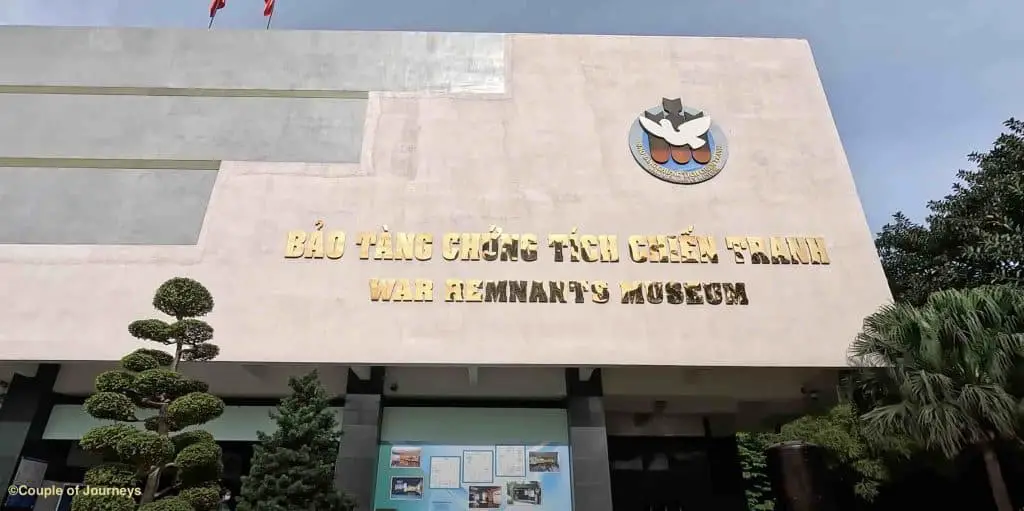
If you love visiting places that give you a peak into the place’s history, Vietnam has a lot to offer. Its history has seen Indian, Chinese, and Japanese influences. Vietnam was also a French colony and its present-day architecture reflects that abundantly. In the second half of the 20th century, Vietnam also fought the Vietnamese war against the Americans.
If you want to understand more of these influences, you can visit the Hoa Lo Prison Museum in Hanoi, the National Historical Museum in Hanoi, the My Son sanctuary near Hoi An, the beautiful town of Hue, the War Remnants Museum in Saigon, the many structures in the UNESCO World Heritage town of Hoi An, etc.
To orient yourself culturally, you can also visit the many pagodas, ancient homes and caves, and temples all across Vietnam.
In Bali on the other hand, you would mainly find Hindu temples. These temples are found all over the island and include the famous Uluwatu Temple in the south, the Besakih temple, the Tanah Lot temple, the Taman Ayun temple, etc.
In addition to these, you would be thrilled to see the beautiful bamboo arches outside the homes, the idols of various Gods placed at the entrance of all homes, the stories of Ramayana told through cultural shows, etc. But from a historic point of view, the offerings of Bali don’t compare with those of Vietnam.
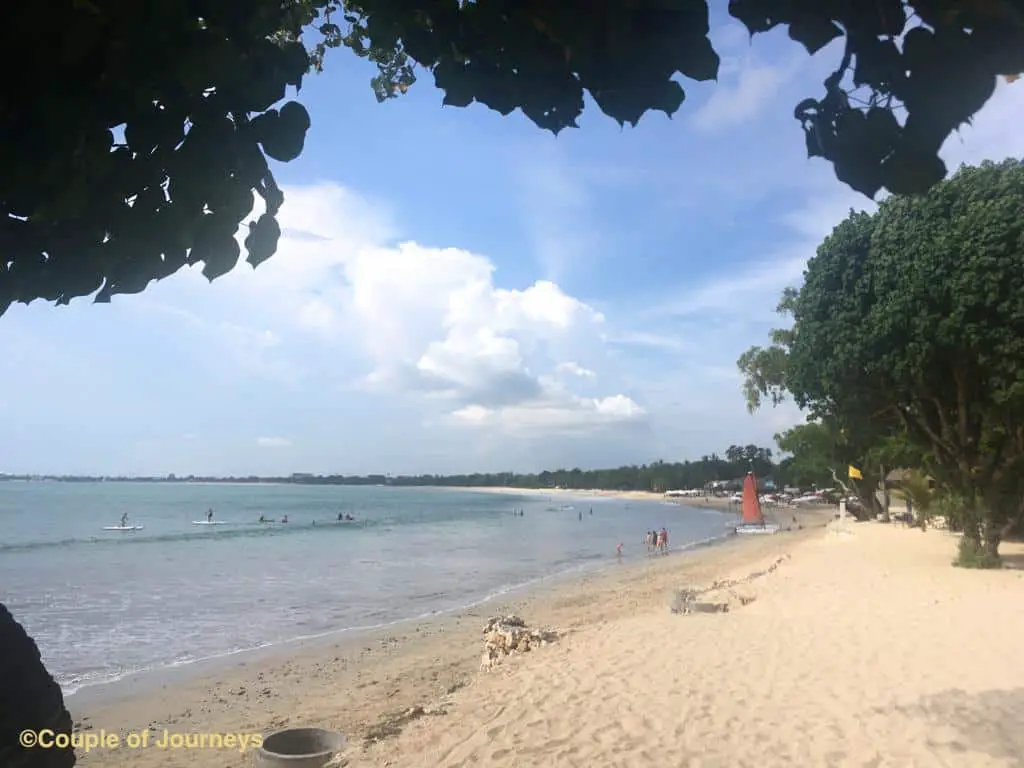
Bali beaches are famous all over the world. Being an island city, its coasts are home to all types of beaches. You can pick any based on your likes or dislikes
- For surfing go to Padang Padang or Kuta
- For partying try Seminyak
- For seafood choose Jimbaran
- For some sunbathing, get to Sanur
- For watersports head to Nusa Dua
In addition to this, there are also islands near Bali that you could visit in a day.
Vietnam, on the other hand, has a long coastline that runs all through the length of the country. But its beaches are not the most tourist-friendly all over. In the North, if you want to spend time at the sea, you can stay at Halong Bay – but that is more of a port town than a beach area. In Central Vietnam too, there are a few great beaches in Da Nang and near Hoi An or Nha Trang. For a more concentrated beach holiday, you may have to visit Phu Quoc island.
Thus, if you want a classic beach holiday, Bali would be a much better choice than Vietnam.
Tourist Attractions

Both places have some extraordinary tourist attractions. But if you are considering versatility alone, Vietnam enjoys an edge because of its rich history and cultural diversity. Its food is also a strong pull for tourists.
In Vietnam, attractions range from
- lakes e.g. Hoan Kiem lake
- temples and pagodas
- sanctuaries
- cultural shows and theatre
- farming trips
- manmade attractions like the Ba Na Hills with its French village and Golden Hand bridge
- old palaces and structures
- zoos, parks, amusements areas
- Cu Chi Tunnels
- Islands and beaches
- many types of boat rides like bamboo boat ride, basket boat ride, lantern boat ride, etc.
- food tours and café hopping
- shopping areas
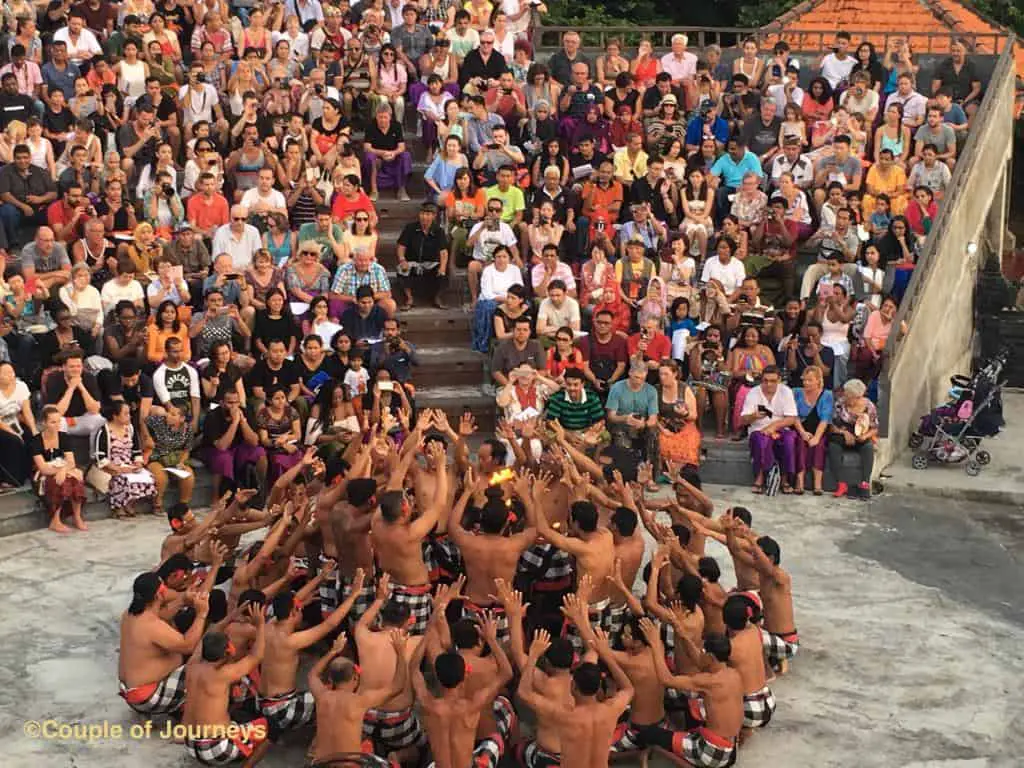
Bali, on the other hand, has
- temples and ancient homes
- volcano and mountain range
- rice fields
- boating and watersport activities
- island tours and adventure
- zoos, gardens, and waterparks
- cultural shows and theatres
- shopping and handicraft markets
If you’re a typical tourist who wants a lot more variety in your itinerary, go for Vietnam. If you want a chilled-out vacation with a good dose of natural and cultural attractions – opt for Bali.
Kid-friendliness

Bali is a tourist-centric destination and as a result, has many manmade attractions that can keep kids happy.
The Bali Bird Park, the Bali Zoo, the cultural shows at Garuda Kencana, or the fabulous waterpark Waterbom make for excellent outings with kids. The turtle beach or other beaches with watersport activities are also excellent sources of entertainment for kids.

Vietnam, however, doesn’t have much to keep young kids interested. There are zoos, gardens, malls, and parks in major cities but what they offer is not worth a visit on a short trip. Older kids interested in history and culture would learn a lot from visiting the many historical places, museums, etc.
We have visited both places with our daughter and I definitely think she had more fun in Bali. In Vietnam too, she enjoyed observing the cultural differences, discovering new food items, spending time on a cruise, etc. – but there was nothing specially crafted for her age group.
Couple-friendliness
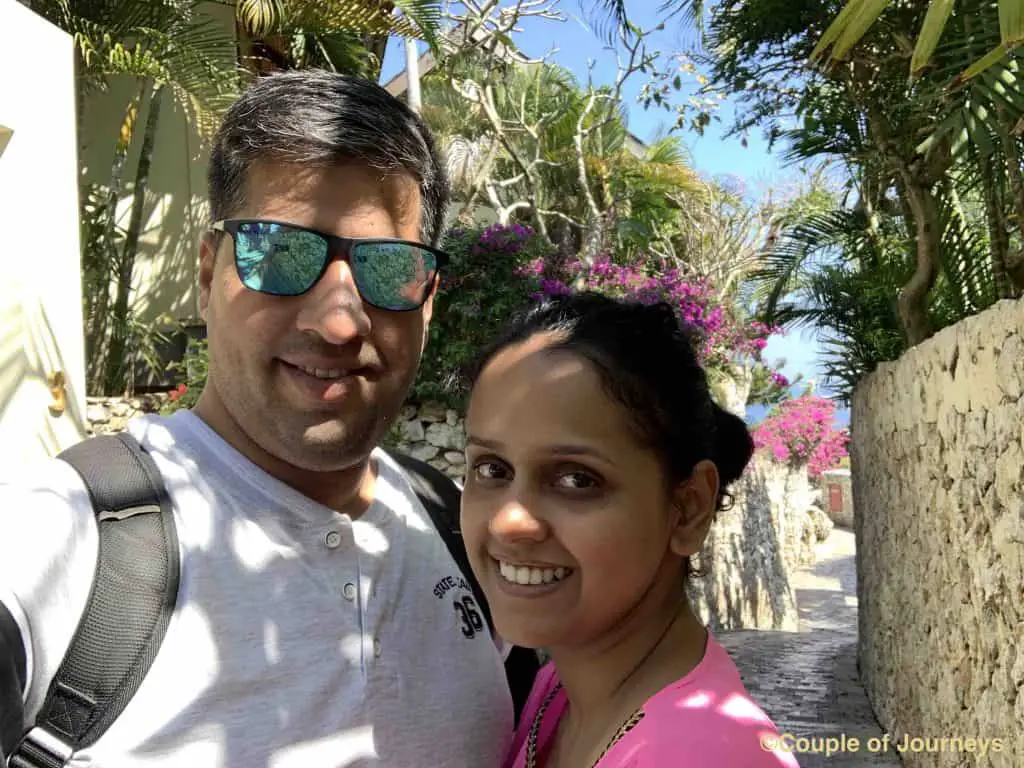
Want to decide between Bali and Vietnam for a romantic holiday? Bali definitely wins!
Bali has exotic beaches, prisitine mountain ranges, lush greenery and scenic beauty all across. Simply observing the beauty is enough to have a fulfilling holiday and you don’t necessarily need to pack your day with visits to various tourist attractions.
Vietnam, being a country, requires some city-hopping. The days are also jam-packed with visits to museums, temples, cruises, boat rides, etc. Visiting Vietnam and staying cocooned in one city would not feel as fulfilling as doing the same in Bali would.
Scams and Safety Concerns
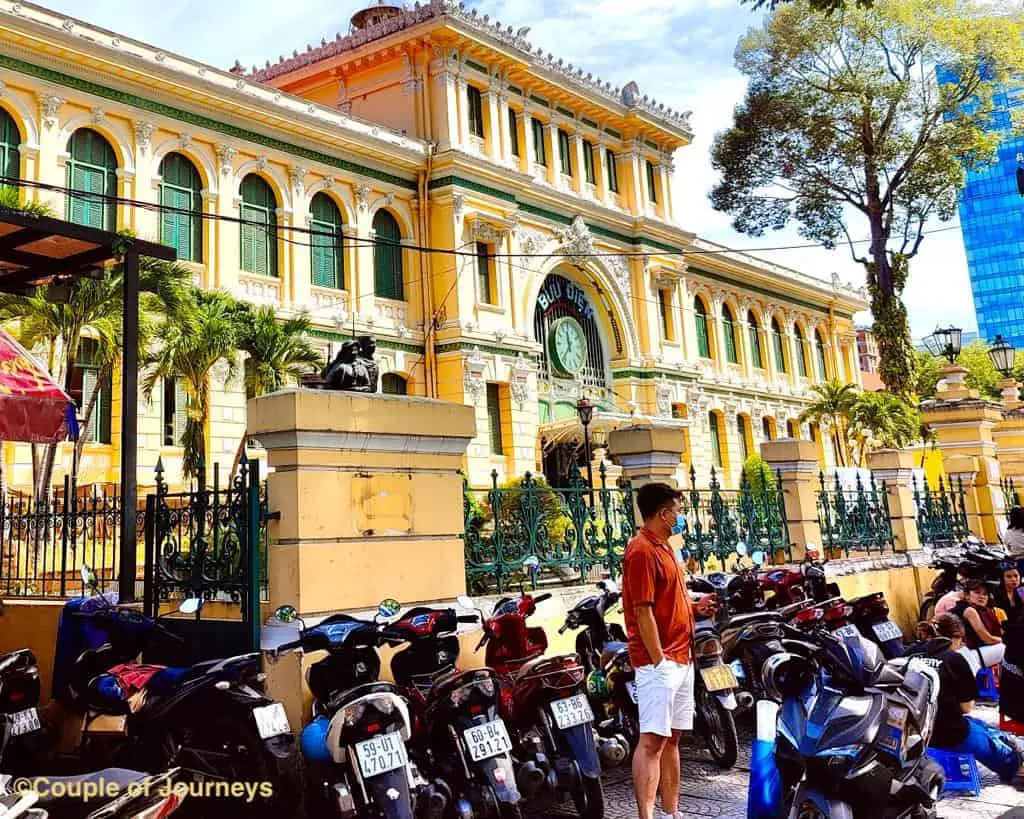
Vietnam is fairly safe but not without its many scams that you have to constantly avoid.
Some common scams to avoid in Vietnam are
- being given a lesser value similar currency note
- bike thefts
- showing you a more expensive tourist-only rate card or menu card
- cab drivers taking you from a longer route to charge you more
Bali, on the other hand, felt safe throughout. We had to bargain when shopping for souvenirs when booking cars when getting two-wheelers on rent etc – but that’s expected at any place. The intention of the locals was not to scam or rob us.
Read all our posts on Bali here
Read all our posts on Vietnam here
TOP TRAVEL RESOURCES
Here is a list of our favorite travel resources- the ones that I absolutely swear by when planning almost every trip. Go through this list to plan a hassle-free trip and save a lot of money!
Flight Booking: Check the availability of tickets, the best time to fly, and the cheapest fares on Skyscanner . You may also find a cheap flight via CheapOair
Accommodation: I absolutely love booking through Agoda . In most countries and particularly in Asia, I often find the best fares on Agoda. But I also love the no prepayment and no cancellation fee policy of Booking.com . For cheap accommodations and hostels, nothing beats Hostelworld .
Car Rentals: You may find and rent an appropriate car via RentalCars . It’s hassle-free and reliable.
Guided Tours: I absolutely love GetYourGuide for local sightseeing tours, walking tours, history tours, and food tours. The booking process is seamless, and the tours are super affordable. But in Asian countries, I prefer Viator or Klook for their affordably priced tours.
Lounge Access : Get Priority Pass – my personal favorite card that gives me unlimited access to premium airport lounges all over the world
Hey, if you found this post helpful, share it with more people or buy me a coffee !
Vrushali Ketkar is a lawyer turned travel blogger. She has travelled to 14 countries. She travels like a regular working woman with family. Her lawyer-level research skills make her a destination expert and help her get the most out of my trips. Today, her travel articles and videos help thousands of people across the world plan their trips to various parts of the world.
Similar Posts
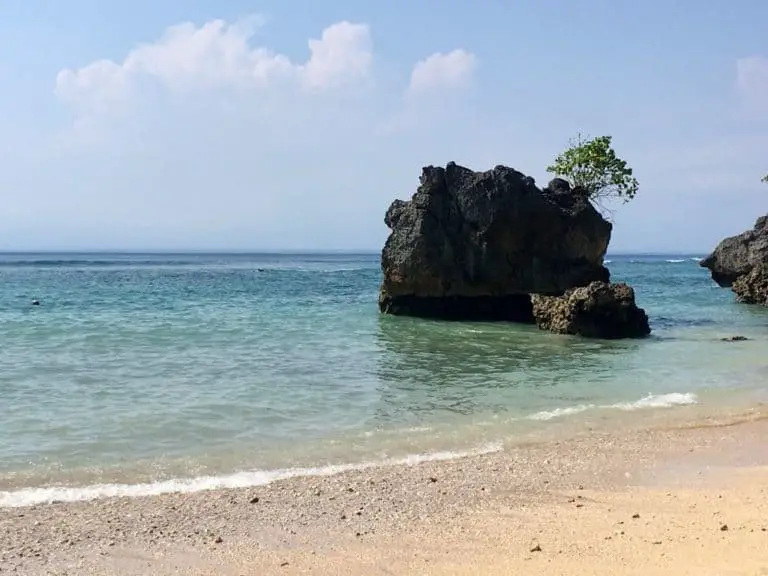
How many days are enough in Bali: Expert Views & Itineraries
As someone who has been to Bali a few times and has written a number of posts on Bali,…

Where to Stay in Bali for Couples: 7 Best Areas & 12 Stays
Have you been wondering About Where to Stay in Bali for Couples? Are you looking for the most romantic…
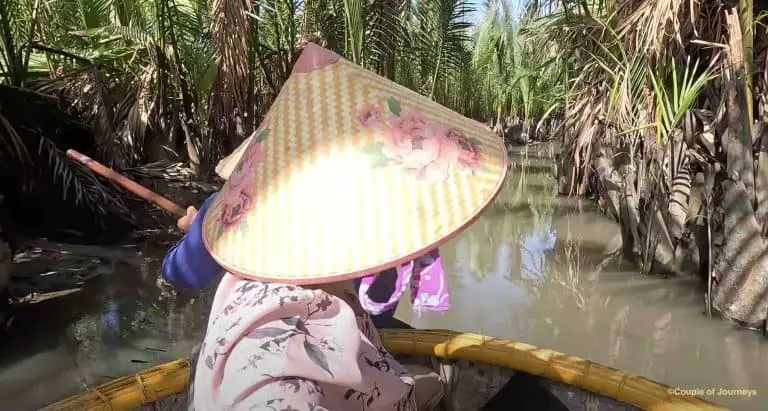
28 Free Must-Have Apps for Vietnam Travel 2023
Traveling to Vietnam soon? In this post, I am going to share with you a list of must-have apps…
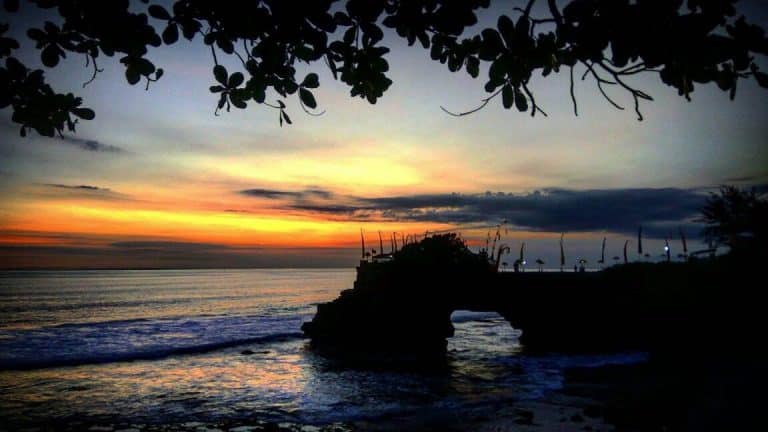
10 Days in Bali – Practical & Easy-to-Follow Along Itinerary
Want to spend 10 days in Bali? I’ve got you covered! In this detailed blog post on things to…
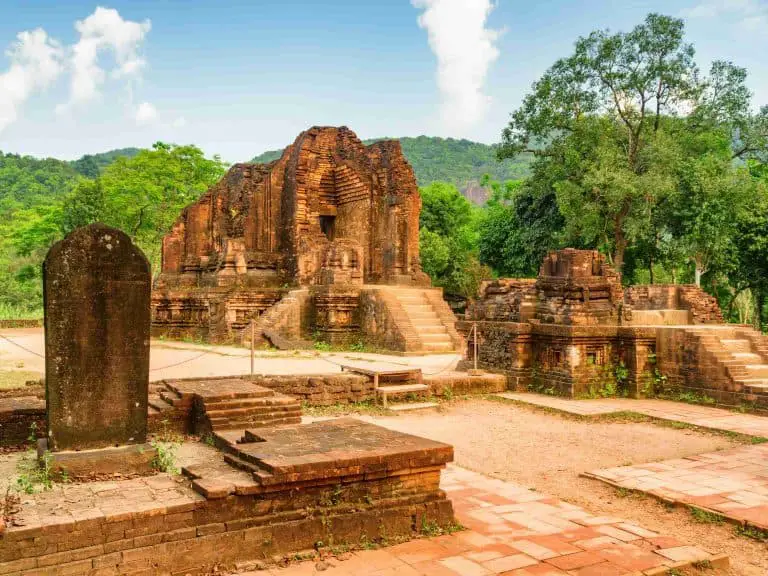
10 Best Day Trips From Hoi An: A Useful Guide 2023
Wondering which are the best day trips from Hoi An? I’ve got you covered! Hoi An was my favorite…
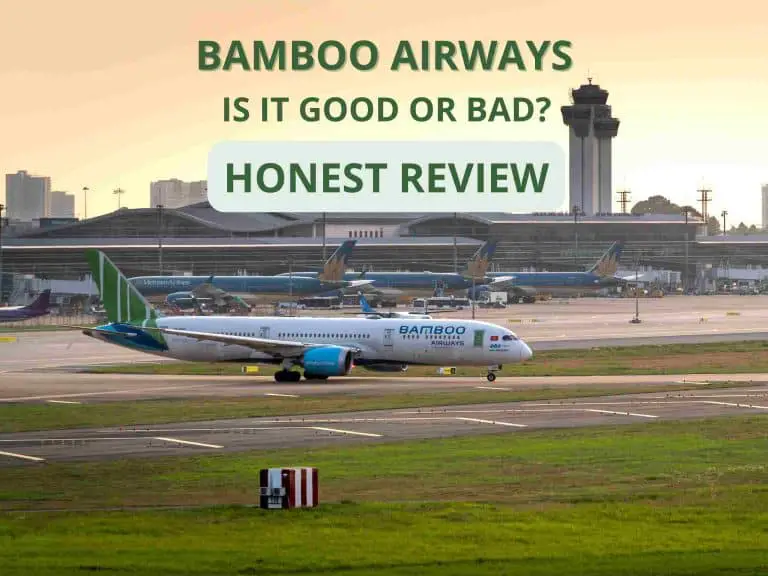
An Honest, in-depth Bamboo Airways Review: Is it worth It?
How good are Bamboo airways? Is Bamboo Airways safe? Is Bamboo Airways a budget airline? If you have booked…
North Vietnam vs South Vietnam: What's best for a 2-Week Vacation?
Are you wondering about the pros and cons of North Vietnam vs South Vietnam for your next vacation? We’ve got you covered with all the highlights of each region, including the amazing areas around the cities of Hano and Hoc Chi Minh City.
North Vietnam vs South Vietnam
With the huge growth of tourism in Southeast Asia, Vietnam is becoming a very popular vacation destination.
Vietnam has been on the backpacking map for a long time but only over the past few years have non-long-term traveller friends of ours started to ask our opinion on where in Vietnam they should visit if they only have 2 weeks in the country.
As a long-term backpacker, with all the time in the world, Vietnam is a very easy country to travel.
Not only is the tourist infrastructure well established, but the shape of the country makes it straightforward to get around.
Vietnam’s tall and thin body allows you to travel effortlessly from North to South or vice versa in almost a straight line, picking which of its many interesting sights, beaches, and cities you’d like to see along the way.
When booking a two-week trip to Vietnam the first thing to consider is which of the two main cities do you want to fly into.
The two main cities in Vietnam are Ho Chi Minh in the South and Hanoi in the North. Both Ho Chi Minh and Hanoi are great cities but you won’t want to spend much longer than 3 days in either if you have only a 2 week limit on your stay.
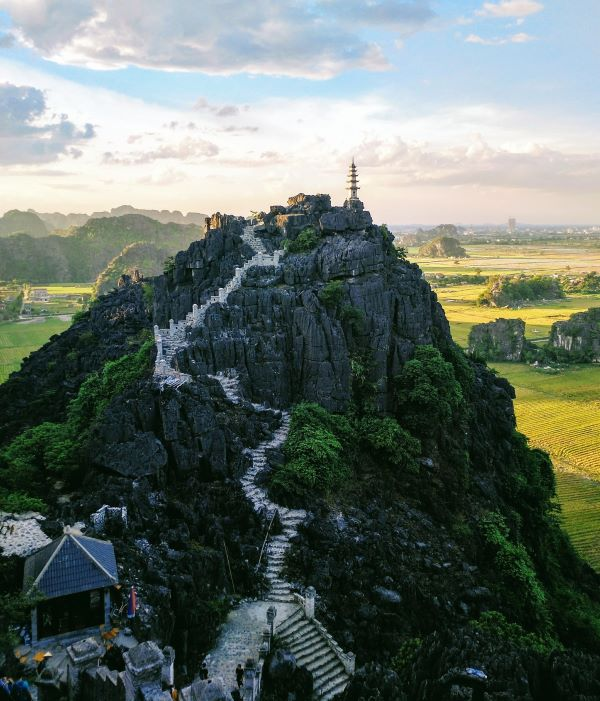
So to help you make that decision not only research those cities themselves but also find out what other Vietnamese destinations are within a comfortable distance for you to travel to.
Another important factor is when are you planning on going. The weather can change dramatically between the different regions as they have their own wet/dry/cool/hot seasons.
It pays to imagine the country as three separate destinations when researching the weather for your intended visit – north, central, and south.
In general, the best time to visit Vietnam is between November and April as these are the driest months across the country.
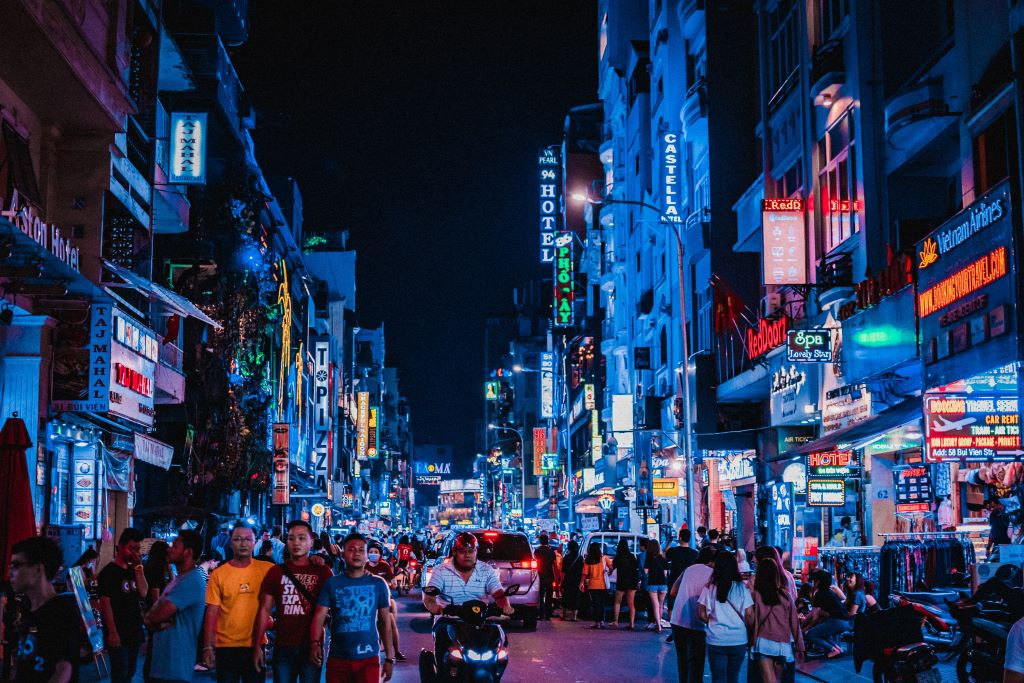
In general, the best time to visit Vietnam is between November and April as these are the driest months across the country. In general, the best time to visit Vietnam is between November and April as these are the driest months across the country.
But bear in mind that these are also the coolest months in the north if you’re looking for some warm weather to enjoy.
Temperatures in the south are almost consistently around 30 degrees Celsius year-round. Central Vietnam is mostly dry from January to August and wet for the rest of the year.
Temperatures around Central Vietnam can differ greatly at the same time of year due to the mountain ranges in the area.
And lastly, maybe Vietnam is part of a larger SE Asia trip such as a Vietnam Laos Cambodia Tour ? Depending on your route and which other countries you’re travelling to and from, this will dictate which part of Vietnam you’ll be entering.
So, get started by ordering your Vietnam visa , and let’s briefly compare the two cities.
Related reading: The Complete Guide to Booking and Riding Buses in Vietnam
South – Ho Chi Minh
Ho Chi Minh, or Saigon as some still call it, is Vietnam’s largest city and is the economic centre of the country.
With a population of 9 million it’s a busy place and with this comes heaps of traffic and pollution. But this is to be expected with any big Asian city so should not put you off.
The big draw card here is the many Vietnam War sites as this part of the country played a big role in the long and costly conflict between the North and South.
In the city itself, you’ll find The War Remnants Museum, which tells a very graphic version of the war through its many artifacts and photography galleries.
We also enjoyed exploring the city’s Reunification Palace which has been left almost untouched since April 1975 when the North Vietnamese forces took over.
Just outside the city, you can visit the Cu Chi tunnels, a fascinating network of narrow underground tunnels built by the Viet Cong in the 1960s to facilitate the control of a large rural area just outside the city.
Only a small number of tunnels are accessible now to tourists but at its peak, the network in the Cu Chi area alone had 250KM worth of muddy tunnels which housed kitchens, living areas, hospitals, and weapon factories!
One of our favourite city sights is Ben Thanh Market. Located in the lively city centre the covered market is everything you’d expect from a bustling Asian shopping and eating hub.
From local clothes piled high to souvenirs of all kinds but the highlight for us was the eating hall with a vast array of open kitchens cooking up every Vietnamese dish known to man.
Take a stall, grab a pair of chopsticks and tuck into some delicious local fare while you watch the locals go about their day and wide-eyed tourists taking in the sights and smells.
If bakeries are your thing, as it is ours, then Ho Chi Minh will have you smiling from ear to ear as you stuff your face with cakes, pastries, and baguettes in the city’s many French bakeries.
The Vietnamese have continued making these French delicacies since Vietnam gained independence from France in 1954.
In general Ho Chi Minh has a more Western feel with its wide city streets, high-rise buildings, and more modern Vietnamese population.
North – Hanoi
Hanoi, the Vietnamese capital, although not as large as its Southern rival is still pretty big with a population of 6.5 million.
Hanoi feels more Vietnamese and more authentic and the locals seem to be living a more traditional way of life compared to those in Ho Chi Minh.
With its abundance of French colonial architecture, the city is often referred to as the Paris of the Orient. We enjoyed wandering the old quarter, visiting the endless little shops and coffee houses.
Some of the streets are narrower and maze-like so hours can be spent meandering the pavement in search of your next noodle soup hit.
Hanoi does have its fair share of traffic and noise but it’s not as fast and furious as Ho Chi Minh. And even if it’s still too much for your liking Hanoi has plenty of green spaces to get away from it all.
Hanoi is a city of leafy boulevards, peaceful parks, and calm lakes. Hoan Kiem Lake is based in the historical centre and is a popular place for walks, picnics, and morning t’ai chi classes on the shore.
The lake also surrounds Ngoc Son Temple, isolated on an island that can be visited by tourists.
Hanoi also has plenty of museums and sights to satisfy history buffs. The most popular is the monumental, marble structure of Ho Chi Minh’s Mausoleum.
So many visitors go to see the frail, pale body of Ho Chi Minh that at times ques snake for 100s of meters!
We also enjoyed the excellent Vietnamese Women’s Museum which showcases women’s role in Vietnamese society and culture.
Other destinations to visit during your two-week vacation
So you’re done with Ho Chi Minh or Hanoi, you want to get out of the city and explore other places that aren’t too far away. Where would we recommend?
We could write a separate post on all of these destinations but for this post, we simply want to give you a brief overview of each to help with your decision.
If you’ve heard of other places that are not mentioned in this post then we either haven’t been there or we’ve been but would not recommend.
South – Mui Ne, Mekong Delta & Phu Quoc
Mui Ne is a long stretch of beautiful beach about 200 km to the east of Ho Chi Minh. Easily reached by one of Vietnam’s many bus services in about 4 hours.
Thankfully its coastline is lined with only low-rise beach resorts, most of which are set amongst pretty gardens and pools just off the sand.
Travellers of all budgets will find somewhere to stay here and the coast road running behind the resorts offers a string of restaurants, cafes, and bars to satisfy most tastes.
With big waves, Mui Ne is the adrenaline capital of the south as large numbers of surfers, windsurfers, and kiteboarders head here at seasons with high winds.
For something different take the coast road north until you reach Mui Ne’s enormous red and white sand dunes.
We opted to enjoy the Saharaesque landscape by plastic sled rented from some local children while others spoilt the peace and quiet riding dune buggies and quad bikes.
Mekong Delta
The Mekong Delta in southern Vietnam is a vast maze of rivers, swamps, and islands, home to floating markets, pagodas, and villages surrounded by rice paddies.
Boats are the main means of transportation, and tours of the region can start in Ho Chi Minh City but we opted to travel to and stay in Can Tho, a bustling town in the heart of the delta.
We recommend making the effort to stay at Can Tho so you are able to soak up the local Mekong Delta lifestyle rather than rush through it with herds of other tourists.
This also enabled us to find a cheap private tour guide that met us before light so we could watch the river come to life during sunrise while floating downstream on route to one of the famous Mekong floating markets.
Again Can Tho is easily reached by bus or taxi in about 4 hours from Ho Chi Minh.
Another Southern Vietnam highlight is the island of Phu Quoc.
Close to the border with Cambodia, the island can be reached by a short flight from Ho Chi Minh or a longer bus ride and boat for the more adventurous or budget-conscious.
Since we were already halfway there in Can Tho we chose the bus/boat mode of transport, then caught a flight back to Ho Chi Minh after our stay.
Unlike Thailand, Vietnam is not known for its tropical islands but Phu Quoc could easily rival any one of them.
Pristine white sand, calm waters, swaying palm trees, and beach huts are there for the taking and most tourists choose to enjoy all this along the main Long Beach which has the biggest choice of resorts.
The Long Beach crowds can easily be escaped by diving the island’s reefs, kayaking around its bays, or doing as we did and exploring the island’s more remote beaches and jungle backroads by moped.
North – Sapa, Halong Bay & Cat Ba
Sapa is a beautiful, remote, mountainous town close to the border with China. Although only 380 km from Hanoi the journey can take up to 9 hours due to the winding, slow mountain roads.
Most visitors reach Sapa by an overnight train from Hanoi which is a great experience in itself. Sleeper trains are much safer and more comfortable than taking the other option of a sleeper bus.
We’ve heard accidents are common on mountain roads so be careful.
Sapa, overlooking wonderful rice fields is a popular destination for trekkers as the Muong Hoa Valley offers plenty of walking trails and the option to climb the nearby 3143m tall Fan Si Pan Peak.
Although still home to local hill tribes, Sapa has seen a lot of tourism in recent years so it’s not unusual to see local women chasing tourists down the street in pursuit of a brightly coloured clothing sale.
It’s worth visiting some of the neighbouring villages where tourism has not had such a negative impact.
Some of these villages can be reached on foot so it’s a great excuse to head out and discover more of the stunning mountain scenery.
Halong Bay & Cat Ba
The UNESCO World Heritage Site, Halong Bay, is one of the most visited sites in all of Vietnam. The emerald waters graced with amazing towering limestone rock formations never fail to impress.
There are said to be around 2000 of these uninhabited islands!
Both mystical and magnificent the incredible feat of nature is, of course, best explored by boat using one of the many tour operators in the area.
Choose from a half-day cruise to a full-on overnight stay aboard a boat hotel. But choose carefully as with a lot of destinations on popular young backpacker routes, we’ve heard reports of some boats being all-night parties.
Most tourists choose to stay at Halong City, a busy tourist town where most cruises depart. Or you can do as we did and stay on Cat Ba island.
Cat Ba is the largest of the 367 islands spanning 260 km² that comprise the Cat Ba Archipelago, which makes up the southeastern edge of Ha Long Bay.
This part of the bay is much less frequented by Western tourists so it’s ideal for those travellers seeking something off the well-trodden tourist trail.
Cat Ba island itself is well worth exploring and can be done on foot. Many paths lead to some lovely little-coved beaches that were not crowded at all when we visited.
At 188 km from Hanoi, Ha Long Bay is another easy to get-to destination and should be a must-do if in Northern Vietnam.
Central Vietnam – Hoi An
Now we know this post is discussing North and South Vietnamese options but we cannot finish it without at least mentioning Hoi An which lies slap bang in the middle of Vietnam’s coastline.
Hoi An is our favourite Vietnamese destination and SHOULD be considered, even though it isn’t close to either of the two main cities.
If 2 weeks is your limit then an internal flight is the best option to get to Hoi An.
There is nowhere else in Vietnam like Hoi An. One of the only towns not destroyed by the Vietnam war, Hoi An is a picture postcard of how Vietnam used to be.
Silk lantern lit shop fronts, atmospheric markets, old yellow houses decorated in flower-filled vines, ancient temples, and fishermen hauling their catch of the day from their boats on the riverside.
Our favourite time of the day was at night when the town glows by candlelight from the many flickering lanterns on the streets and river. Adding a huge choice of restaurants, cafes, and bars Hoi An is a must.
Plus just a few kilometres outside of the town lies the breathtaking central coastline. Miles and miles of almost untouched white sandy beach.
We hired a bicycle and got there in just 30 minutes passing through local suburbs.
We walked along the shore for miles and aside from a couple of resorts, we found nothing but sea, sand, and traditional fishing boats. We guarantee it won’t stay like that for much longer.
North and South Vietnam
North Vietnam vs South Vietnam doesn’t have to be an “either/or” choice – you can always spend at least some time in both North and South Vietnam! Choosing which region of Vietnam is best for you should be based on your tastes and interests.
If you want lively hustle and bustle then head to Ho Chi Minh.
Prefer a more relaxed atmosphere then Hanoi is for you. Want to relax on a beach, we’d suggest the South.
If trekking is your thing, then head north.
But whatever region you choose, rest assured your visit to north or south Vietnam will be a rewarding one.
Related Posts

The 10 Best Day Trips from Chiang Mai

Best Things to Do In Chiang Mai At Night

The Georgetown Street Art Scene, Penang, Malaysia
Vietnam or Bali: Which Southeast Asian Destination is Better?

Bali – a paradise island filled with natural beauty as far as the eye can see. And Vietnam – a country bundled with history and character. One thing for sure is that deciding which Southeast Asian destination to visit is no easy task.
Bali has been luring millions of tourists yearly and for good reason. What is arguably Indonesia’s most popular destination boasts affordable lodgings, scenery to keep your jaw dropping constantly and some of the friendliest people you could meet. Oh, and not to mention it’s backpacker central, so there’s always a good party to be had if that’s your scene. Vietnam, however, is a country of variety. From the hustle and bustle of its capital, Hanoi, to the sheer silent beauty of Ha Long Bay, this extraordinary destination further north of Bali is also a must see.
But we get it, time and budget can’t always permit both. So, we’ve curated a handy little comparison of all the top vacation necessities to see which one comes out on top. Vietnam or Bali? Let’s go.
Table of Contents
Vietnam or Bali: Prices

Luckily, like most destinations in Southeast Asia, your money will go a long way in both Vietnam and Bali. But in Vietnam you can stay in some of the most luxurious five-star hotels for as little as $40. So, if there’s any place to test out how the other half live, Vietnam is the place to do this. You are looking at spending around $15 a day on food, of course depending on your eating habits. But the good news is that the street food here is almost even better than the highest quality restaurants.
So, how does this compare to Bali ? Well, the prices can get a little steeper here due to it being the epicenter of Indonesia tourism, however, we’re not talking steep by Western standards. You can find accommodation here for the super cheap price of $5 and that’s not just basic. How does waking up surrounded by lush greenery and views out to the iconic rice fields sound? And you can certainly get by on a daily budget of around $25 here. There are also plenty of excursions to enjoy for under $10, such as the highly recommended, Sacred Monkey Forest.
So, overall, both will allow for a pretty comfortable vacation that shouldn’t drain the bank account too much.
Winner: Vietnam
Vietnam or Bali: Things to do

Where to even begin with things to do in Vietnam – let’s just say it’s a country with much to offer any tourist. However, there are a few things that are a definite must on any Vietnam itinerary, starting with Hanoi’s Old Quarter. This maze of narrow streets, filled with food vendors, shops, cafes and bars, set to a background noise of motorbikes buzzing past is the epitome of Vietnam’s colorful character.
But for when you want to escape the hustle and bustle of the capital, there are several options, ranging from the awe-inspiring architecture of the Golden Bridge , also known as The Hands of God (two huge hands supporting a mountain top walkway), to the UNESCO World Heritage Site of Hoi An (a lantern covered ancient town). Or you could head further south to Vietnam’s largest city, Ho Chi Minh City or explore the country’s stunning islands by boat, we recommend the breathtaking Phu Quoc Island .
So how does Bali fare in comparison? Well, although Bali is much more concentrated in terms of size, you’d still be surprised at how much this island has to offer, besides soaking in the sun at some of the world’s most exotic beaches. A must see when you’re over in this part of the world is the spectacular, UNESCO World Heritage Site, Tegalalang Rice Terrace . These cascading emerald green fields, equipped with zip lines and jungle swings for the adventurous are one of the most photographed areas in all of Bali.
Or for the animal lovers , a trip to Sacred Monkey Forest and Bali Bird Park are not to missed. Other destinations you might want to tick off on the Bali checklist are Ubud (the cultural hub), Kuta (beach resort and party central) and Tanah Lot (temple situated on a rock in the sea and only around half an hour from the island’s capital, Denpasar).
Vietnam or Bali: Food

When it comes to Vietnam or Bali in the cuisine department, prepare for a very close call, as both destinations will leave you with an explosion of flavors on your taste buds. However, with Bali being an Island, many of its best dishes are sourced from the stunning surrounding waters. Some of the best grilled fish can be found on this idyllic hotspot.
So, while Bali may do the seafood a little better, Vietnam’s plethora of mouthwatering delicacies certainly keeps it in the game. Whether you’re tucking into a banh mi (baguette with a variety of fillings and plenty of coriander) for lunch, sipping on some pho (soup dish consisting of noodles, meat, and herbs) for dinner or grabbing a banh xeo (crispy pancake and street food favorite) on the go, you are guaranteed to be satisfied.
But when in Bali, eating like a local is a must, and there is no better way than to try some nasi goreng (fried rice, usually cooked with meat or vegetables and topped with a fried egg) and babi guling (stuffed pig, coated in a variety of spices). These are two of Bali’s most traditional dishes.
While Bali cuisine is influenced by other Asian nations such as China and India, Vietnam’s cuisine is heavily influenced by the French, however, one thing for sure is that both put their own stamp on dishes.
Winner: Draw
Vietnam or Bali: Beaches

So, while Bali certainly springs to mind as more of the dreamy island beach life, Vietnam’s less touristy beaches are equally stunning. Venture just a little further south from the capital and you will be blessed with the pristine white sands of Danang’s seaside offerings. Or for a more developed, traditional seaside resort, Nha Trang has plenty of sun, sea, and sand, with an abundance of eateries and shops nearby. But if a little seclusion is what you’re after, look no further than Bai Xep Beach, this little slice of peaceful heaven in a remote fishing village is the ultimate chillout spot.
But, with stunning tropical beaches often the poster choice of Bali advertising, it’s hard not to give the title to Bali in this one. Most of the best beaches can be found in the south of the island, around the areas of Kuta, Jimbaran, and Seminyak. However, don’t expect your own private spot around here, as Bali beaches can get rather crowded. But one look at the lush mountainous surroundings, dazzling turquoise waters and impeccably soft sand and you’ll understand why. Kuta Beach is generally where the party’s at (quite literally) and one of the most famous beaches in all of Indonesia. By day it is a haven for surfing, lounging, and soaking in the vacation buzz. After dark, it becomes nightlife central, with an abundance of bars and clubs on offer.
Winner: Bali
Vietnam or Bali: Nature

Vietnam or Bali for nature is definitely a tough one. On the one hand there is Vietnam with its epic forests, spectacular caves, and fascinating mountain ranges. On the other hand you have Bali, a treasure trove of stunning waterfalls, incredible rice fields and sublime volcanic landscape.
For any nature lover in Vietnam, there is a plethora of activities to enjoy, from kayaking down the limestone cliff surrounded wetlands of Ninh Binh, to trekking in the emerald-green heaven of Sa Pa, or quad biking in the vibrant red sand dunes of Mui Ne.
While Bali has less landmass than Vietnam, the nature that this relatively small island has to offer is equally impressive. You can climb Bali’s highest mountain, Mount Agung, which is also an active volcano, in around 6 hours, although you may want to enlist the help of a guide for the best routes. Or perhaps you want to explore some of the finest lotus ponds and endemic plant species housed in the Bali Botanic Garden. Or maybe take in the astounding power of the 50-meter high, NungNung Waterfall.
Whichever way you choose to enjoy nature, both destinations have stunning scenery in bucket loads.
Vietnam or Bali: Nightlife

So, if the idea of having a few wild nights on vacation floats your boat, where will you find the best party scene, Vietnam or Bali? Well, unlike its fellow backpacker favorite, Bali, Vietnam is not as known for its wild nightlife. However, that’s not to say there isn’t a decent number of places to let your hair down around here. From Bia Hoi, Hanoi’s quintessential nightlife spot to the rooftop bars of Ho Chi Minh City and Danang, or even partying on a boat that’s drifting in the stunning Ha Long Bay, there’s sure to be something to take your fancy.
However, with Bali being the spring break destination of choice for Australians, that’s got to tip the balance in its favor, as we all know the Aussie reputation for liking a bit of a party. And what’s an island destination without a few epic beach bars thrown in? Enjoy cocktails by the sea in the popular Potato Head Beach Club in Seminyak. This area, along with the other southern gems of Kuta and Canggu reign supreme when it comes to nightlife, with rows of bars and clubs to party the night away. After all, the party doesn’t even really get started until midnight in Bali.
Vietnam or Bali: History & Culture

And last but not least in our Vietnam or Bali battle, who will win in the history and culture department? Well, the fact that Vietnamese culture is one of the oldest in Southeast Asia certainly gives it an advantage.
With a history dating back thousands of years, this communist country has been occupied and divided by several nations. The French colonization in the 19th century can still be seen in much of the architecture today. Vietnam’s rich history can be found in the many museums dotted around the cities and there are several dedicated entirely to the Vietnam War (referred to as the American War in Vietnam), including the fascinating War Remnants Museum in Ho Chi Minh City, where you can see the equipment used during the war, as well as exhibits documenting different aspects of this brutal battle.
Bali, on the other hand is steeped in rich culture and religious tradition. It was once an important trading destination and much of the Hindu influence seen today is a result of early Indian traders.
There are many festivals held throughout the year, including one of their most important, Galungan, which marks a time when ancestral spirits return to earth. However, you don’t need to wait around for a festival for a bit of Balinese culture as it can be seen pretty much everywhere you go, from the art masterpieces to the traditional dance shows, as well as the many museums and sacred temples.
Vietnam or Bali: Conclusion
So, if you’re looking for a vacation in which to experience a bit of everything, including the hustle and bustle of city life, spectacular scenery, and cuisine to die for, Vietnam would probably be your best bet. However, if a more idyllic, concentrated setting, along with a great nightlife scene is what you’re craving, Bali may be more suited to what you’re looking for.
For more than 11 years, Joe has worked as a freelance travel writer. His writing and explorations have brought him to various locations, including the colonial towns of Mexico, the bustling chowks of Mumbai, and the majestic Southern Alps of New Zealand. When he's not crafting his next epic blog post on the top Greek islands or French ski resorts, he can often be found engaging in his top two hobbies of surfing and hiking.
Related posts

2 Days in Nusa Penida: The Ultimate Nusa Penida Itinerary
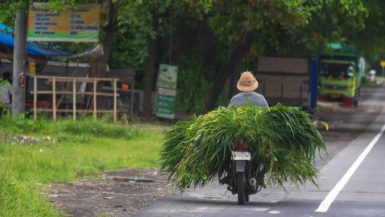
Bali to Jakarta by Land: Who Needs Planes?

Top 7 Healthy Food Places & Cafes in Canggu
- Search Please fill out this field.
- Manage Your Subscription
- Give a Gift Subscription
- Sweepstakes
- Travel Tips
The Best (and Worst) Times to Visit Vietnam, According to Experts
Here's when to visit Vietnam for sunny weather, lower prices, and excellent sightseeing.
:max_bytes(150000):strip_icc():format(webp)/SophieDodd-29f8105329084ddbafdf19974fa43b45.jpg)
Best Times to Visit for Smaller Crowds
Best times to visit for good weather, best times to visit for lower prices, best times to visit for hiking in sa pa, best times to visit for cruising ha long bay, worst times to visit.
Khoa Nguyen/Getty Images
Cinnamon and star anise perfume my memories of Vietnam, a country that lodged itself into my palate in fragrant, frenzied bursts. That alluring scent of pho was one of few constants as I traveled through vastly different landscapes, trekking through verdant rice terraces, dodging motorbikes en route to speakeasies, and standing face to face with an endangered monkey in my oceanfront outdoor shower — all within the span of two weeks.
Vietnam is more than 1,000 miles long, a spectacularly slim country that’s only 30 miles wide at its narrowest point. Every region boasts its own allure as well as its own climate, which means you’ll need to carefully consider the time of your visit based on your desired itinerary.
“As the climate varies so much from north to south, there will always be somewhere worth going in Vietnam, whatever time of year you travel,” says Melissa Matthews, regional director for Southeast Asia and North America at luxury travel company Red Savannah .
Here's a regional breakdown of the primary tourist seasons in Vietnam:
- High Seasons: North: September to November, March and April; Central: April to August; South: October to April
- Shoulder Seasons: North: December to February, May to August; Central: September to March; South: September to December
- Low Season: North: May to October; Central: September to May; South: May to September
Before you start planning your trip, read on to learn about the best times to visit Vietnam for hiking the majestic, mountainous rice terraces of Sa Pa, cruising the limestone marvels of Ha Long Bay, and avoiding the rainy monsoon season.
Bang The Tran/Getty Images
The high season in Vietnam varies according to the region, so you’ll always be able to find a place that feels more secluded from the bustle of crowded beaches or cruise ships. Wet season attracts fewer crowds, says Matthews, which falls from May to October in the north, September to May in the central part of the country, and May to September in the south.
Visiting during this time has plenty of perks, as you’ll likely be able to save on accommodations and travel costs. Popular restaurants and tours will be less overrun with tourists, offering a rare opportunity to better immerse yourself in the local culture as you tuck into bun cha on a sidewalk stool. However, bursts of rain and cloudy weather can dampen any plans to hike in Sa Pa or cruise along Ha Long Bay — two quintessential experiences you won’t want to miss.
There are also an abundance of places that remain less crowded throughout the year, says Benjamin Kreuz, general manager of Six Senses Ninh Van Bay — the resort itself is one of them, nestled in a private cove of Nha Trang that became my personal definition of paradise. Many visitors tend to prioritize other attractions as they make their way south, so natural wonders in the north like Ban Gioc Waterfall and the network of caves in Quang Binh remain less busy.
Meet the Expert
- Melissa Matthews is the regional director for Southeast Asia and North America at luxury travel company Red Savannah.
- Benjamin Kreuz is the general manager of Six Senses Ninh Van Bay in Vietnam.
No matter when you visit, you’ll always find good weather somewhere in Vietnam. “Vietnam is a beautiful country with tropical weather, making it suitable for visits throughout the year,” says Kreuz.
For those hoping to see Hanoi, Ho Chi Minh City, and everything in between, it’s best to go in the dry season. “February and March are the best months to see the entire country from north to south in relatively dry weather,” says Matthews. She notes that Tet, or Vietnamese Lunar New Year, falls during this time and can last for up to 10 days. “During this time, most of the key sights in the cities are closed, as everyone goes back to their family villages to celebrate,” she says. She recommends heading to the beach during the festival and bookending your trip with time in the major cities.
For a dry and temperate trip to Sa Pa or Hanoi in the north, head there from September to November, or in March and April, she suggests. A sunny beach visit to Hoi An or Nha Trang in the central region is best from April to August, while the Mekong Delta and Phu Quoc Island in the south are warmest from October to April.
Vietnam is a relatively affordable destination all year long, with abundant and economical street food and comfortable hotels for all budgets. For your best chance at scoring low-cost flights and accommodations, consider traveling outside the peak tourist season. April, May, October, and November are excellent times, as you’ll still find warm weather throughout the country, but will have fewer tourists to contend with.
Wand_Prapan/Getty Images
A visit to the verdant, terraced rice fields of Sa Pa are a must for nature lovers and outdoor enthusiasts alike. Overlooking the Muong Hoa Valley, the hills are surrounded by spectacular mountains and home to dozens of communities, including the Hmong and Red Dao peoples — many of whom open their homes for overnight stays and lead private or group trekking tours. You can reach this famed hiking destination by car from Hanoi in five hours, by a bus in six to eight hours, or on an overnight sleeper train.
Matthews notes that this region tends to get colder from December to February, so it’s best to plan a trip from September to November or in March and April. Harvest season is also an unforgettable time to visit: In late August through September, the vibrant green hillsides turn a voluptuous shade of gold as the rice ripens.
Nikada/Getty Images
Ha Long Bay, with its emerald waters and limestone towers, is one of the primary tourist destinations in Vietnam, and as such, has become increasingly overrun with cruise operators leading day tours. For a less crowded experience, consider booking an overnight cruise that will take you deeper into the bay — or to the equally beautiful, slightly less populated neighboring Lan Ha Bay. (I splurged for a two-night cruise with Orchid Cruises , one of the more luxurious tour operators).
March, April, October, and November are ideal months to visit, as they tend to bring warm and sunny weather without as much humidity. You’ll also avoid the peak season, so while it’s still bound to be busy, you can enjoy kayaking through the tranquil waters and hiking Cat Ba island in relative peace. The UNESCO World Heritage Site is also a great opportunity for a snorkeling or scuba diving adventure.
Nick Dolding/Getty Images
While Vietnam’s varied climate means there’s never really a bad time to visit, you may want to avoid traveling to the country during monsoon season.
“When the monsoon hits, it is hard and heavy and very humid,” says Matthews, who suggests sightseeing in cities during the wet season, where you can still visit museums and historic temples between rainstorms. “Avoid the mountainous region of Sa Pa and definitely don’t book a cruise in Ha Long Bay, as storms will occur and boats are grounded,” she warns.
If you do decide to travel during the rainy season, it’s best to remain flexible in your planning, says Kreuz. “Consider not booking everything in advance due to unpredictable weather,” he says, adding that staying open-minded may help you to take advantage of potential low-season discounts.
Tet, which marks the Vietnamese Lunar New Year, is another tricky time to visit, as many landmarks and businesses close for a week or more to celebrate. It typically lands in late January or early February — this year, it falls on Feb. 10.
- Travel Planning Guide
A Travel Comparison for Vacations, Honeymoons, and Tours Vietnam vs. Laos
Should you visit vietnam or laos, which country is cheaper, laos or vietnam.
Should I visit Vietnam or Laos? This is a popular question for many travelers. By figuring out which country is more expensive, you'll understand where you'll get more bang for your buck. A week in Laos can cost you about $104 (per person), while a week in Vietnam may cost you around $421. These differences become even more noticable if you plan to spend a longer time in the country. 10 days , two weeks , or even one month of travel to Laos or Vietnam can really add to your travel budget.
Accommodation is often cheaper in Laos compared to Vietnam ($5.85 vs. $27). Budget travelers usually stay in less expensive hostels and guest houses, while nicer hotels often appeal to families and upscale travelers.
Compare hotel prices here: Vietnam Hotel Prices and Laos Hotel Prices .
Or, compare hostel and guesthouse prices between Laos and Vietnam to find the cheapest accommodation here: Laos hostels and Vietnam hostels .
When comparing food in Vietnam vs. Laos they are not just different in cuisine, but also in price. Meal and restaurant costs in Vietnam ($14) are often cheaper than Laos ($5.69).
- Vietnam Prices Laos Prices
- Average Daily Cost Per person, per day Vietnam $ 60 Laos $ 15
- Accommodation Hotel or hostel for one person Vietnam $ 27 Laos $ 5.85
- Accommodation Typical double-occupancy room Vietnam $ 53 Laos $ 12
- Local Transportation Taxis, local buses, subway, etc. Vietnam $ 12 Laos $ 2.02
- Food Meals for one day Vietnam $ 14 Laos $ 5.69
- Entertainment Entrance tickets, shows, etc. Vietnam $ 13 Laos $ 2.70
- Alcohol Drinks for one day Vietnam $ 7.78 Laos $ 1.95
- Water Bottled water for one day Vietnam $ 1.33 Laos $ 0.42
How much are flights to Vietnam and Laos?
The price of a plane ticket may help you decide which country you should visit.
Find a Hostel in Vietnam or Laos
Hostels, guest houses, and locally owned B&B's are often the cheapest form of accommodation.
Related Articles for Vietnam
Related articles for laos, when is the best time to visit vietnam and laos.

Why is Vietnam more expensive than Laos?
What are the most expensive and cheapest cities and regions in vietnam and laos.

How you can save money when visiting Vietnam and Laos?
Subscribe to our newsletter.
By signing up for our email newsletter, you will receive occasional updates from us with sales and discounts from major travel companies , plus tips and advice from experienced budget travelers!

More Country Comparisons
For vietnam, pin this page.
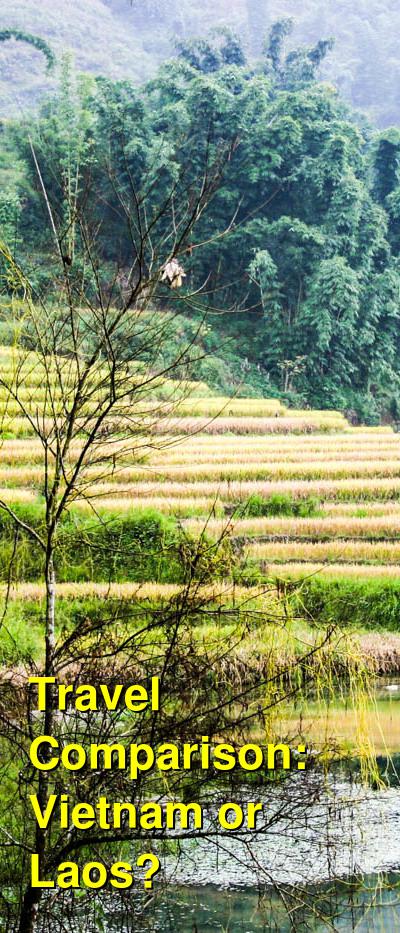
- Privacy / Terms of Use
- Activities, Day Trips, Things To Do, and Excursions

TRAVEL to VIETNAM – Tips and Information Guide (2024 Edition)
Everything you need to know about travel to Vietnam in our comprehensive 2024 Vietnam travel guide.
We get it. You’re wondering what the absolute best destination to travel in Southeast Asia is.
You’ve spent hours researching.
Talked to friends.
Scoured the internet for blogs.
Watched YouTube videos.
And you’ve finally realised something.
Without a doubt, Vietnam is the place for you.
And trust us, as a couple that have travelled the world for over a decade, we think you’ve made the right decision.
There’s a reason Vietnam is our all-time favourite country…
From the tropical coral reefs of Nha Trang to the northern mountains of Sa Pa, travel to Vietnam is one of the most adventurous yet culturally empowering experiences you can have.
One moment you will find yourself haggling for banh mi deep within Saigon and later that day you could be watching a breathtaking sunset from the Mekong Delta.
Vietnam is more than a country. It’s an experience.
You’ll find yourself immersed among street food vendors cooking up exotic cuisines such as pho along streets with stores selling suits and ties.
Or you’ll be cruising the waters of Halong Bay while monkeys jump from island to island.
Or you might find yourself trekking to the highest peak in Vietnam, Fansipan soaring to over 3,100 metres!
Not into adventure activities? Homestays are the perfect way to spend your day as the monsoon rains fall across the endless snaking rivers of the Mekong.
Vietnamese hospitality is unrivalled and is something that you should experience once in your life, so what are you waiting for? Say good morning Vietnam! And go get lost!
So we’ve convinced you to travel to Vietnam? Awesome!
Now check out the basic information about the country in our Vietnam travel guide.

25 BEST Things to Do in Hue, Vietnam (2024 Edition)
The perfect vietnam itinerary for 1, 2, or 3 weeks, canyoning in dalat – what it is really like, travelling in vietnam: at a glance.
Here are the basics about travel to Vietnam.
OTHER MAIN CITIES:
Ho Chi Minh City (Saigon), Da Nang, Hue
Vietnamese Dong (see current exchange rate ). 1USD approximately = 23,000 dong. 1 beer = 30,000 dong ($1.30USD)
ENTRY / VISA:
Travellers from most countries in the world are required to have visas. In most cases these can be obtained upon arrival for either 3 or 6 months. For information about your specific visa requirements click here.
Vietnam is fairly safe for travellers. Petty theft tends to be the biggest concern and always be on the lookout for taxi scams. Also of concern are minor auto/motorbike accidents. This is one place it’s great to have travel insurance when visiting.
ELECTRICITY:
220 Volt at 50Hz. Power plugs – Type A: 2 vertical pins, Type C: 2 round pins, Type F (also known as Schuko plug): 2 round pins (Be sure to get your universal travel adapter before you leave)
TRANSPORTATION:
Intercity travel is possible by plane, train and bus. Within cities, towns and villages you can expect to get around on bicycle rickshaws, motorbike taxes, taxis and bus.
Don’t Forget to Pack the Most Important Thing: Travel Insurance !
TOP 5 TRAVEL EXPERIENCES IN VIETNAM
With so much to see and do in Vietnam, it really is hard to pick the top experiences.
However, we think that to truly appreciate Vietnam you need to plan to do these 5 activities during your visit.
Take the Overnight Train from Hanoi to Sapa
Said to be one of the most eye-opening train rides in the world, as you pass through lush forests, rice paddy fields on your way to the Vietnamese – Chinese border.
Book your train ticket here .
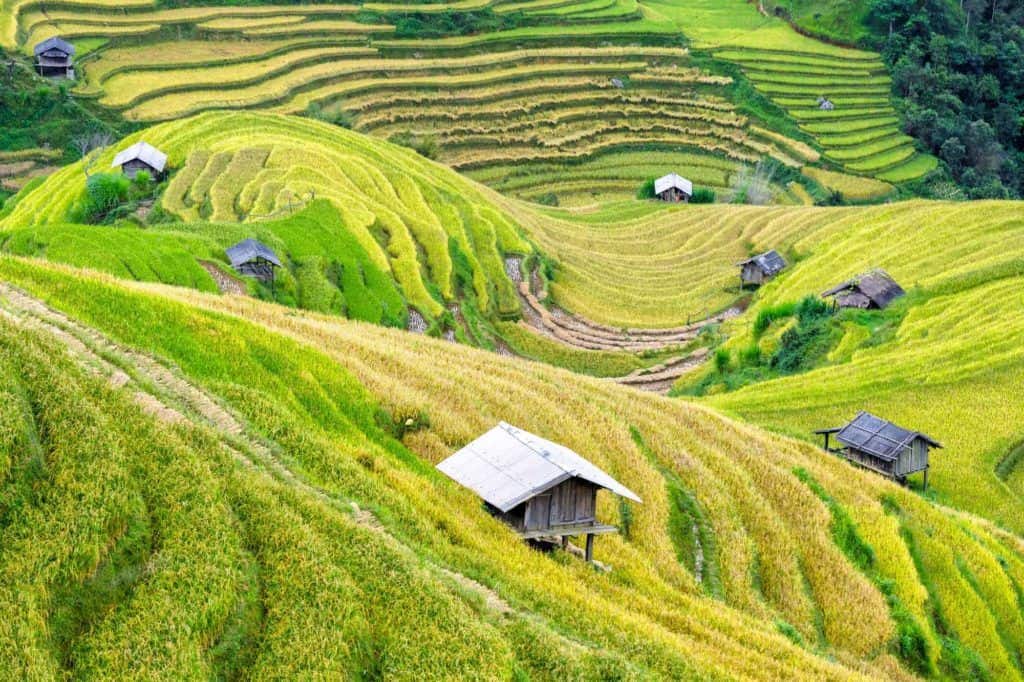
Hike Through the Rice Terraces of Sapa
Explore the area with the local hill tribes. Stay with them during your trek. And enjoy the beautiful terraced countryside for which Sapa is known.
Here’s our full post about trekking in Sapa .
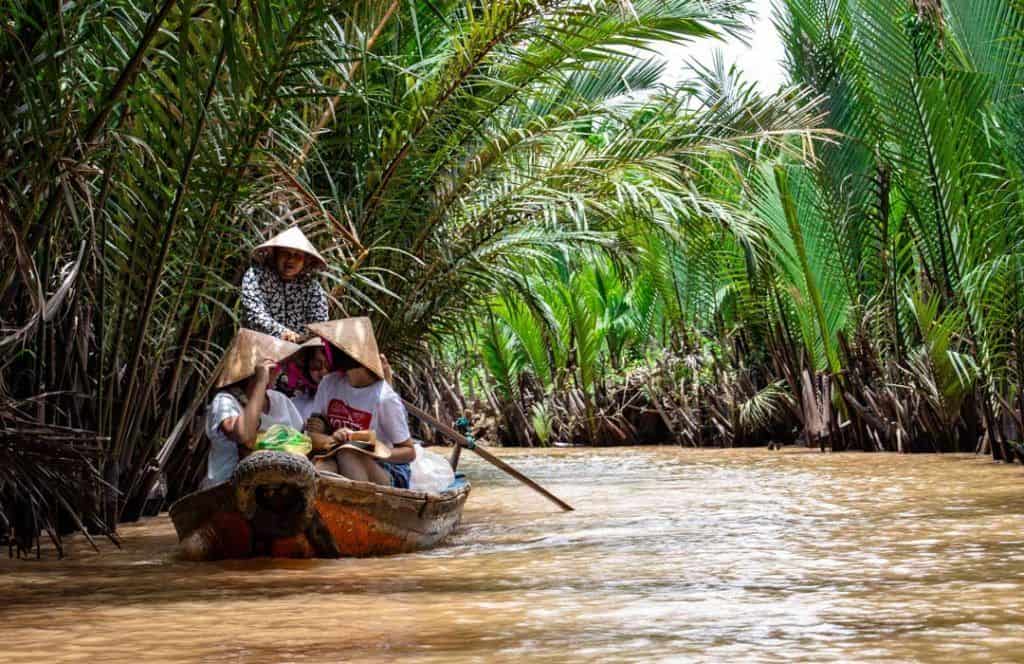
Cruise the Mekong Delta
Probably one of the ‘must do’s of Vietnam.’ The Mekong Delta is full of hidden gems including floating markets, friendly locals and late afternoon storms.
Book a multiday tour of the Mekong Delta
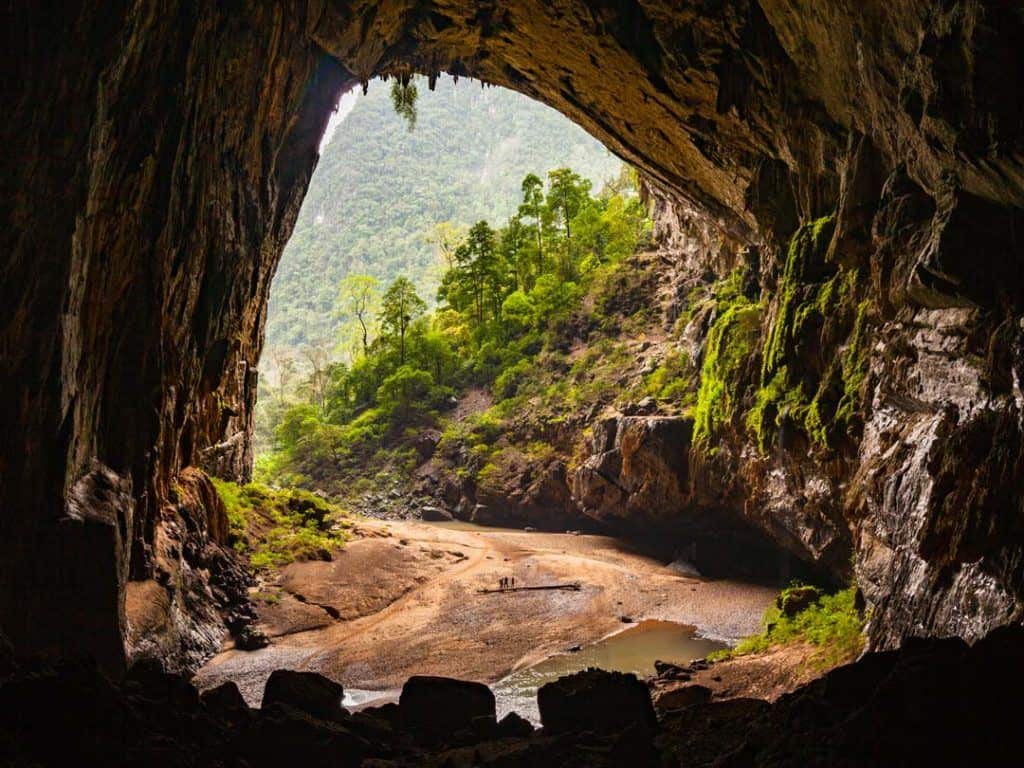
Go Caving in Phong Nha
Caves there can fit a 747 plane in it. They are massive and spectacular. This is an adventure you will never forget.
Book your Phong Nha cave tour
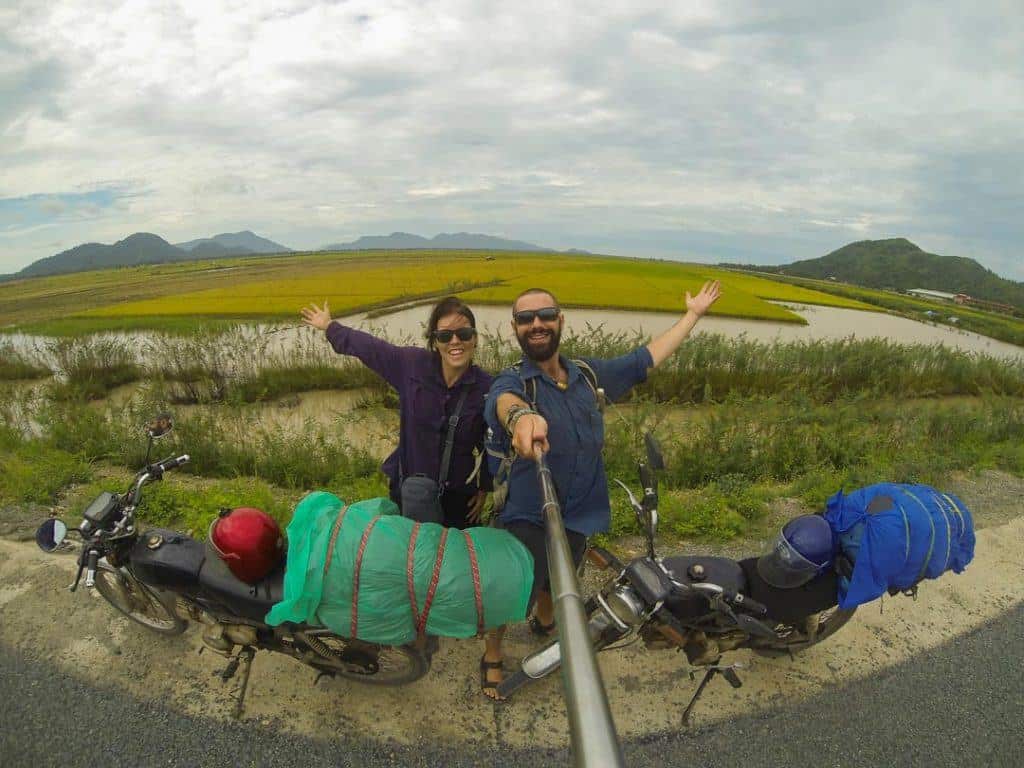
Ride a Motorcycle
Yes, that’s right! Hiring a motorcycle or scooter is a must. But maybe do it out on the country roads. Opt for the famous ride to the mountain village of Dalat, or pretty much anywhere throughout the country.
Read about how to ride through the famous Hai Van Pass
Other Things to do in Vietnam
Learn to cook Vietnamese food . Eating delicious Vietnamese food is one thing. Eating it after you’ve learned to prepare it is another!
Scuba dive in Nha Trang. You may not think of Vietnam as a big scuba location, but there is some great diving to be had in Nha Trang.
Go canyoning in Dalat. Rappel, slide, jump and climb your way through canyons in this gorgeous place!
Explore the Marble Mountains in Da Nang. These beautiful mountains have been mined for marble for years and have incredible views and temples to visit along the way.
Sandboard down the sand dunes in Mui Ne. It’s like snowboarding, but down massive sand dunes! Enjoy this rush!
Visit the Giants Causeway in Ghan Da Dia. Half the world away from the Giant’s Causeway in Northern Ireland, be amazed at this unique geologic structure .
Visit the Cu Chi Tunnels outside of Ho Chi Minh City. No trip to HCMC is complete without touring these historic tunnels that were used during the war.
Conquer the Hoi An Pass on a motorbike . This is known as one of the most beautiful sections of highway in the world. Enjoy!
Explore the world’s biggest cave . We have a special connection with Hang Son Doong as it is where we were engaged. Make your own special moment too!
Climb the highest mountain in Indochina in Sapa. Fansipan is over 3,000m above sea level and offers incredible views along the way to the top!
BE SURE TO CHECK OUT THESE OTHER AMAZING THINGS TO DO IN VIETNAM
READ MORE...
A First-Timer’s Guide to Trekking in Sapa
The 11 Best Things to Do in Da Nang, Vietnam (2024 Guide)
33 BEST Things to Do in Vietnam (Epic 2024 Guide)
10 BEST Things to Do in Ninh Binh, Vietnam (2024 Guide)
Scuba Diving In Nha Trang – Is It Worth It?
BEST PLACES TO VISIT IN VIETNAM
There are plenty of amazing places to visit in Vietnam. Depending on your interests, trip duration and time of year you will find plenty of things to do during any length of stay.
When slurping a bowl of pho in a local market or exploring an ancient temple, it’s easy to feel like you’ve stepped into a time machine in Ho Chi Minh City.
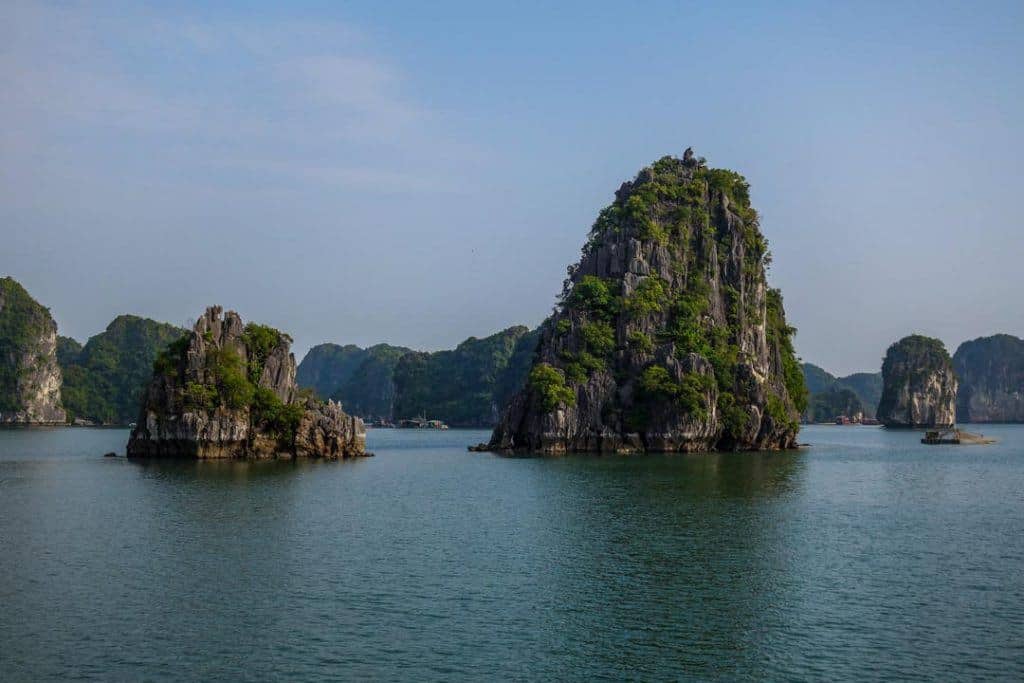
A collection of over 3,000 limestone islands providing endless kayaking opportunities. Take the time to relax aboard a boat or venture to Cat Ba National Park for mystical waterfalls!
Book your tour of Halong Bay
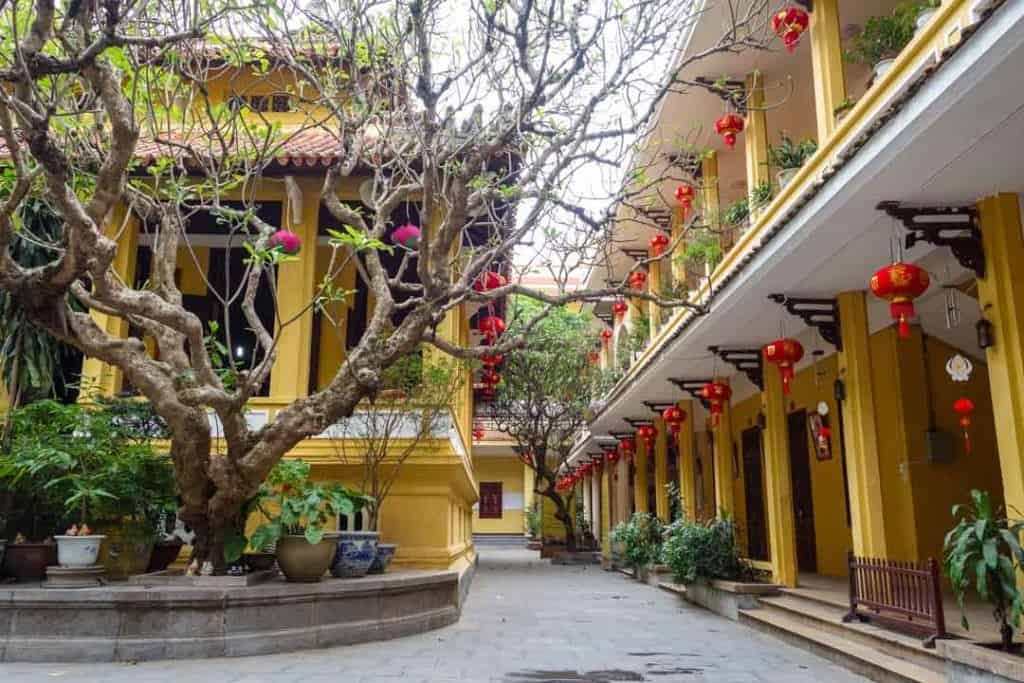
The capital of Vietnam is also one of the most ancient capitals in the world. The history of Hanoi is rich, devastating and full of legends. This mystical city is also known for its cuisine, silk, buzzing nightlife as well as cultural diversity.
Plan your 3-day Hanoi itinerary
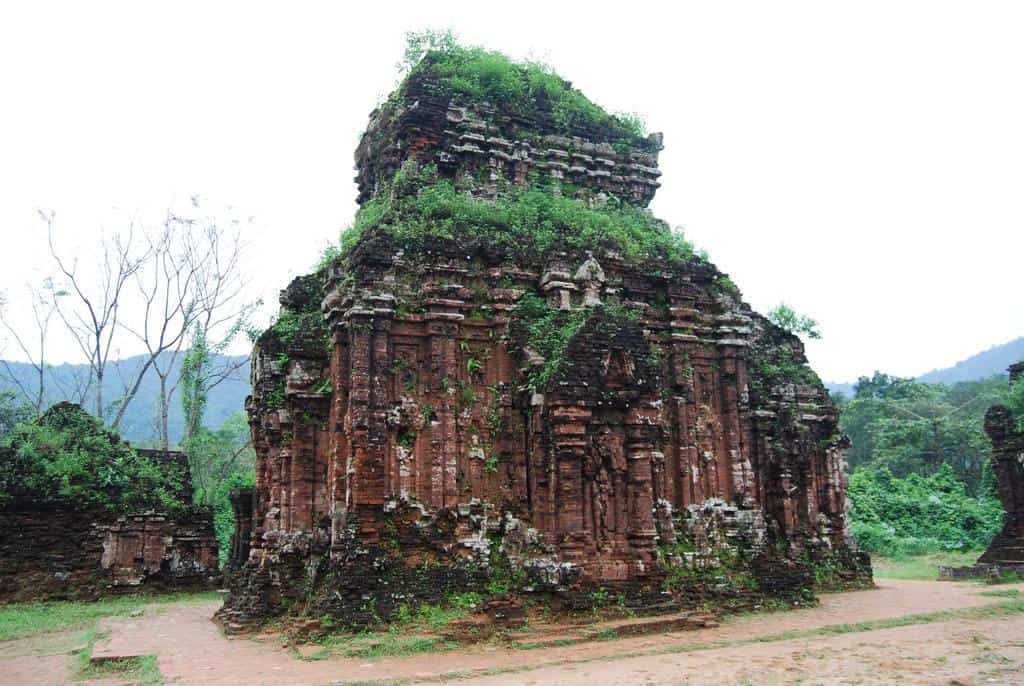
My Son Temple
Ancient temples dating back 1,000 years give a culture understanding into Vietnam’s past all while showing the scars of the war.
Book an early morning tour of My Son
For more information on specific things to do in the top places to visit in Vietnam, reference our following city travel guides:
Ho Chi Minh City:
* Ho Chi Minh City Itinerary * Day Trips from Ho Chi Minh City
* Hanoi Itinerary * Day Trips From Hanoi
Dalat Hoi An
Da Nang Hue Ninh Binh
BE SURE TO CHECK OUT THESE OTHER AWESOME PLACES TO VISIT IN VIETNAM.
BEST VIETNAM TRAVEL ITINERARY
We’ve put together a few Vietnam itineraries that are sure to leave you wanting for nothing at the end of your visit.
There are so many amazing things to do in Vietnam that planning an itinerary for your travel can be a little overwhelming.
Even though the country is one united nation, you can think of it geographically as being divided into a northern and southern region.
So depending on how much time you have, you may want to explore the northern region, southern region or the entire country.
Of course, no one-size-fits-all plan will suffice. But if we were to head back to Vietnam these are the top places and things that we would want to do!
1-Week Vietnam Travel Itinerary Highlights
Most people spend at least a month went hey travel to Vietnam. But if you had just one week, or were willing to split a few weeks between the northern and southern regions, this is how we’d spend our time!
Northern Vietnam
- Fly into Hanoi
- 2 nights – Hanoi
- 2 nights – Halong Bay or Bai Tu Long Bay
- 2 nights – Sapa
- Alternative to Sapa – 2 night in Hue
- Fly out of Hanoi
Central Vietnam
- Fly into Hanoi or HCMC. Get a local flight down to Dong Hoi
- 3 nights – Phong Nha
- 2 nights – Hue
- 2-3 nights – Hoi An
- Fly out of Da Nang to either Hanoi or HCMC to leave
South Vietnam
- Fly into Ho Chi Minh City
- 2 nights – Ho Chi Minh City
- 2 nights – Mekong Delta
- 2 nights – Dalat
- 1 night – Mui Ne
- Fly out of Ho Chi Minh City
READ MORE: Check out this post for more details on our Vietnam travel itinerary .
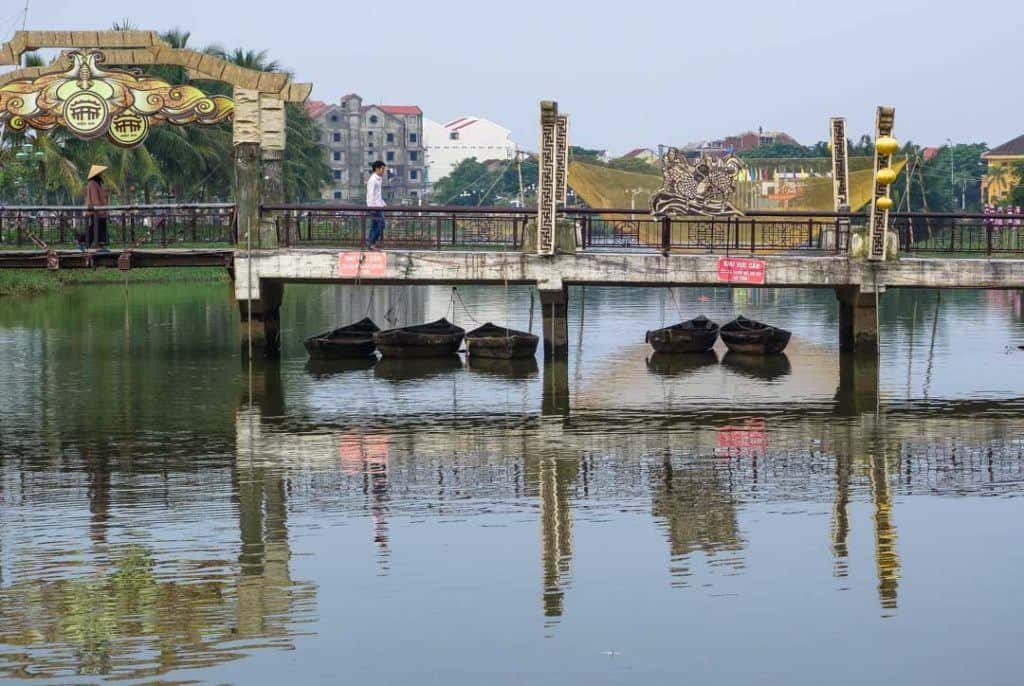
VIETNAM TRIP PLANNING
Best time to visit vietnam.
The best time to travel to Vietnam really depends on what you are looking for in terms of weather, scenery and budget.
Peak season occurs from mid-December through to February. But expect prices to double during this time. The low season is perfect for those on a budget.
- Low Season – April to June, September to November
- Shoulder Season – December to March
- High Season – July & August
Northern Vietnam – The best months to travel Northern Vietnam are April to May or September to October. There are mostly sunny days and the rain has stopped.
The weather gets really cold from December to March and is not suited for hiking or sailing a junk boat in Halong Bay that time of year.
Central Vietnam – The best months for travel to Central Vietnam are January to June. There are heavy rains in October and November and the really hot months are from May to August.
Southern Vietnam – The best months to explore Southern Vietnam are January to April where conditions are beautiful.
You really can travel the south at any time of the year. Just note that from May to November there are afternoon downpours.
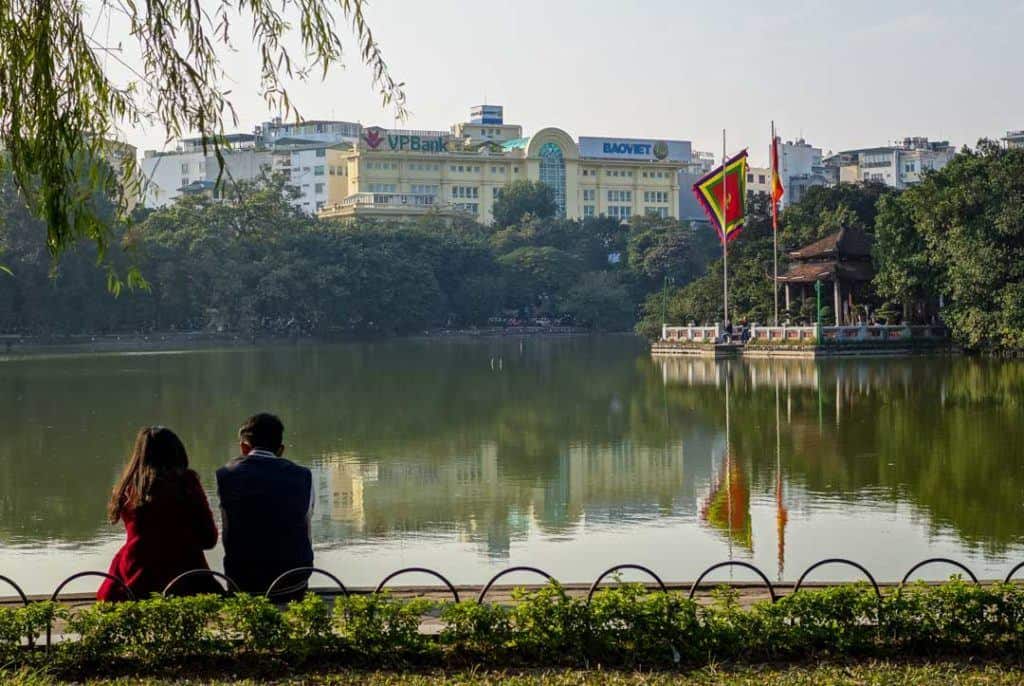
VIETNAM TRAVEL BUDGET GUIDELINE
Vietnam is a cheap country to travel if you want it to be, this all depends on what your budget is like. Our advice is always over-budget when making plans, and if you come home with money, it can go towards your next trip. All prices below are in USD per day.
Budgeting Tips
To make your money go further here are a few tips:
- Eat street food as often as possible. You can usually fill up for $1-2USD.
- Travel in groups when possible. Staying in hostels will lead to making friends. And with friends, you can split transportation costs and barter on other expenses.
- Negotiate taxi fares before taking the ride. Vietnamese taxi drivers are notorious for flexible fares that tend to fall int heir favor. Don’t be afraid of a little negotiation.
- Drink bia hoi . Sure it’s not the more delightful beer. But it is shipped in fresh each day, it’s cheap and it’s what the local drink.
- Take in the sights for free. Do a little research and walk the streets on your own. You’ll also find there are a number of free tours and other opportunities if you ask around.
- Sleep on overnight busses for longer trips. Combine the transportation and accommodation line items of your budget and save a few dollars.
But there are a few things you should know about the different budgets at which you can choose to travel.
Note: Budgets shown as Single Traveller / Couples per day.
Budget Traveller ($35 Single / $50 Couples)
If you are on a backpacker budget and planning on staying in dorm rooms, getting street food, drinking a few nights of the week, I would budget for about $35 a day.
A single hostel bed can be $5-$8 per person. A budget basic private room is $15-$20. A street food meal can be $1-$2. A bottle of beer is about $1- $1.50 and a bia hoi is $0.20 per cup. This is not the nicest beer. But it is passable and you get to make new friends when drinking it.
Walking or taking public transport will keep your budget down. There are many free things to do, you just need to think outside the box.
Mid-Range Traveller ($100 Single / $120 Couple)
If you have a little more cash in your budget your travels in Vietnam will become a lot more comfortable.
A nicer hotel is definitely affordable.
There are restaurants where you will pay more than the street food price. But the food is definitely of nicer quality (most of the time). The local beer can get a little too much sometimes so you will be able to enjoy an international beer or wine.
For the attractions you are most interested in, get a guide and learn more about the history of the country. You’ll be able to commit much more of your budget to do things rather than cutting corners just to stay alive.
Luxury Traveller ($90+ Single / $120+ Couple)
You don’t have to have that much more to enjoy a luxury trip to Vietnam. With a few more dollars in your budget, a nicer hotel is definitely affordable. Eat and drink anything you would like at virtually any restaurant.
You can hire transportation without having to haggle. And you can pretty much do any tour you would like to do when visiting any part of Vietnam.
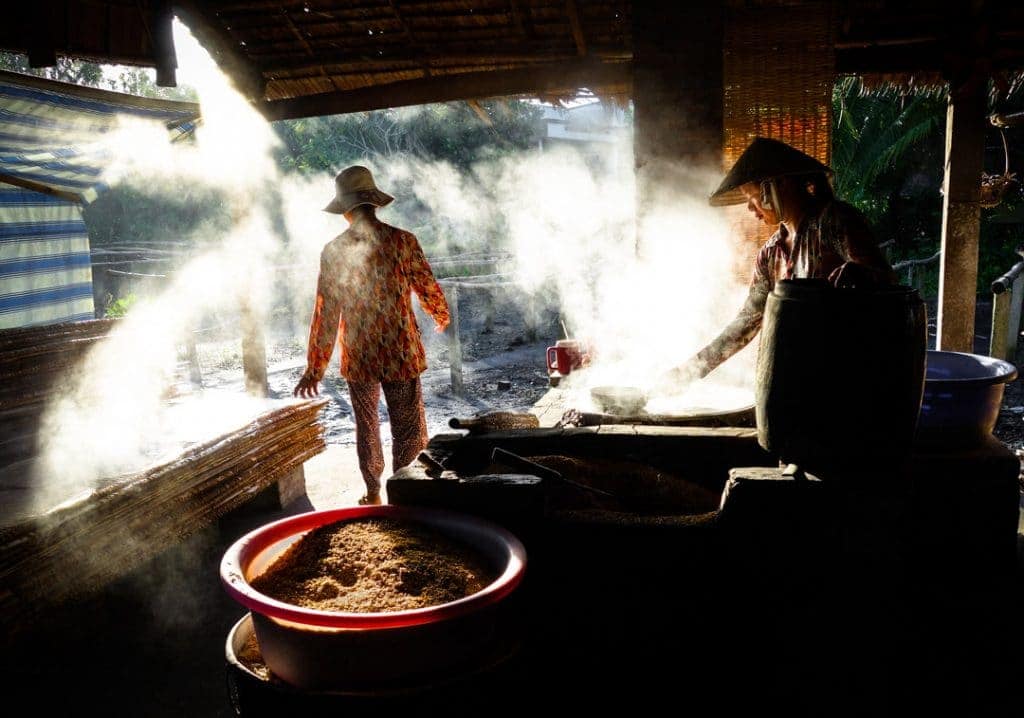
GETTING TO AND AROUND VIETNAM
Entry requirements.
Most travellers are required to have visas when travelling to Vietnam, which can typically be arranged upon arrival. You are typically allowed to stay for 3 – 6 months, depending on nationality.
For information about your specific visa requirements click here
Additionally, Vietnam has introduced an electronic visa (e-visa), which costs $25 USD and is granted for single entry visits for up to 30 days.
You no longer will have to apply through an agent to get an invitation letter or queue at the airport immigration for hours waiting to receive your visa upon arrival.
Apply in advance here .
Once you are approved, all you need to do is print the visa out and present it on entry to Vietnam. Don’t lose this e- visa print out as you will need this during your travels in Vietnam.
Hotels will ask for it on check-in at the accommodation and travel agents may ask for it if you are booking flights.
Also, print out your travel insurance as well. Immigration will ask for this also as they want to know you are covered if you fall ill or get injured during your stay.
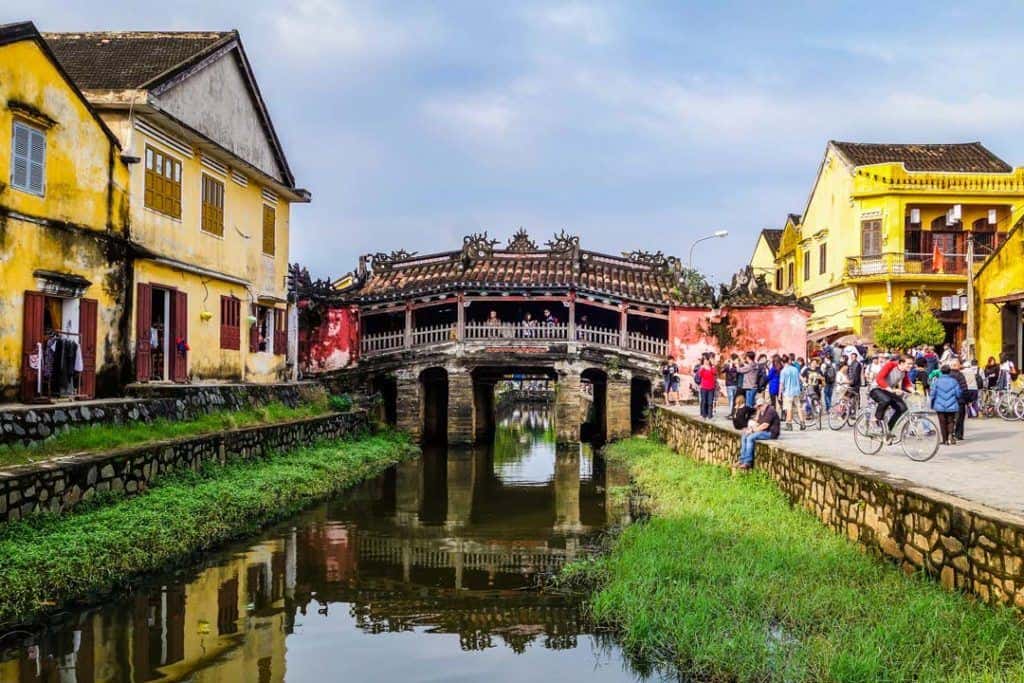
Getting to Vietnam
There are a number of different ways to travel to Vietnam, depending on where you are coming from and how you like to get around with transport.
There are a lot of different airlines that fly to Vietnam from all over the world. There are two major international airports in Vietnam: Tan Son Nhat Airport (SGN) in Ho Chi Minh City in the south and Noi Bai Airpot (HAN) in Hanoi in the north.
Direct flights to Vietnam from Australia, Europe and North America are still limited, but it is improving. You will most likely have to book a flight with a stopover in either Hong Kong, Bangkok, Kuala Lumpur, Seoul or Singapore.
There are many domestic airports scattered among the country. Vietnam Airlines is Vietnam’s national carrier. We have flown with them several times and they are amazing.
You can cross into Vietnam by train from China, all the way from Beijing to Ping Xian. This is the Dong Dang Crossing which is 160km from Hanoi.
After you have crossed the border hop on a train to Hanoi. Don’t buy the direct ticket from Beijing to Hanoi. It works out cheaper to buy your ticket from Beijing to Ping Xian then cross the border and purchase another ticket from Dong Dang to Hanoi.
If you do the train trip from Beijing through to Hanoi, it will take 36 hours so it is best to book a sleeper. Make sure you have your visa organised before getting to the border.
You can bring your own food and drinks for the train or purchase them from the cafeteria on board. There are squat toilets on board and areas to store your luggage.
You can get to Hanoi or Ho Chi Minh City through either the Cambodia, Laos or China borders. There is a route from Vientiane (Laos) to Hanoi, and one from Siem Reap or Phnom Penh to Ho Chi Minh City.
Most travel agents in Vientiane, Siem Reap or Phnom Penh will sell the tickets or at your accommodation. You can also get a minivan from Guangzhou through to Hanoi.
Make sure you have your visa ready. The border crossings by land may not be set up as well as others.
If you want to book any of your bus trips online rather than trying to deal with travel agencies in the country, you can do so on the popular website Bookaway .
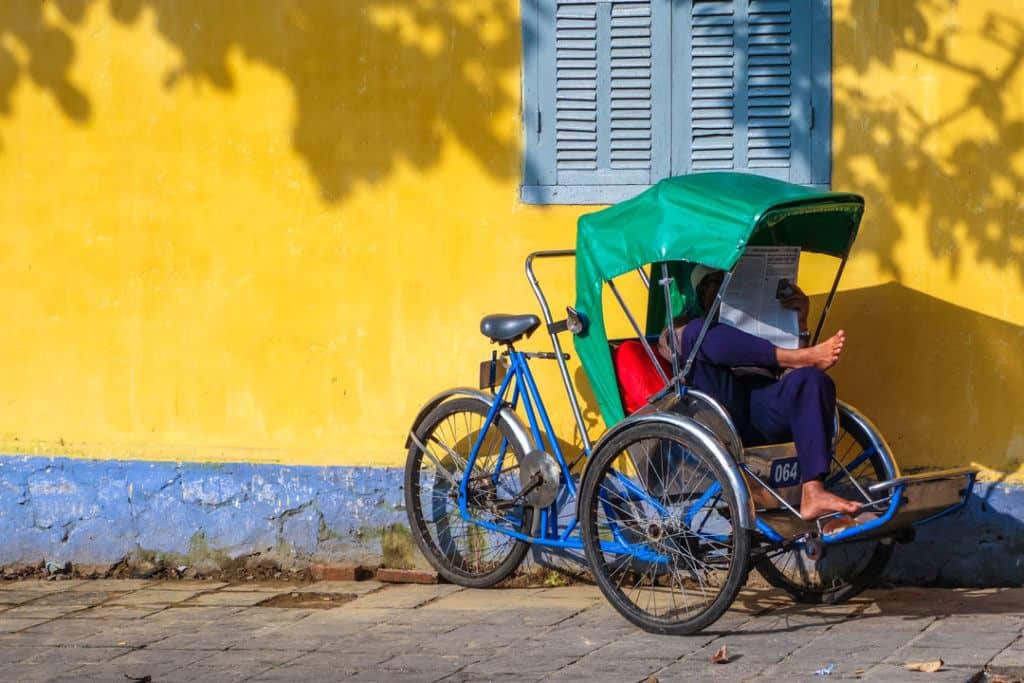
Getting Around Vietnam
Getting around Vietnam is surprisingly easy. Public transport goes everywhere, and there are plenty of moto-taxis that are happy to take you to the places that public transport won’t reach.
Travelling by Air
The fastest way to get around the country, of course, is by air. There are many domestic airports all over the country and you can fly in from major cities.
You can get cheap flights within the country through VietJet Air and Vietnam Airlines. For the best deals head directly on the airline’s website.
Travelling by Taxi, Tuk Tuk Or Mototaxi
When you are in the cities and town catching a taxi, tuk-tuk or moto-taxi can be the best way to get around. For taxi companies, look for the biggest and most reputable companies as you can be ripped off.
For the tuk-tuks, ask your accommodation the average price to your destination so you can agree on a price with the driver.
We recommend Uber and Grab (car or motorbike) which you can use an app and get the price.
Travelling by Bus
It is possible and advisable to travel by bus throughout Vietnam. Busses inside of cities can be complicated and should be a last resort.
However, when travelling long distances in Vietnam busses are a great option. This is especially true if you take night busses and sleep during the ride.
Travelling by Motorbike
We think travelling by motorbike is the best way to see Vietnam if you have the time. Buy your own motorbike and ride the length of the country. Or you can choose one area and explore Northern Vietnam or South Vietnam.
Here’s our post to help guide you on how to buy a motorbike in Vietnam .
Travelling by Train
Taking the train is a great way to get around the country. They are great for overnight journeys as the trains have bed cabins.
In Vietnam, there are many places with roadwork that can last for years. So trains can be the best way to go.
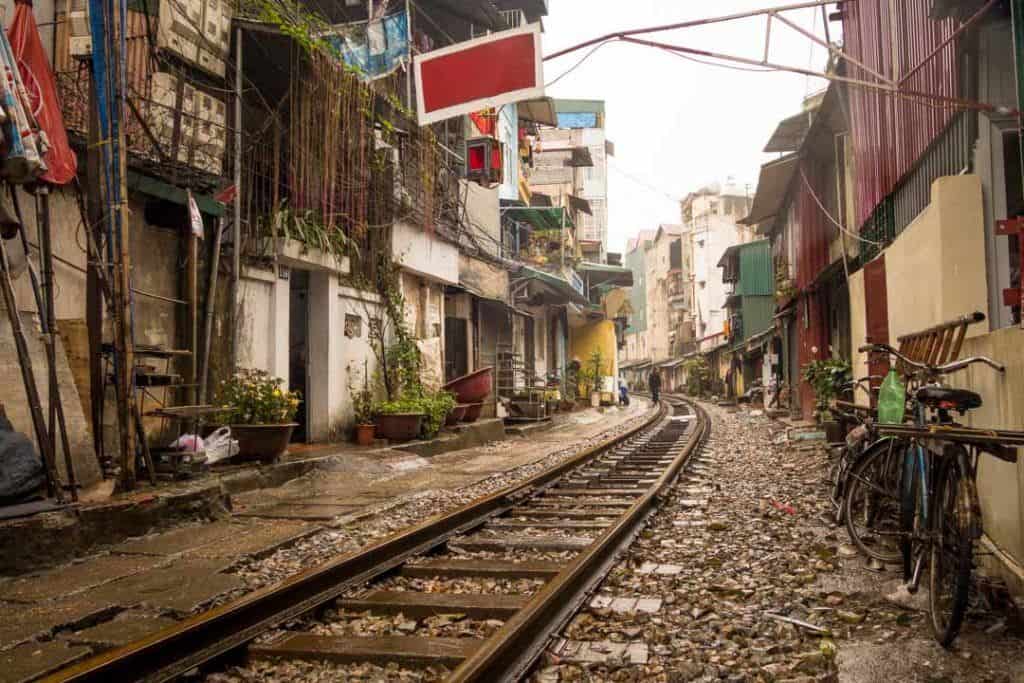
APPS AND TECHNOLOGY
We know you’ll absolutely love travelling in Vietnam. But technology has made it easier, more affordable and safer to travel than ever.
Here are a few apps we think you should definitely acquaint yourself with prior to your travels:
Grab – Use this app to catch a ride from any metro area in Vietnam.
XE Currency – Transfer, monitor and calculate currency as the need arises. This app may not be totally necessary as you are typically tied into rates the banks charge for services. But it is handy to have around.
Express VPN – This will protect your sensitive information wherever you travel – not just in [Country]. Be sure to have this to keep your online information secure as you travel.
iTranslate – Even if you don’t know more than a handful of Vietnamese words, iTranslate will help you communicate as you travel in Vietnam.
WiFi Finder – With this app, you no longer have to guess whether the next place on your itinerary has WiFi or scramble across town looking for hot spots.
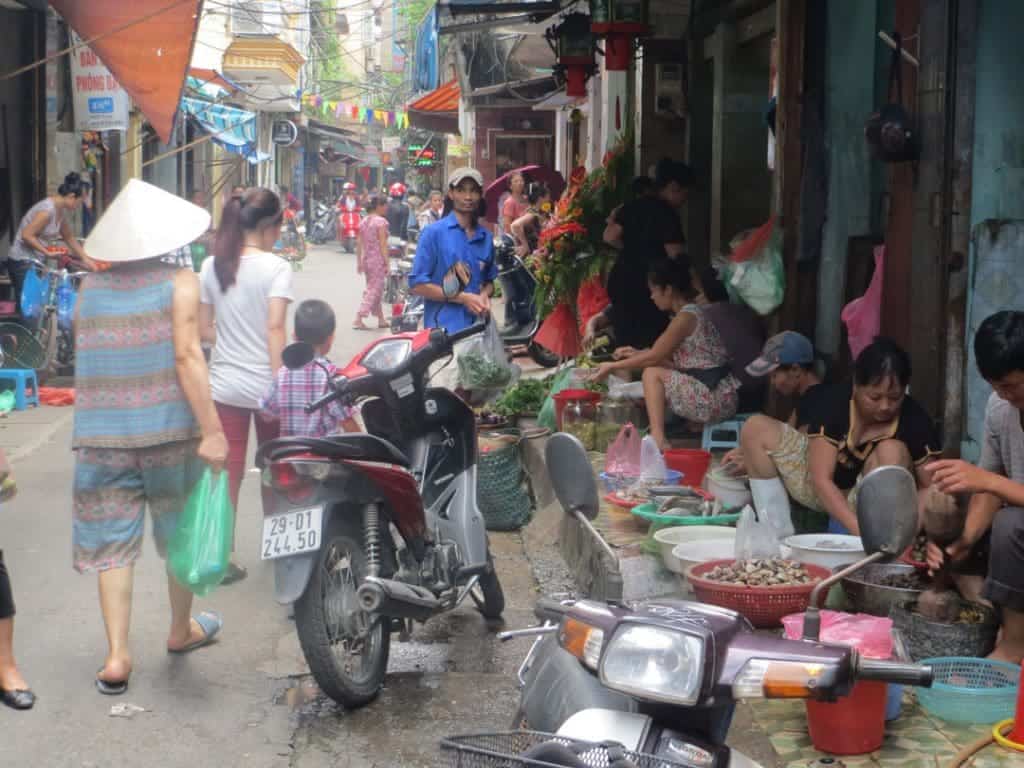
BEST THINGS TO EAT IN VIETNAM
When you travel to a foreign country one of the new and most exciting things you will experience is the food. There are so many amazing food choices in Vietnam, and Vietnamese food is delicious.
Here are a few of our favourites.
Goi Cuon: This is a rice paper packed with greens, coriander and various combinations of minced or shredded pork, shrimp or crab. It will be served with a sweet and sour sauce or a delicious homemade peanut sauce.
Sometimes to make the experience even better, you get to hand roll them yourself. This was our favourite dish.
Banh Mi: With this one, it will be different in every corner of Vietnam. This is a baguette sandwich that is filled with meat, greens, pata, pickled vegetables, soy sauce, cilantro and sometimes an omelet.
The meat filling will be roasted pork belly, grilled pork loin, barbecue pork, boiled chicken, or a fried egg.
Pho (pronounced ‘fur’): This flat rice noodle soup is either light beef or chicken broth flavoured with coriander and ginger with spring onions and bits of meat (chicken, pork or beef).
It is a dish you can have any time of the day and is delicious, but it can be hit and miss in some places. If you have an average one, please do try it again. We ate pho a lot for breakfast and never got sick of it.
Bun Cha: This is a Hanoi specialty and it is deliciously addictive. Bun Cha is served with grilled fatty pork over a plate of white rice noodles. It will be served with a sauce.
It will all be served separately and you combined everything together. You can ask for some little fried spring rolls on top too. It is so delicious!
Coa Lau: Hoi An is the best (and only authentic) place to try this one. as the noodles are made using water from a special well in town.
It is chewy rice flour noodles with Chinese barbecue pork, bean sprouts, croutons and fresh herbs in a delicious pork-based gravy.
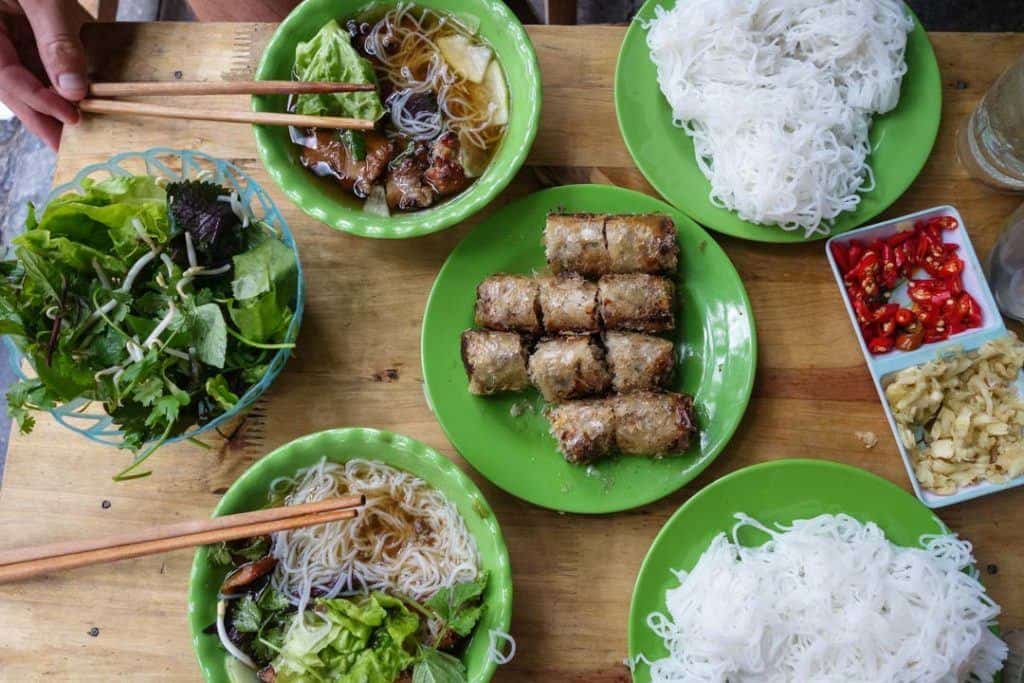
PLACES TO STAY IN VIETNAM
There are accommodation options for all budgets in Vietnam. You can stay in a shared dorm for $5 USD per night, or a luxury hotel for over $300 USD.
The accommodation standards can vary in each destination.
For example, we got a really nice hotel in the middle of nowhere when we were on our bike for $12 a night. But we would not find a place like this in Hanoi, Hoi An, HCMC or Hue for less than $25.
NOTE – In Vietnam, the accommodation will keep your passport for the duration of your stay. This is to do with the government. Officials will randomly come around and check hotels and hostels.
If they do not have the ID or passport of every person staying there, the accommodation will be fined. The accommodation will keep your passport in a safe. If you are unsure just ask, “do you lock my passport up?”
Types of Accommodations
Vietnam is wildly popular among backpackers. Because the costs are generally incredibly low, budget travellers flock to the country.
This means that there are lots of great hostel options when looking for accommodations in Vietnam.
Whether you are busy spending all your time exploring and are just looking for a cheap place to crash for the night or want to make friends along the way, you will find most of what you are looking for in a variety of hostels throughout Vietnam.
Because costs are generally lower in Vietnam than in most parts of the world your quality of life can go up quite a bit when you travel to Vietnam.
One way you can upgrade your travel experience is by booking rooms in hotels instead of beds in hostels. For a few dollars more you’ll get vastly more space and privacy.
In some towns and villages, hotels are your only option.
But generally, these are very reasonably priced. You can expect to spend USD$20-30 for a decent hotel room in most cities, towns and villages across Vietnam.
Another good option in recent years is AirBnB, and there are more and more amazing places popping up to stay in Vietnam for very affordable prices every day.
As is typical in many destinations where Airbnb accommodations are available, you’ll likely find great value and a little more personal space with an Airbnb stay.
If you’re looking for an awesome place to stay, we personally love using Airbnb. If you’ve never used the platform before, sign up using this link to get USD$35 off your first booking .
Our Favorite Places to Stay in Vietnam
We travelled from the south to the north and stayed in many different places. Here are a few accommodation options we highly recommend.
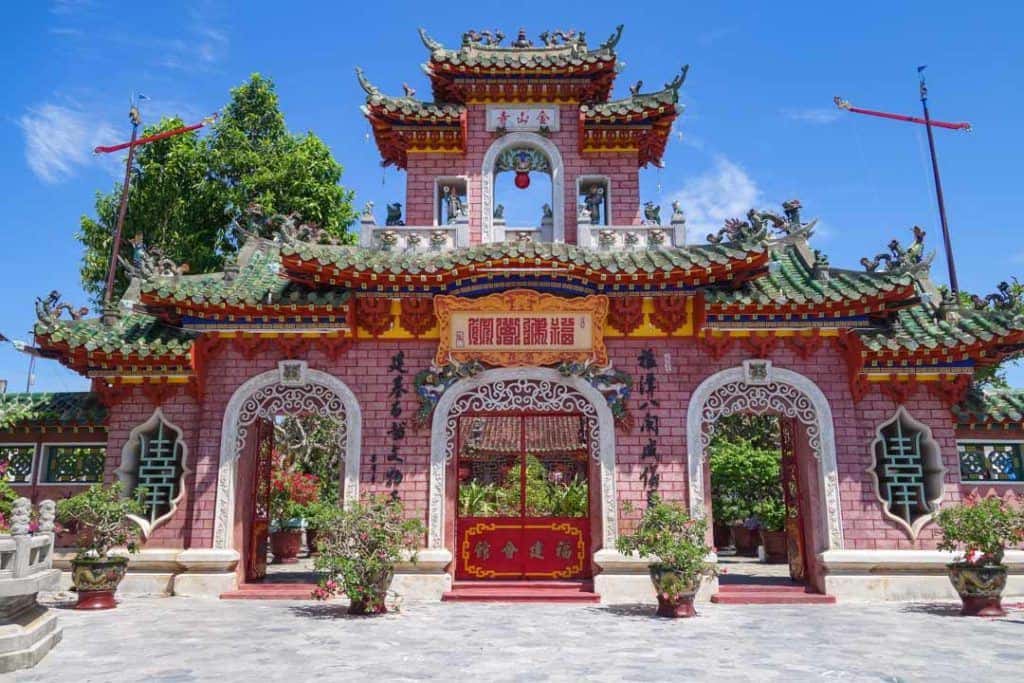
VIETNAM TRAVEL TIPS
The Vietnamese people are friendly, welcoming and hospitable towards travellers. It is a great destination to travel to in Southeast Asia.
The people are very respectful and would like the same back from you. Here are a few things that you should know before going to Vietnam.
GENERAL VIETNAM TRAVEL TIPS
While we have many basic travel tips we suggest you use when travelling to Vietnam, there are also plenty of Vietnam-specific tips that will make your visit the best it can be.
Here are a few we recommend you consider as you plan your trip to visit Vietnam:
Please show respect to their religious beliefs and their cultures . You are travelling to someone else’s country. They have different religious beliefs and cultures in your home. Please respect them.
Watch your belongings. Vietnam is a safe country but unfortunately, there still is petty theft. Whether you are at a restaurant or on a bus always watch your belongings.
Beware of the counterfeit tour agencies . Unfortunately, there are plenty of these around, especially in the main tourist areas. Book through the main owner or operator or any of these tours that we recommend .
Do not drink the tap water. The locals don’t even drink the water. There is bottled water available everywhere. Popular tourist restaurants will usually have on their menu that they wash their salad and veggies in sterilised water and make tea, coffee and soup from that too.
Carry toilet paper everywhere . There are toilets available in restaurants or in public but there may not be toilet paper. Most of the time you have to pay for the public toilet and they may give you some toilet paper, but don’t count on it. Always have your stash.
Toilet paper goes in the bin . DO NOT put the toilet paper in the toilet. Please put it into the bin provided. Vietnam’s sewerage systems are not built for much more than human waste so toilet paper and other items will just clog up your toilet.
Embrace the “bum gun “. Next to every toilet in Vietnam, there is a water hose. This is not to wash down the floor. This is to clean yourself up after you do your business. Don’t be disgusted by this. Embrace it.
Vietnam is bigger than you think . This country is huge and many people underestimate it. Vietnam is about 1,650 kilometres long from north to south. The distance on buses and trains is long so be prepared.
Take note of the Vietnamese money . It will be a new currency for you so do take a look at it before you go out spending. There are more zeros in it than you might be used to (1USD = 23,000 Dong)
Always take photos when you rent a scooter . Renting a scooter in Vietnam is something everyone does. It is a great way to get around and see all the attractions. But where you rent it from can get you into trouble. Whenever you rent a scooter take photos of the bike or else might end up with a crazy expensive bill.
Always wear a helmet. Always . Please wear a helmet. The roads are crazier here than they are in your country. The rules are different and road conditions are not the best. A quality helmet could save your life in an accident.
Make sure you have travel insurance . We tell people who are going travelling, “if you can’t afford travel insurance, you can’t afford to travel.” You do not know what is going to happen while you are away and knowing you are covered will put your mind at ease.
Be confident when crossing the road . The roads in Vietnam are crazy. Crossing the road can be daunting but you need to be confident. Do not walk backward or hesitate. Walk slowly and watch the traffic coming towards you. They will all move around you.
Take your shoes off before entering a temple or a person’s home . It is a custom that stems back to ancient times and a big part comes back to cleanliness. The ground is used for chatting, dining and even sleeping.
Cover your shoulders and knees when entering a temple . This is common in most religious sites. There are always signs suggesting visitors dress ‘appropriately.’ Shoulders and knees should be covered. If it is a hot day and a t-shirt is too sticky, carry a scarf for when you visit to cover your shoulders.
Keep a low profile . Do not be loud, raise your voice in aggression or show off. Do not show dramatic affection publicly like kissing. Save it for the hotel room
Ask for permission before taking a photo of someone . This is polite and ensures you are not intruding on them. The people are not there for your entertainment. If they say no, smile and thank them anyway.
Do not take photos of anything to do with the government or military. This is a big NO in any country and can end up with you in jail.
Do not touch someone on the head . The head is the most important part of the body. Touching someone’s head who you don’t know is like saying you are more important than they are.
Place your chopsticks across the top of the bowl when finished . Don’t have your chopsticks hanging out of the bowl, and don’t point them at anyone when they are resting on the plate.
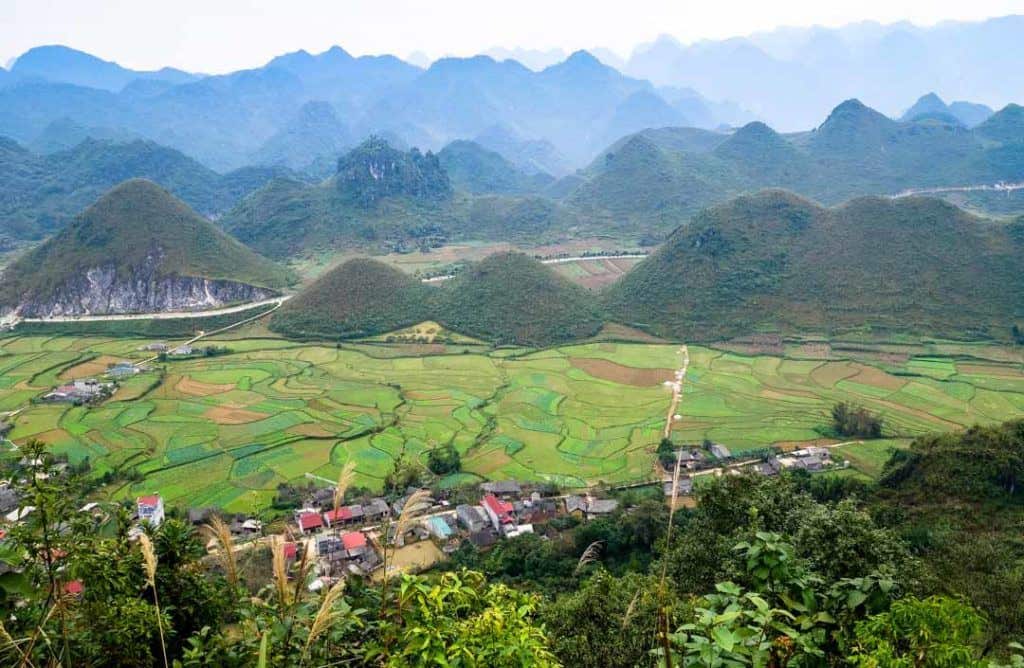
VIETNAM PACKING LIST
We always travel with a core packing list wherever we go. And when it comes to Vietnam, many factors will affect what else you need to bring along with you.
Check out our travel essentials and be sure to add any of the other additional items listed below.
Important Note! Before you book any international trip, we honestly recommend getting travel insurance. You never know when things will go wrong, and medical bills can add up quickly if you get sick or injure yourself overseas.
Our personal recommendation based on our own experience is World Nomads .
TRAVEL INSURANCE. SIMPLE & FLEXIBLE.
Which countries or regions are you traveling to, what’s your country of residence, enter traveler’s age, staying safe in vietnam.
Vietnam is extremely safe, apart from the one major danger which is the roads. They are crazy, even more so if you try to ride 10’000km around the country on motorbikes as we did!
Aside from that, common sense will keep you safe.
Here are a few reminders of what common sense when travelling in Vietnam means:
As you saw above, Vietnam is extremely safe. We did not feel unsafe once in the 7 months we were there (excluding the roads).
This doesn’t mean you can completely let your guard down though, and petty theft does happen in this country, although it’s not common.
Some tips for protecting your things:
In other words, use common sense and you’ll be fine.
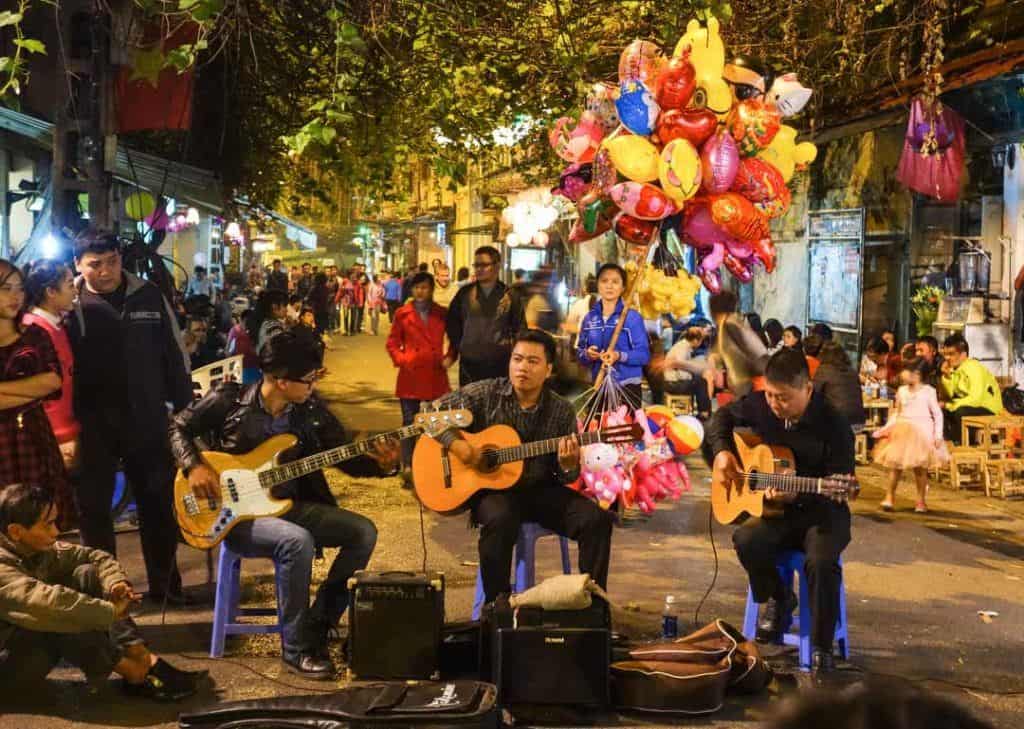

STAYING CONNECTED IN VIETNAM
Staying connected with friends and family (and work) when travelling in Vietnam is important. But if you don’t know how to connect you can find yourself greatly inconvenienced or spending too much money.
We feel like your money will go a lot further if you consider a few options.
Purchase a SIM Card
Picking up a SIM card has become the quickest and typically most affordable way to stay connected in Vietnam or any country for that matter.
If you have an unlocked phone you can use a 4G SIM card to connect to the cellular networks in Vietnam. From there you can cast a hot spot if you need to crank out some work on your computer or want to connect a tablet.
This 3G/4G SIM card is a great and affordable option for a SIM card if you are flying into Vietnam.
Rent a Portable WiFi Device
Alternatively to a SIM card, particularly if you don’t have an unlocked phone, you can rent a portable WiFi device during your travel to Vietnam.
This device will be delivered to you when you arrive in Vietnam and will provide 4G service for less than USD$5 per day.
You’ll be able to connect anywhere you can find service across the country, which will be most of the places you are likely to travel in Vietnam.
Access Free WiFI
Free is always best, if it is convenient. And there are plenty of places throughout Vietnam that will provide free WiFi in public spaces or at restaurants, cafes and hostels and hotels.
We recommend using the WiFi Finder app, which will help you locate WiFi anywhere you travel in Vietnam.
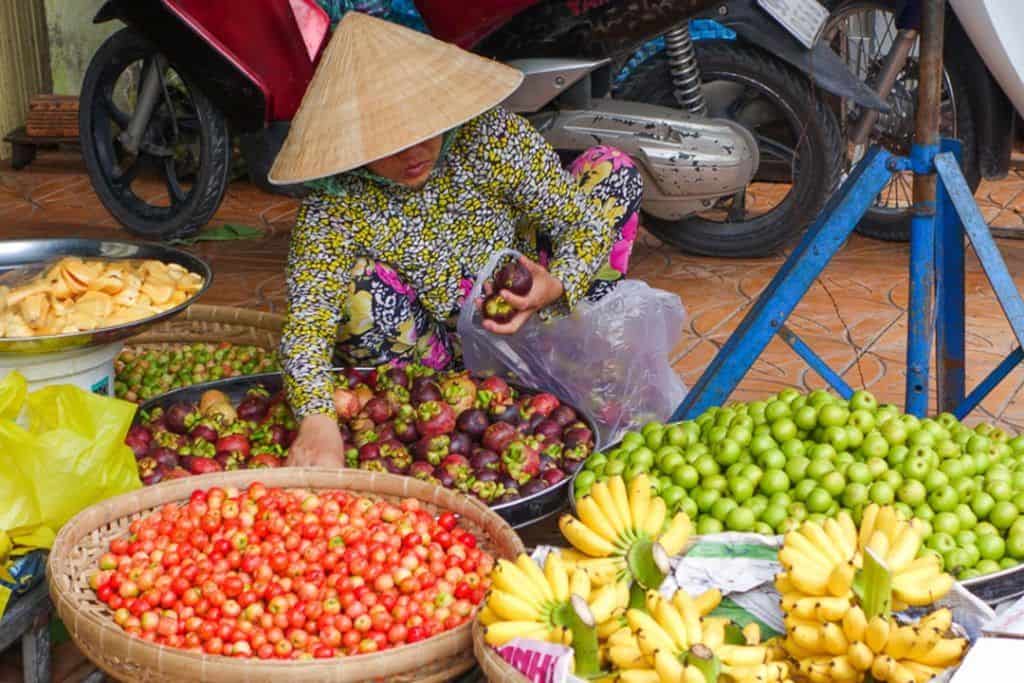
BE A RESPONSIBLE TRAVELER IN VIETNAM
We absolutely love Vietnam. And we love the idea that it will remain a beautiful and friendly place for travellers for years to come.
Here are a few tips specific to travel to Vietnam that will promote sustainable tourism in the country:
Use your own energy to get around. Walk or cycle through town as much as possible. Taking a cyclo-taxi is a close alternative if you don’t have the energy to propel yourself through the city. But this reduces the impact of taxis, busses and other forms of automotive transportation.
Mind your plastic . Plastic is everywhere in Vietnam. But using your own reusable bag for groceries and other shopping, carrying a reusable water bottle and having your own straw are just 3 of the many simple ways you can reduce the amount of plastic you use.
Shop local . Visiting the markets will be one of your top experiences when travelling to Vietnam. Support local vendors as often as possible, including in taking tours when available.
Be mindful of wildlife . Wildlife in the wild is great. But be mindful not to provoke, feed or otherwise molest wildlife. And never purchase any item made of or involving rare or endangered species.
Attempt to communicate in Vietnamese . You’re probably not going to be fluent as soon as you arrive in the country. But knowing a few phrases and doing your best to communicate with locals will show respect and earn trust and make your experience richer.
KEY VIETNAMESE TRAVEL PHRASES
You don’t have to be fluent in Vietnamese to have a great time when you travel to Vietnam. But it does help to know a few key phrases.
This will not only assist you in your travels but it will also show respect to the local Vietnamese people that you are doing your best to assimilate into their culture.
BOOKS TO READ ABOUT VIETNAM
Maybe you already know everything about Vietnam. Chances are you don’t!
But even if you are well-read, here are a few suggestions that might be worth your time while you’re on the plane to Vietnam.
The Quiet American (Graham Greene) – Originally published in 1956 and adapted for film twice, this story by Greene became an instant classic. Greene fictionalizes life in 1950s Vietnam as told by a British correspondent trying to understand the roots of the rising conflict set to occur.
At Home In The World (Thich Nhat Hanh) – World renown Vietnamese monk, Hanh reflects on lessons and stories in life from the Buddhist perspective.
Vietnam: Rising Dragon (Bill Hayton) – A piece of nonfiction that looks back on the Vietnam of old and attempts to projects its place in the future of Southeast Asia.
The Sympathizer (Viet Thanh Nguyen) – The Pulitzer Prize-winning book, allegedly influenced by The Quiet American , is told through the eyes of a double-agent during the Vietnam War who struggles to understand the minds and hearts of men engaged in war.
DISCLAIMER: Some of the links in this article are affiliate links, which means if you book accommodation, tours or buy a product, we will receive a small commission at no extra cost to you. These commissions help us keep creating more free travel content to help people plan their holidays and adventures. We only recommend the best accommodations, tours and products that ourselves or our fantastic editorial team have personally experienced, and regularly review these. Thanks for your support, kind friend!
Table of Contents
Read our vietnam posts, 20 amazing things to do in hoi an, vietnam (2024 guide), 14 incredible things to do in dalat, vietnam (2024 guide), the perfect 3 days in hanoi itinerary [2024 guide], 25 amazing things to do in hanoi, vietnam (2024 guide), the perfect 3 days in ho chi minh city itinerary [2024], the 8 best day trips from ho chi minh city (2024 guide), caves, zip lines and deep mud in phong nha, ganh da dia – vietnam’s own ‘giant’s causeway’, ba be national park – the lake, trekking and happy water, motorbiking the road from dalat to nha trang in vietnam, riding sea to sky: hue to hoi an by motorbike, getting a chinese visa in hanoi, vietnam.

- 2 Weeks for Couple
- 2 Weeks for Family
- Thailand Lantern Festival
- Indonesia(Bali)
- South Korea
- China (HK, Taiwan)
- Itinerary Ideas
- Asia Highlights Travel Reviews
- Thailand Travel Reviews
- Vietnam Travel Reviews
- Cambodia Travel Reviews
- Japan Travel Reviews
- Myanmar Travel Reviews
- China Travel Reviews

Best & Worst Times to Visit Thailand and Vietnam 2024, Best Month
Thailand and Vietnam will never disappoint you whenever you visit. Both countries enjoy a tropical climate with an average temperature of around 27°C (80°F). Most areas share two distinct seasons: a dry season (November to April) and a wet season (May to October).
So, the best time to visit Thailand and Vietnam is November to April when you can enjoy most sunny days with cool/warm weather.
- Best Weather Times
- Best Times for a Family Trip
- The Worst Times to Visit
- Rainy Season: The Cheapest Time
- Monthly Weather in Thailand and Vietnam
Best Weather Times for Thailand and Vietnam
If you really want a rain-free trip to Thailand and Vietnam, November to April is undoubtedly your best time. The dry season is generally divided into two sub-seasons: the cool season (November to February) and the hot season (March to April).
For the most comfortable experience, visit Thailand and Vietnam in the cool season. It always offers the most favorable weather for outdoor fun and cultural experiences, alongside with festive atmosphere. For example, Thailand's Yi Peng Festival around November creates a romantic backdrop for a couples' trip.
Travelling in the hot season, you'll be rewarded with less-crowded experiences, particularly at the iconic landmarks. Different from group tours with fixed schedules, a flexible private tour helps to make the most of the most pleasant weather of any day, like the cooler early morning or late afternoon hours. To beat the heat, we always prepare cold drinks in our private air-conditioned vehicles.
See more ideas about hand-picked itineraries and costs for a trip to Thailand and Vietnam >>>
Best Times for a Family Trip to Thailand and Vietnam
The tropical weather makes Thailand and Vietnam perfect as warm winter getaways and excellent destinations for family trips.
Weather-wise, December is the best time to enjoy family-friendly activities , such as elephant sanctuaries, beach activities, and cultural shows. Being in the peak season, you'd better prepare for high costs and crowds. It's advisable to book your tour half a year in advance to secure higher availability of family rooms, get early-bird benefits and avoid last-minute hassles.
Summer holiday is another peak time for overseas family travel. If summer is the only time you have, then June is the best time to visit Thailand and Vietnam. Compared with July and August, June experiences less rainfall, which typically lasts for only 1–2 hours on 1 in 2 days. Additionally, you can avoid the crowds of summer holidaymakers (mostly from early July) from nearby countries, like China and Japan.
A flexible itinerary with some indoor activities would make your summer family trip more "rain-proof" as well. Our private local guides always have a plan B to cater to your needs, even on a rainy day.
For more details, you could see Multi-Generational Family Trip to Southeast Asia or check out how to plan a family trip to Southeast Asia >>>
The Worst Times to Visit Thailand and Vietnam
If you don't like the rain, the rainy season (May to October) would be the worst time for your holiday.
If you are sensitive to crowds and want a budget-friendly trip, consider avoiding the cool season (November to February), especially the Christmas / New Year holidays.
The "worst times" disadvantages are balanced by benefits. You could enjoy the lowest prices (around 30–50% off) and no crowding in the rainy season, while the cool season has the obvious benefit of the most comfortable weather and clear skies for stunning scenery.
Alternatively, travelling just before or after the high season (in May or late October) is advisable as a compromise for lower costs, smaller crowds, and lighter rainfall.
Further Reading: Itinerary options for 2 weeks in Thailand and Vietnam
Discover real reviews of Highlights Travel Family 's best-rated service across trusted platforms.
Rainy Season in Thailand and Vietnam: The Cheapest Time
In Thailand and Vietnam, it is common to have daily rain in the wet season, but the rainy season doesn't usually imply continuous rainfall. Most showers/downpours just last for 1–2 hours in the afternoon or in the night.
In Thailand and Vietnam, the highest rainfall arrives from August to October , especially in Thailand, and you might also encounter some typhoons in Vietnam. These typhoons or storms can potentially lead to flight cancellations as well as disrupting cruises or island-hopping tours. Travelling with us , your AH travel expert and local guide would contact you in the event of inclement weather and be on standby to adjust your itinerary or provide help as needed.
Thanks to the region's diverse geography, you still can find some dry getaways during the rainy season (up to August/September), such as Hoi An in Vietnam and Koh Samui in Thailand (which have their wet seasons a month or two later). Almost all of Vietnam and Thailand has a rainy October except for Chiang Mai and Hanoi (northern Thailand/Vietnam).
Thus, with a well-organized travel plan and a flexible schedule, the rainy season remains travel-worthy, alongside the cheapest prices.
You could find more inspiration for planning your dream trip in How to Plan a First Trip to Southeast Asia >>>
Find Your Best Month to Visit Thailand and Vietnam
January weather and travel in thailand and vietnam.
- Northern Vietnam (Hanoi, Ha Long Bay, Sapa): 12°C to 20°C (54°F to 68°F), dry
- Central Vietnam (Hoi An, Hue, Danang): 20°C to 24°C (68°F to 75°F), low rainfall
- Thailand and Southern Vietnam (Ho Chi Minh City, Mekong Delta, Phu Quoc): 26°C to 32°C (79°F to 90°F), dry
January is one of the best times to visit both countries without being bothered by heat or rainfall.
You could fully indulge in tropical beach fun in Phuket, seek outdoor adventure in hidden Chiang Rai, and celebrate New Year with your family in picturesque Ha Long Bay...
In one in three years Chinese New Year in Thailand and Vietnam's New Year (Tet festival) falls in January, when you can immerse yourself in the delightful local celebrations.
During this holiday season, you can expect high costs and larger crowds in both countries. Early booking (at least 6 months before) would keep you away from last-minute hassles and price rises.
The neighboring Cambodia also shares the best weather, so you could consider planning a trip to Thailand, Cambodia, and Vietnam .
February Weather and Travel in Thailand and Vietnam
- Northern Vietnam (Hanoi, Ha Long Bay, Sapa): 13°C to 21°C (55°F to 70°F), dry
- Central Vietnam (Hoi An, Hue, Danang): 20°C to 25°C (68°F to 77°F), dry
- Thailand and Southern Vietnam (Ho Chi Minh City, Mekong Delta, Phu Quoc): 26°C to 33°C (79°F to 91°F), very dry
Similar to January, the dry and pleasant weather continues in February. You'll have the best weather wherever you go.
If you're a beach lover, then February is an ideal time to go, no matter whether you want bustling Phuket or tranquil Phu Quoc Island.
Without as much heat, Chiang Mai in Thailand is a wonderful warm destination. You could walk and bathe elephants in a sanctuary, celebrate Chiang Mai Flower Festival with locals, and hike around the hill tribe villages.
Read more about planning a couple's trip to Southeast Asia >>>
March Weather and Travel in Thailand and Vietnam
- Northern Vietnam (Hanoi, Ha Long Bay, Sapa): 16°C to 23°C (61°F to 73°F), dry
- Central Vietnam (Hoi An, Hue, Danang): 21°C to 27°C (70°F to 81°F), dry
- Thailand and Southern Vietnam (Ho Chi Minh City, Mekong Delta, Phu Quoc): 27°C to 34°C (81°F to 93°F), dry
March is a good month to visit both Thailand and Vietnam. With few rainy days, you can still expect a lot of sunshine and blue skies throughout the day.
The temperature starts rising in Thailand and Vietnam, but it's not yet unbearably hot. If you want cooler weather, you could visit northern Thailand, and northern and central Vietnam, where the temperature averages around 25°C (77°F).
April Weather and Travel in Thailand and Vietnam: Last Dry Month, Very Hot
- Northern Vietnam (Hanoi, Ha Long Bay, Sapa): 22°C to 27°C (72°F to 81°F), moderate rainfall
- Central Vietnam (Hoi An, Hue, Danang): 23°C to 29°C (73°F to 84°F), low rainfall
- Thailand and Southern Vietnam (Ho Chi Minh City, Mekong Delta, Phu Quoc): 28°C to 34°C (82°F to 93°F), low rainfall
In April, the temperature will increase to around 30°C (86°F) on average. With a few afternoon showers or short-lived cloudbursts towards the end of the month, dry weather is near-guaranteed.
To travel in cooler weather, you could have leisurely time in Ha Long Bay, hike the terraced hillsides of Sapa, and explore the jungles in Chiang Mai.
Beach holidays are not to be missed during your Thailand and Vietnam trip. Koh Samui and Koh Pha Ngan are better alternatives, as Phuket's rainfall increases to moderate levels.
Travelling in April, an immersive cultural experience that's recommended is the big water fight and other lively celebrations during Songkran Festival in Thailand . Chiang Mai and Bangkok are the best places to celebrate it.
May Weather and Travel in Thailand and Vietnam
- Northern Vietnam (Hanoi, Ha Long Bay, Sapa): 23°C to 31°C (73°F to 88°F), moderate rainfall
- Central Vietnam (Hoi An, Hue, Danang): 25°C to 32°C (77°F to 90°F), low rainfall
- Thailand and Southern Vietnam (Ho Chi Minh City, Mekong Delta, Phu Quoc): 27°C to 34°C (81°F to 93°F), high rainfall
You'll have the hottest weather, averaging 32°C (90°F), in May. Meanwhile, the rainy season comes in, with moderate rainfall in most areas of Thailand and Vietnam. You still can find some dry getaways in central Vietnam and on the Koh Samui coast of Thailand.
Since the highest rainfall hasn't yet arrived in May, you can still enjoy plenty of dry hours and experience the distinct advantages it brings, such as significant cost savings and lower crowds.
June Weather and Travel in Thailand and Vietnam
- Average temperature range in Thailand and Vietnam: 26°C to 34°C (79°F to 93°F); moderate-to-high rainfall in all but low-rainfall central Vietnam (Hoi An, Hue, Danang)
Most of Thailand and Vietnam shares the same pattern in June: hot weather and more frequent rainfall (mainly short bursts). Central Vietnam is the exception. In Thailand, all but high-rainfall Phuket sees moderate rainfall.
Mountain areas are the cool places to go to escape from the summer heat, such as Sapa and Da Lat in Vietnam and Chiang Mai and Chiang Rai in Thailand. They are also perfect for outdoorsy stuff, especially for families with teenagers.
A private tour with a flexible tour pace is beneficial to avoid the burning sun and adapt your itinerary to accommodate rainy hours by seeing indoor shows or doing cooking classes. Contact us to tailor-make your trip!
July Weather and Travel in Thailand and Vietnam
- Average temperature range in Thailand and Vietnam: 26°C to 35°C (79°F to 95°F); high rainfall in all but low-rainfall central Vietnam
July mirrors June weather-wise, but the crowds tend to increase due to the summer holidays. Compared with peak season, the crowds are still negligible.
Summer spells beach time. Instead of rainy Phuket, you can enjoy grand firework shows during your beach relaxation in Da Nang or go to Koh Samui for snorkeling, scuba diving, or swimming.
Get more ideas about planning your summer trip to Southeast Asia >>>
August Weather and Travel in Thailand and Vietnam
- Average temperature range in Thailand and Vietnam: 26°C to 34°C (79°F to 93°F); high rainfall in all but central Vietnam and around Ko Samui, where it's only moderate
Peak rainfall is approaching most areas of Thailand and Vietnam, but most weather systems come and go quickly.
You might encounter some potential intense storms or typhoons, which would affect cruises in Ha Long Bay and island-hopping tours. Having a plan B in place is essential to ensure a smooth and enjoyable experience.
During this summer month, you could head to drier Central Vietnam (around Hoi An) or enjoy the abundant cultural experiences in Bangkok and Chiang Mai, such as a ladyboy show, a Muay Thai show, or a Thai cooking class.
In contrast to peak travel season, August presents an opportunity for more-affordable and less-crowded travel.
September Weather and Travel in Thailand and Vietnam
- Average temperature in Thailand and Vietnam: 24°C to 31°C (75°F to 88°F); high rainfall throughout
Overall, September is the wettest month to visit Thailand and Vietnam. But the rainfall in northern Vietnam will come to a tail-end in late September.
In northern Vietnam, Sapa welcomes its best time: warm weather averaging 23°C (73°F), less rainfall and breathtaking golden rice terraces. Hiking is the perfect way to discover its beauty.
October Weather and Travel in Thailand and Vietnam
- Northern and central Vietnam: 22°C to 28°C (72°F to 82°F); low rainfall in the north; extremely high rainfall in the central region
- Thailand and southern Vietnam: 25°C to 31°C (77°F to 88°F); high rainfall to low late in the month; vice-versa around Ko Samui
October marks a turning point in both temperature and rainfall patterns in Thailand and Vietnam: hot to warm and wet to drier. So late October is an ideal choice if you want to explore both countries with more-comfortable weather.
Travelling in October, you could enjoy outdoor adventures in northern Thailand (Chiang Mai and Chiang Rai) and northern Vietnam (Hanoi, Sapa, and Ha Long Bay), where rainfall is only moderate and decreasing through the month.
November Weather and Travel in Thailand and Vietnam
- Northern Vietnam (Hanoi, Ha Long Bay, Sapa): 17°C to 24°C (63°F to 75°F); low rainfall
- Central Vietnam (Hoi An, Hue, Danang): 20°C to 25°C (68°F to 77°F), very high rainfall
- Thailand and Southern Vietnam (Ho Chi Minh City, Mekong Delta, Phu Quoc): 24°C to 30°C (75°F to 86°F); moderate rainfall
The dry-season best travel time returns in Thailand and Vietnam, particularly their northern regions.
If you're celebrating a romantic milestone, Yi Peng Festival in Chiang Mai would create lifetime memories for you and your partner. Our well-selected private Ha Long Bay cruise (just for you and your partner) would allow you more quality private time.
Central Vietnam and Koh Samui experience very heavy rain, so for a leisurely beach time, you're suggested to choose drier Phuket and Phu Quoc or start your beach vacation in late November.
December Weather and Travel in Thailand and Vietnam
- Northern Vietnam (Hanoi, Ha Long Bay, Sapa): 14°C to 21°C (57°F to 70°F); dry
- Central Vietnam (Hoi An, Hue, Danang): 19°C to 24°C (66°F to 75°F); high rainfall
- Thailand and Southern Vietnam (Ho Chi Minh City, Mekong Delta, Phu Quoc): 23°C to 29°C (73°F to 84°F); low rainfall except for high-rainfall Ko Samui
If you experience chilly days in your country in December, Thailand and Vietnam could be a warm escape for you, with an average temperature of around 25°C (77°F). Rainfall fades away towards January in all areas, so you could celebrate Christmas with your family on typically rain-free days.
A family trip to a warm tropical paradise could add an exotic touch to your family reunion during Christmas and New Year holidays. However, these holidays bring Thailand and Vietnam into their peak travel seasons with the highest prices. Their character-filled boutique hotels, particularly, are easily fully booked. So, make sure you book a December tour at least 6 months in advance. Inviting a wider family is also helpful for saving costs in December.
Popular Thailand and Vietnam Tours
We provide a customized service for private tours. Our travel consultants will listen to and work to your ideas and answer any questions. We will create your dream trip based on your interests, travel length, and needs.
Here are some of our sample tours:
- 14-Day Classic Vietnam and Thailand Tour
- 15-Day Best of Thailand, Cambodia, and Vietnam Tour
- 19-Day Thailand, Cambodia, and Vietnam In-Depth Tour
Why Asia Highlights (10,000+ reviews & 98.8% 5-star rating)
- Save Your Time:
- Less research, more enjoyment!
- Real-time 1V1 expert planning
- Maximize Your Flexibility:
- Personal local guide and ride
- Explore at your own pace
- Celebrate Your Journeys:
- Specially-crafted family adventures
- Celebrate milestones with style!
Get Inspired with Some Popular Itineraries
At Asia Highlights, we create your kind of journey — your dates, your destinations, at your pace. You can have any trip tailor made for your travel.
More Travel Ideas and Inspiration
Sign up to our newsletter.
Be the first to receive exciting updates, exclusive promotions, and valuable travel tips from our team of experts.
Why Asia Highlights
Where can we take you today.
- Middle East
- African Safari
- Travel Agents
- Loyalty Program
- Our Differences
- Privacy Policy
Address: Building 6, Chuangyi Business Park, 70 Qilidian Road, Guilin, Guangxi, 541004, China
The best times in the year to visit Vietnam

Feb 22, 2024 • 5 min read
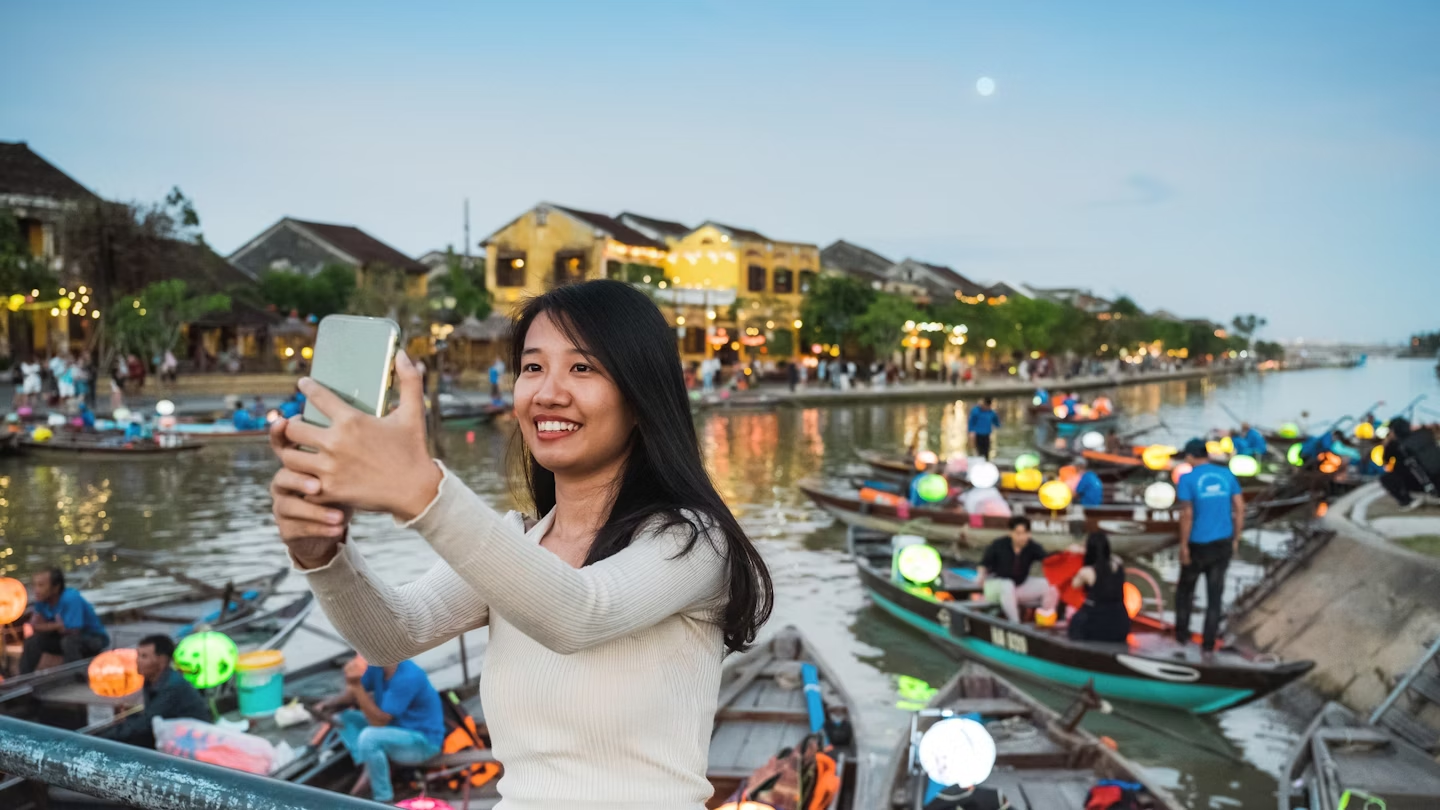
Pick the right time for your visit to Vietnam with this seasonal guide © golero / Getty Images
Vietnam serves up a generous dose of Southeast Asian magic at any time of year, but some seasons are easier for travelers than others.
A lot depends on what you are looking for from your trip – if it's time on the beach on the central coast, you probably want to stick to the drier months from February to June, before the peak summer crowds arrive; if you're here to go trekking in the highlands, October to March is the optimum season.
It's important to be aware that the weather can vary widely as you travel around Vietnam. The country spans 1650km (1025 miles) from north to south, taking in tall mountains in the north and flat, tropical wetlands in the Mekong Delta . In the north, it can be positively chilly in winter; from December to February, the highlands around Sapa can see snow while the Delta basks at 25°C (77°F).
To help you plan a perfect trip, here's our guide on the best times to visit Vietnam.
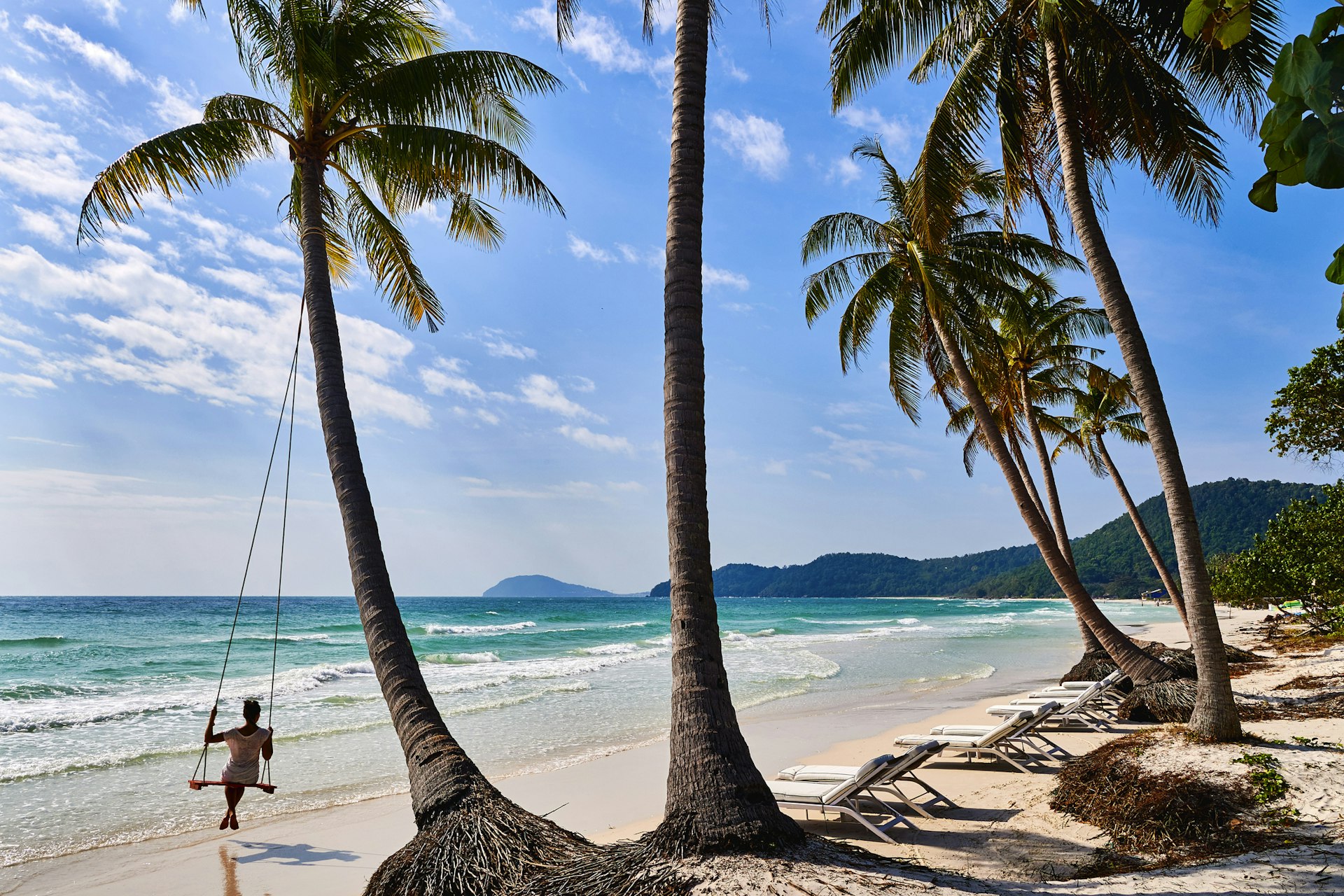
July and August are the top months for beach lovers
The hot, sticky high season from July to August is the busiest time of year to visit Vietnam, coinciding with favorable beach weather on the central coast. Demand for flights soars, and prices for accommodations can increase by as much as 50% in resort areas such as Danang and Nha Trang . Book flights and hotels well in advance and expect crowds on the sand at all the popular resorts.
The rest of the country is warm and humid, and sunny days are punctuated by spectacular summer monsoon downpours and even the odd typhoon on the coast. This is a poor time of year for visiting the north, as trekking trails turn into quagmires, and Hanoi and Halong Bay are drenched by heavy showers. On the festival calendar, Trung Nguyen (Wandering Souls Day, also known as Vu Lan) in August sees huge spreads of food left out for the spirits.

December to March is the season to visit Hanoi and Ho Chi Minh City (HCMC)
Winter in Vietnam tends to be drier and cooler than the sticky summer, and the weather can be downright chilly in the north, particularly at higher elevations. However, this is the perfect time to explore Vietnam's characterful northern and southern capitals, with manageable temperatures and low humidity taking the sting out of exploring Hanoi and Ho Chi Minh City (HCMC) on foot.
If you want to see more of the country, this is also a great time to head out to the Mekong Delta and the island of Phu Quoc , with warm (not scorching) temperatures and clear skies. As April approaches, however, the mercury starts to climb to uncomfortable levels down south.
Another obstacle to easy travel is the Tet festival – officially, Tet Nguyen Dan – marking the Vietnamese lunar New Year, in late January or early February. The whole country is on the move and prices for transport and hotels shoot skywards.
In December, the biennial Flower Festival brings fragrant blooms, pageants, wine and music to Dalat , while Buon Ma Thuot's annual coffee festival in March attracts lovers of a good brew. Christmas Day – known in Vietnam as Le Giang Sinh – is a big deal for the Catholic community in Ho Chi Minh City.

Visit from April to June and September to November to avoid the crowds
The low season in Vietnam coincides with the transition from the cool, dry winter to the hot, humid summer and vice versa. From April to June and from September to November, the weather is often unsettled but rarely extreme. You may get days of glorious sunshine, but there will also be days of rain, so pack for both dry and wet weather.
These transition periods are good times to avoid crowds at the sights, save money and explore the whole country, as the weather is not notably awful anywhere. The October to November window is particularly favorable for exploring the islands and outcrops around Halong Bay (and its calmer and less commercial neighbor, Bai Tu Long Bay ), with more dry days than wet days and mild temperatures.
There are some good festivals too. Held in Hue in April, May or June, the biennial Hue Festival fills the city's historic citadel with color, music and lights, while the Nha Trang Sea Festival brings a similar party mood to Nha Trang every second June. Vietnamese Buddhists celebrate the life of the Buddha with extravagant street processions in May for Phat Dan – best experienced in Ninh Binh or Ho Chi Minh City. Pyrotechnics enthusiasts of all kinds gather in Danang in June (or sometimes July) for the explosive Danang Fireworks Festival.
In the pre-winter season, aim to be in Hanoi on September 2, as Vietnam National Day brings energetic rallies and fireworks to Ba Dinh Square and boat races to Hoan Kiem Lake . Tasty festival foods appear everywhere for Trung Thu, the Mid-Autumn Festival, in September or October, while dragon boats race on the waterways of the Mekong Delta for the Khmer Ok Om Bok Festival in October or November.
Visiting Vietnam during the typhoon season
Technically, the typhoon season in the Northwest Pacific runs from May to November, but in Vietnam, the biggest risk of storms is from August to September. The country sees four to six typhoons in an average year, marked by heavy rain and strong winds. Occasional severe storms lead to flooding and disruption to transport, particularly by air and sea.
The areas most affected by typhoons are the southern coast and the far north coast (including Halong Bay). The weather tends to be most severe near the shore – inland, you may just get heavy rain and the odd power cut. This is a time to be cautious but not paranoid – monitor weather reports and prioritize land-based activities over boat trips, beaches, and diving.
This article was first published June 2021 and updated February 2024
Explore related stories
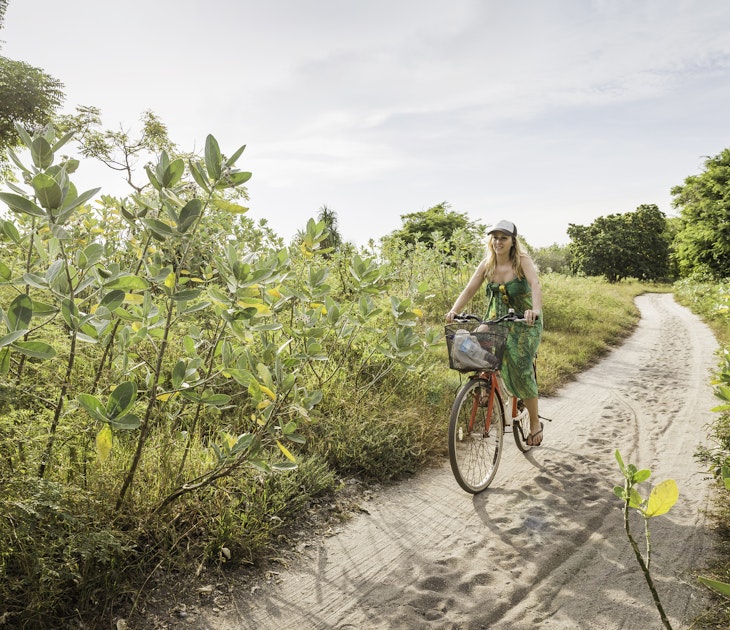
Budget Travel
Apr 21, 2024 • 6 min read
You can get a lot of bang for your buck on these three tiny islands off the west coast of Lombok – if you know where to look.

Mar 14, 2024 • 10 min read

Feb 24, 2024 • 8 min read

Feb 3, 2024 • 7 min read

Jan 27, 2024 • 17 min read
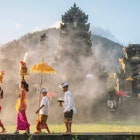
Jan 17, 2024 • 6 min read

Jan 17, 2024 • 8 min read

Jan 5, 2024 • 20 min read
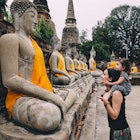
Dec 16, 2023 • 9 min read
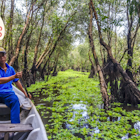
Nov 17, 2023 • 5 min read

- Laos , Vietnam
Laos vs. Vietnam
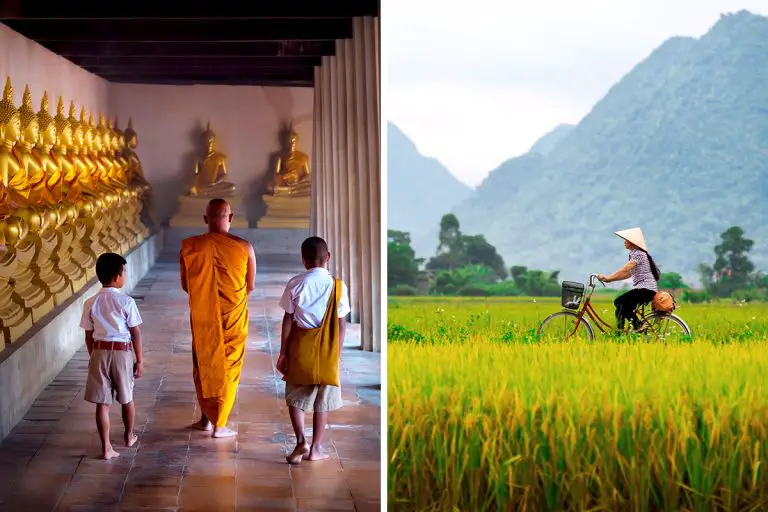
Table of Contents
You may find yourself torn between the allure of Laos’ untouched landscapes and Vietnam’s bustling cities. Both countries offer unique experiences that captivate your senses and expand your understanding of the world. So, if you’re stuck on where to go, buckle up! We’re about to embark on a journey that compares these two fascinating places.
History & Culture
When it comes to history and culture, Laos and Vietnam are akin to treasure chests waiting to be unlocked. The historical richness of each nation tells a different story but, at the same time, shares many similarities.
Laos boasts a history that’s steeped in spiritualism and folklore. The country remained relatively isolated for centuries, allowing its ancient traditions to flourish. In contrast, Vietnam has a more complex historical background, colored by various invasions, colonial rule, and a notable wartime period.
While Laos provides a serene, spiritual backdrop, Vietnam serves as a dynamic canvas showcasing resilience and cultural evolution.
These nations share the influence of Buddhism, but their interpretations differ. In Laos, Buddhism permeates every aspect of life, from architecture to daily rituals. Vietnam, on the other hand, has a more diverse religious landscape, incorporating elements of Confucianism and Taoism alongside Buddhism.
Furthermore, traditional arts play a significant role in both countries. In Laos, you’ll find an emphasis on textile arts, specifically intricate weaving. Vietnam takes pride in its folk music and theater, especially the unique water puppetry shows that are a must-see.
To sum up, both Laos and Vietnam offer rich cultural experiences but in very different flavors. Laos gives you a peaceful journey through a simpler, spiritual past, while Vietnam offers a multi-layered history that reflects its diverse influences. So, the question remains: Are you in search of spiritual solitude or a dynamic, evolving culture? Your answer could guide your choice between these two captivating destinations.
Attractions & Activities
If you’re an adventurer at heart, both Laos and Vietnam have incredible offerings that will quench your thirst for discovery. Whether it’s riding on the back of an elephant in Laos or trekking through Vietnam’s terraced rice fields, your options are varied and abundant. Let’s delve into what makes each of these countries a hotspot for attractions and activities.
In Laos, a popular choice for many is to explore the mystical Plain of Jars—a megalithic archaeological landscape scattered with large stone jars of unknown origin. For the nature enthusiast, the rugged terrains of the northern regions offer thrilling trekking opportunities.
Don’t forget to take a slow boat cruise down the Mekong River, a peaceful yet exciting way to see the countryside.
Vietnam, on the other hand, offers an array of activities centered around its dramatic landscapes. The iconic Ha Long Bay is a haven for boat cruises among towering limestone pillars.
For those interested in history, a visit to the Cu Chi Tunnels provides a sobering look at the ingenuity of wartime strategies. And for the outdoorsy types, the terraced rice fields of Sapa offer an incredible trekking experience that’s hard to beat.
While both countries offer nature-based activities, they differ in their type and scale. Laos focuses on smaller, intimate experiences deeply connected to its local traditions. Vietnam, meanwhile, offers grander, more visually arresting sights that are often popular tourist destinations.
In summary, Laos provides you with an experience that is intimate, deeply traditional, and spiritually enriching. Vietnam presents you with a scale that’s grander and more iconic, closely connected to its complex history and stunning landscapes. So, will it be the tranquility of a Mekong River cruise or the awe-inspiring views of Ha Long Bay that captivate you?
Ahh, the beaches! If you’re a fan of sandy shores and crystal-clear waters, both Laos and Vietnam have something to offer. But how do they stack up against each other? Let’s find out.
Laos is landlocked, meaning you won’t find traditional beaches here. However, the country compensates with its riverbanks.
Take, for example, the Four Thousand Islands in the Mekong River. The sandy shores offer a unique beach-like experience, where you can sunbathe and enjoy water activities. The longest of these ‘river beaches’ stretches for approximately 3 miles (about 4.8 kilometers).
Vietnam’s coastline is a whole different story. Stretching over 2,000 miles (around 3,218 kilometers), the country has a plethora of beaches. Phu Quoc Island is renowned for its white sands and turquoise waters, while Da Nang offers more rugged and windswept landscapes.
What sets the two apart are not just the landscapes but also the types of activities you can indulge in. In Laos, it’s more about enjoying a peaceful moment by the water, perhaps with a book in hand. Vietnam offers a multitude of water sports, from paddleboarding to jet-skiing, thanks to its expansive coastline.
In conclusion, Laos and Vietnam offer unique beach experiences. Laos focuses on peaceful riverbank relaxation, while Vietnam brings an array of options for those looking to add some excitement to their beach visit. So, are you leaning towards the serene calmness of a Laotian riverbank, or does the expansive variety of Vietnam’s coastlines call to you?
Eating, Drinking & Nightlife
When it comes to satiating your gastronomic desires or quenching your thirst for fun, Laos and Vietnam have got you covered. The question is: Which destination caters more to your taste buds and social inclinations? Let’s dig into the flavors and vibes of these two countries.
In Laos, the food scene is a culinary adventure rooted in simple yet flavorful dishes. Think sticky rice, fresh vegetables, and lots of herbs. The local Laotian beer complements the food quite well, offering a refreshing balance to the local spices. On the drinking side, don’t miss out on trying “Lao-Lao,” a traditional rice whiskey that’s incredibly popular.
Vietnam takes its cuisine to another level, with an array of options ranging from the famous Pho to the scrumptious Bánh Mì sandwiches. Vietnamese coffee, brewed with a drip filter, is a must-try and pairs excellently with the local cuisine. When it comes to drinks, Bia Hoi, a freshly brewed beer, provides a unique Vietnamese experience.
Switching gears to nightlife, Laos offers a more subdued experience. Expect small bars and cafes where you can enjoy a quiet evening. However, the night markets in cities like Luang Prabang keep things lively, offering local crafts and snacks until late hours.
Vietnam, conversely, is bustling when the sun goes down. From rooftop bars in Ho Chi Minh City to karaoke parlors in Hanoi, there’s something for every night owl. The country is renowned for its vibrant street life, which continues well into the night.
In summary, Laos offers a humble yet flavorful culinary experience, accompanied by a calm and intimate nightlife. Vietnam dishes out an eclectic range of food and drinks, topped off with a more dynamic and varied night scene. What will it be for you? A laid-back evening in a Laotian café or a lively night in the streets of Vietnam?
Whether you’re hunting for unique souvenirs or just want to indulge in some retail therapy, both Laos and Vietnam have something intriguing to offer. What should you expect when it comes to shopping in these two countries?
Laos specializes in handmade crafts, particularly textiles. In the markets of Vientiane or Luang Prabang, you can find intricately woven silk and cotton fabrics. The country is also known for its beautiful silver jewelry, often crafted by local artisans. It’s a great place to buy unique, high-quality items directly from the makers.
Vietnam offers a broader range of shopping experiences. In Hanoi, you can explore ancient streets dedicated to specific crafts, like Hang Bac for silver or Hang Gai for silk. Ho Chi Minh City provides a more modern shopping experience with malls like Vincom Center, where international and local brands co-exist.
While both countries offer textile items, the styles and materials are quite different. Vietnamese silk, for instance, is often brighter and more patterned, whereas Laotian textiles tend to use more earthy tones and intricate weaving.
To sum it up, Laos offers an intimate shopping experience focused on handmade, artisanal products. Vietnam provides a vast array of options, from traditional crafts to modern retail spaces. So, are you keen on handcrafted Laotian textiles or do the bustling markets of Vietnam excite you more?
Accommodation
Finding the right place to lay your head is a critical part of any journey. Laos and Vietnam, both rich in culture and natural beauty, offer a range of accommodation options that cater to various tastes and budgets. Let’s explore what you can expect in terms of lodging in these destinations.
In Laos, you’ll find plenty of budget-friendly guesthouses, often run by local families. These offer a more intimate experience, complete with home-cooked meals and warm hospitality. For a more upscale experience, luxury resorts near scenic spots like the Mekong River or in cultural hubs like Luang Prabang are also available.
Vietnam boasts a wider variety of options, from budget hostels in backpacker districts to world-class luxury hotels. Cities like Hanoi and Ho Chi Minh City offer stylish boutique hotels situated near main attractions, providing both convenience and comfort.
One key difference lies in the amenities offered. Vietnamese hotels often come with more modern conveniences, such as Wi-Fi, air conditioning, and in-house restaurants. In Laos, the focus is more on the experience and less on creature comforts, although Wi-Fi and basic amenities are generally available.
To summarize, if you’re looking for a more traditional, close-to-the-land experience, Laos offers cozy guesthouses and intimate resorts. If modern amenities and a broad range of options appeal to you, Vietnam is your go-to. Where do you see yourself relaxing after a long day of exploration?
Family-Friendliness & Children’s Activities
Taking a family trip? It’s crucial to consider how kid-friendly your destination will be. Laos and Vietnam have distinct features when it comes to family-friendliness and children’s activities. Here’s the scoop.
Laos is generally less crowded and offers a relaxed pace, making it an excellent choice for families who prefer quieter holidays. Children can engage in nature walks, animal spotting, and even some easy trekking in protected national parks.
Vietnam, on the other hand, is a bustling place with lots of family-friendly activities, especially in larger cities. Interactive museums, cultural shows, and cyclo rides are just a few things that can keep kids entertained. Plus, many hotels in Vietnam offer family rooms and even babysitting services.
When it comes to safety, both countries are generally safe for families, but Vietnam’s more developed infrastructure may provide an extra layer of comfort for some parents.
However, if your kids are the adventurous type, they might find the raw, untouched nature of Laos more exciting, where they can learn about local tribes and their way of living.
In summary, Laos offers a more laid-back, nature-focused family experience. Vietnam provides a blend of educational and entertaining activities for kids, set against a backdrop of a more urban environment. Which environment would your family thrive in?
Getting There & Getting Around
Getting to and navigating through your chosen destination are crucial elements of your travel plans. Laos and Vietnam offer different experiences when it comes to both. Let’s break it down.
To get to Laos, most travelers will likely fly into Wattay International Airport in Vientiane, the capital. The airport is approximately 3 miles (about 4.8 kilometers) from the city center.
For Vietnam, the major international gateways are Tan Son Nhat International Airport in Ho Chi Minh City and Noi Bai International Airport in Hanoi. These airports are roughly 4 miles (about 6.4 kilometers) and 21 miles (about 33.8 kilometers) from their respective city centers.
Within Laos, the primary mode of transportation is by bus or minivan for longer distances. Tuk-tuks and bicycles are popular for getting around in cities and towns. The road network is less developed, and the pace is generally slower.
Vietnam offers more in terms of transportation options. You’ve got buses, trains, and domestic flights connecting major cities. In urban areas, motorcycles, taxis, and even app-based ride services are readily available.
In summary, while Laos provides a more relaxed, slower-paced travel experience, Vietnam offers more efficiency and options, making it easier to get around. Both countries have their own unique transportation flavors; it just depends on what suits your travel style.
When you’re planning a trip, weather is a key factor that can make or break your vacation. Laos and Vietnam, located in Southeast Asia, have tropical climates but with some differences. Let’s dig into the specifics to help you choose the perfect travel time.
In Laos, the dry season runs from November to April, with temperatures ranging from 60-85°F (15-30°C). The wet season, from May to October, sees higher humidity and temperatures around 75-91°F (24-33°C). November to January is particularly cool, making outdoor activities like trekking more comfortable.
Vietnam has more varied weather due to its elongated shape. In the North, like Hanoi, you’ll find a distinct winter from December to February with temperatures dropping to 50-65°F (10-18°C). The south, such as Ho Chi Minh City, is hot all year round, ranging from 77-95°F (25-35°C).
The central regions of Vietnam, like Da Nang, have their rainy season from September to December. The rainy season in the south runs from May to November, while the north has its wet months from May to September.
Both countries have their fair share of hot and humid days, but Vietnam offers a broader range of weather experiences due to its geography.
To sum up, if you prefer cooler and less humid weather, consider visiting Laos from November to April or Northern Vietnam from December to February. If you love the heat, Southern Vietnam might be more your style.
Your safety is paramount when you’re miles away from home. Let’s look at what Laos and Vietnam offer in terms of ensuring a secure trip.
In general, Laos is considered safe for tourists, with low crime rates, especially in rural areas. Violent crimes are rare, but petty theft like pickpocketing can occur, particularly in crowded places.
Vietnam is similarly safe in terms of crime rates. Scams targeting tourists are more common, especially in big cities like Hanoi and Ho Chi Minh City, so always be aware of your surroundings.
In terms of health, both countries require caution when consuming street food and tap water. Also, make sure to get vaccinated for tropical diseases like Dengue Fever, prevalent in both countries but more so in the rainy seasons.
To sum it up, both Laos and Vietnam offer relatively safe environments for tourists. The key is always to exercise common sense, be aware of your surroundings, and take necessary health precautions.
Knowing the costs involved can help you make a more informed decision on your travel destination. So, let’s compare what your wallet should be prepared for in Laos and Vietnam.
In Laos, a decent meal at a local eatery will set you back around 20,000-80,000 Lao Kip (approximately $2.50-$10). Accommodations like guesthouses can range from approximately $50 per night. For transportation, buses between cities usually cost around 60,000-100,000 Lao Kip (approximately $7.50-$12.50).
Vietnam offers a similar budget-friendly experience but with more options. A local meal costs around 50,000-200,000 Vietnamese Dong (approximately $2.50-$10). Hotel rooms average approximately $130 depending on location and amenities. Inter-city trains or buses may cost between 100,000-300,000 Vietnamese Dong (approximately $5-$15).
When it comes to activities, Vietnam generally has more variety, but that often comes at a higher cost. You might spend a bit more on entry fees to museums or historical sites, often ranging from 30,000-150,000 Vietnamese Dong (approximately $1.50-$7.50).
In summary, both Laos and Vietnam are relatively affordable destinations, with Vietnam offering a wider range of options at varying costs. Your choice will ultimately depend on what kind of experience you’re looking for and how flexible your budget is.
Which Is Better – Laos or Vietnam?
Wrapping up a multi-faceted comparison like this isn’t simple. Both Laos and Vietnam bring their own unique flavors to the table, each having distinct draws and occasional drawbacks. Let’s summarize what we’ve discovered in the various sections to help you decide your next destination.
When it comes to History & Culture, Laos offers a laid-back experience, perfect for soaking in its unique traditions and culture. On the other hand, Vietnam provides a more dynamic and diverse cultural landscape, thanks to its long, varied history.
If a calmer, more homogenous experience intrigues you, Laos is the place to be. But if you thrive in a melting pot of cultures and historical eras, Vietnam is your go-to destination.
For Attractions & Activities, Vietnam tends to have a wider range of options, offering something for everyone. Laos has its own charm, best suited for those looking for a relaxed pace with fewer crowds. If you’re an adventure seeker or a history buff, Vietnam’s diverse offerings will likely be more up your alley.
In terms of Beaches, both countries have their own unique coastal paradises, but Vietnam’s extensive coastline gives you a wider range of options. If you’re looking for a lesser-known beach experience, Laos could be your haven.
When it comes to Eating, Drinking, & Nightlife, Vietnam offers a bustling scene with a wider range of food and beverage options. Laos is best for those who prefer quieter, less crowded establishments. If a vibrant nightlife is what you seek, then Vietnam is the place for you.
As for Accommodation, both nations offer a range of options to suit various budgets. Laos leans toward simpler, more traditional lodgings, while Vietnam offers more variety, including luxury options.
Lastly, if you’re traveling with family, both nations offer family-friendly options, but Vietnam has a wider range of activities designed for kids. Laos, on the other hand, is a quieter destination that offers a more relaxed atmosphere, which some families may prefer.
In the end, your ideal destination comes down to your personal preferences. If you’re seeking a more laid-back, less touristy experience with a focus on natural beauty and simpler times, then Laos should be on the top of your list. However, if you’re looking for a dynamic atmosphere with a wide array of activities, cultural sites, and food experiences, Vietnam is your answer. Choose according to what most resonates with you and you can’t go wrong.
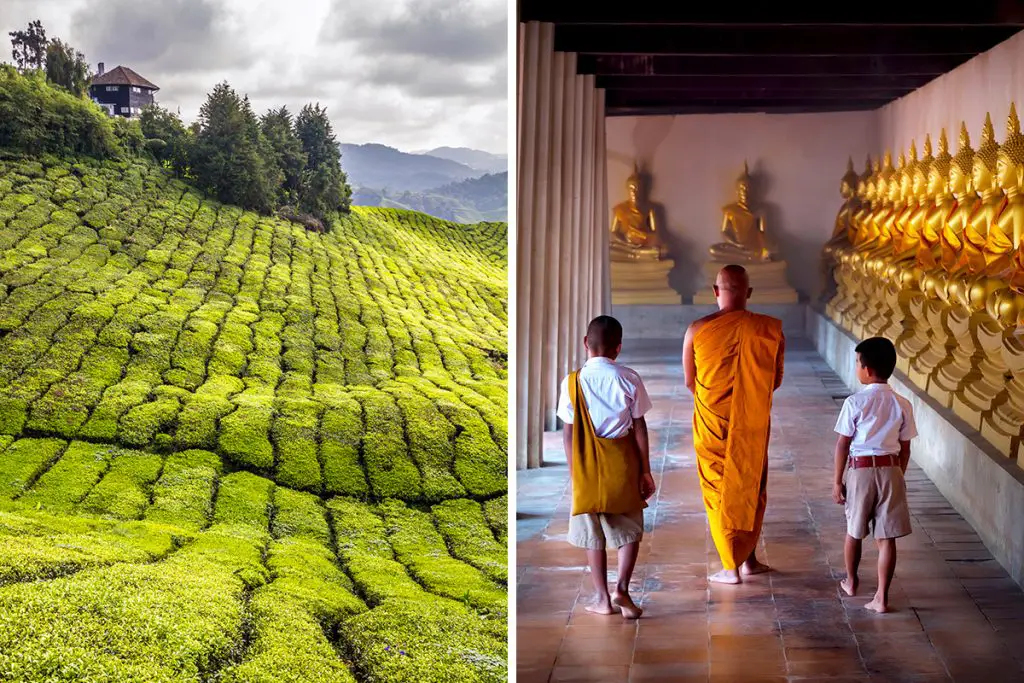
About | Contact | Privacy Policy
Copyright © Loco Media
- Skip to primary sidebar
- Skip to content
- Skip to footer

My Five Acres
Make Travel Truly Transformational
Thailand or Vietnam? Which is Best for Your Next Adventure?
Trying to decide between visiting Thailand or Vietnam ? These are two very different countries that both deliver incredible travel experiences. Read on to choose the adventure that’s right for you.
What’s in our guide to Thailand vs Vietnam?
Thailand or Vietnam? What a tough choice to make!
Both countries offer incredible cuisines, friendly cultures, and spectacular sights.
If you have all the time in the world, then you should obviously visit both (and throw in Laos and Cambodia , too).
But if real life is getting in the way of a perpetual holiday, then it’s best to choose either Thailand or Vietnam and save the other for your next adventure.
So read on to decide between Thailand and Vietnam.
1. Best Travel Experiences in Vietnam and Thailand

Must-See Highlights in Thailand & Vietnam
Vietnam’s number one destination is Ha Long Bay , a natural wonder where dramatic karst formations sink into the sea like dragons going for a dip.
In Thailand, you have the spectacular beaches of the south, where dramatic karst formations sink into the sea like… well, you get the idea.
If you’re a nature buff who likes the water, both Vietnam and Thailand have plenty on offer. Thailand is more focussed on white sand beaches, whereas in Vietnam, you’ll find lots of opportunities to get out on boats, big and small.
City Experiences
My favourite city in Vietnam is Hanoi , where wandering the Old Quarter is a mind-blowing experience – expect major culture shock if you haven’t spent much time in Asia. If you’re after something slightly more modern, head to Ho Chi Minh City, a city of contrasts, where the ultra-rich live in million-dollar condos overlooking shacks which house the ultra-poor.
In Thailand, you have Bangkok , one of the most mind-boggling cities on the planet. For big-city drama and entertainment , Bangkok will blow you away. If the idea of that much traffic and all those people is a little terrifying, you can always go to Chiang Mai, is a popular digital nomad destination in the north.
While Vietnam has lots of spectacular beaches, especially in the southwest, there’s no way they can compare to the world-renowned beaches of southern Thailand. If all you want to do is lie on a sun lounger and stare out at perfect cerulean sea, then Thailand is your hands-down winner.
Wilderness and Trekking
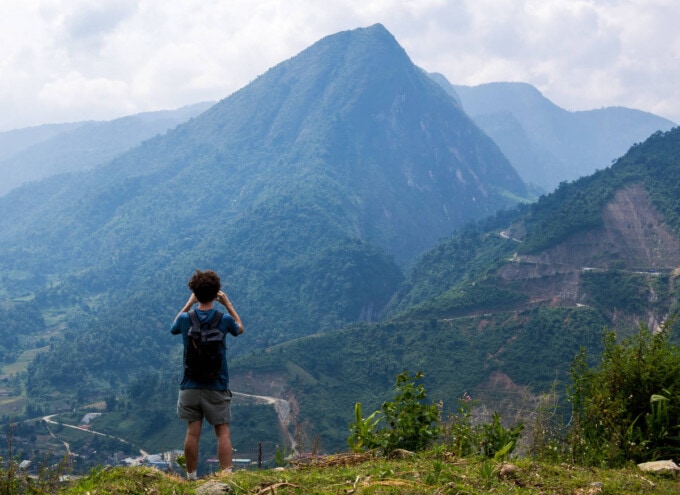
You can do some exciting trekking in Northern Thailand, but if you want to spend a lot of time in wild nature, Vietnam is the place to go. Vietnam’s landscape is so varied, from the mountainous north to the jungley Mekong Delta in the south , that you’ll never get tired of the views.
Vietnam doesn’t have a whole lot on offer when it comes to don’t-miss wildlife experiences. In Thailand, you can get close to nature, but the country has a terrible record when it comes to animal cruelty.

If you’re going to visit a wildlife attraction in either country, please choose carefully to ensure your money doesn’t contribute to animal cruelty.
Please never ride an elephant or visit a tiger temple! These attractions are inherently cruel to animals and many are responsible for poaching of wildlife from neighbouring countries.
City Tours and Bike Tours
Both Thailand and Vietnam offer amazing experiences when it comes to tours, long or short.

In Thailand, hop on a bicycle to:
- Explore Bangkok by night
- Experience the Chiang Mai countryside , or
- Take a 5-day family adventure along the south coast
In Vietnam, you can:
- Cycle the Mekong Delta
- Discover Hoi An by bike and kayak
- Take an amazing 11-day bike and boat adventure
If you want to explore Thailand, Cambodia, and Vietnam all together, you can even cycle all the way from Bangkok to Saigon !
2. Transportation
Busses in vietnam.
A well organized bus network links every conceivable spot most visitors want to go in Vietnam.
Long-distance busses in Vietnam are affordable, generally on time, and somewhat comfortable. Journeys longer than a few hours are usually in a sleeper-style bus, where you can (almost) stretch out on a bunk and might even get some sleep.
Nightmare tales of dangerous drivers and filthy busses are mostly a thing of the past — now busses are, if not luxurious, a reliable way get around Vietnam.
Trains in Vietnam
There is a single train line in Vietnam that starts in the far north and winds its way down along the east coast, turning inland to end up in Ho Chi Minh city. The train is no faster than the bus, is more expensive, and less convenient, since train stations are usually not in the centre of town.
The train can be useful for making the overnight journey from Hanoi to Sapa or for a quick ride from Ho Chi Minh City to Mui Ne .
Easy rider motorbike in Vietnam
One of my favourite Vietnam experiences was my trip from Hue to Hoi An by motorbike . I have never driven a motorbike in my life but in Vietnam, you can hire a bike and driver.

You sit on the back watching the world go by while they do all the work. This kind of transportation is ideal for maximum 5 or 6 hours — after that your butt (and possibly the rest of you) will fall asleep!
Flying in Vietnam
We never recommend flying around inside a country; flying is expensive, bad for the environment, and makes you miss hundreds of travel experiences. If you have limited time in Vietnam, don’t plan to see the whole country. Just focus your adventures in the north or the south for maximum enjoyment!
(Don’t miss: Our Vietnam itineraries are the perfect tool to help you start planning) →
However, if you must fly in Vietnam, there are lots of cheap flights available . But be warned, the low cost airlines in Vietnam (JetStar and VietJet) have a reputation of being late all the time!
We once go to the airport in Nha Trang only to discover that our flight was delayed by 8 hours. Yikes! We quickly re-booked onto Vietnam Airlines and took the financial loss as an expensive lesson.
See Vietnam Transport Options →
Transportation in Thailand
Transportation is also very easy in Thailand, though there are some less-traveled routes that you might have to do by taxi or private minibus.
Busses in Thailand
Like Vietnam, Thailand has a well developed bus network that will take you almost anywhere you want to go.
However, according to this article on World Nomads , Thai roads are some of the most dangerous in the world, so make sure you book with a reliable bus company.

To stay safe, opt for a VIP bus, where you’ll pay a little more, but you’ll get a lot in return. VIP busses have air-conditioning, safety standards, comfortable seats, and even WiFi (though if I ever get WiFi to work properly on a bus I will be amazed!). If you’re on a tight budget, the bus is a great way to get around in Thailand – as long as you can handle the frenzy of speeding traffic on Thai motorways!
Trains in Thailand
If the idea of Thai traffic freaks you out, or if you want to travel in a little more comfort, take the train in Thailand.
Though there are relatively few train lines, the network is developed enough to deliver you to the most popular destinations, as long as you’re planning on going through Bangkok.
From Bangkok, you can take the train to Chiang Mai in the north, or to Nong Khiaw for transfers to Laos, and Aranyaprathet to head to Cambodia.
Heading south from Bangkok, the train goes past the famous destination islands of Ko Phangan and Ko Samui, right to the Malaysian border town of Hat Yai.

Actually, you can keep going right through Malaysia and all the way to Singapore by train.
Though not as cheap as busses, trains in Thailand are a better bet for overnight rides, as you can get a relatively inexpensive (and usually pretty modern & comfy) sleeper bunk.
(Related: Here’s everything you need to know about train travel in Thailand ) →
Flying in Thailand
If you want to visit the north and the south of Thailand, and you can’t stand the thought of an overnight train ride, flying between the two is your best option. Of course, we never recommend flying because it’s terrible for the environment and you miss out on so much!
But if you must fly, Air Asia is usually the most reliable and budget-friendly option to get between Thai airports .
See Thailand Transport Options →
Vietnam vs Thailand – Transportation
It’s a little cheaper to get around Vietnam than Thailand but the price difference isn’t big enough to make a huge difference. Believe it or not, in Vietnam, busses are safer — if less comfortable — than in Thailand, mostly because there are fewer huge trucks being driven at ridiculous speeds in Vietnam.
If you love to take the train, then opt for Thailand, since their rail network is far more modern, extensive, and reliable than Vietnam’s.
3. Food in Vietnam and Thailand
What you’ll eat in vietnam.
For omnivores, Vietnamese food is cheap, plentiful, and delicious (or so I’ve been told). There are huge bowls of Pho made with hearty beef broth on nearly every corner, lots of fresh seafood, banh mi sandwiches and lots of other adventurous foods to try.
For vegans and vegetarians, Vietnam is a little more difficult. Luckily, you can use my veggie guides to Hanoi , Hue , and Hoi An to find all the most drool-inducing animal-friendly food!
What you’ll eat in Thailand
In Thailand, the type of food available depends very much on where you go.
Chiang Mai has a huge expat population, which means you can get pretty much any type of food you want, including lots of healthy, vegan, and vegetarian options. In the touristy areas of southern Thailand, you’ll find Thai favourites like green curry, papaya salad and pad thai, adapted for a Western palate.
Try to experience at least one authentic Thai night market. To do this, you’ll have to leave the most touristy areas and visit a smaller town. Thai night markets are an omnivore foodie’s delight, with tons of strange and wonderful foods to try.

Vegans and vegetarians will find market eating in Thailand a challenge, since it’s rare to find veggie options and almost everything contains fish sauce. Hunt until you find a Pad Thai stall (not as easy as it sounds) and then request they make it with no egg. It won’t necessarily be free of fish sauce but it’ll be a delicious alternative to going hungry!
Vietnam or Thailand – Food
As vegans, we prefer the food in Vietnam, as it is easier to find fully meat-free restaurants. Vietnamese cuisine is also lighter and fresher than Thai food. Finally, if you aren’t great with spicy foods, you’ll find it a lot easier to feed yourself in Vietnam.
However, if you are an omnivore who loves fiery food, then you won’t be able to get enough of Thai night markets, where spicy curries and mysterious meaty dishes are available for a few dollars.
Of course, in Ho Chi Minh City and Bangkok, you can get whatever food your heart desires. For fine dining aficionados, Bangkok offers some of the best food in the world.
4. Drinking in Vietnam and Thailand
Happy hour cocktails.
In both Vietnam and Thailand, you’ll find happy hour deals anywhere that tourists congregate. In Vietnam, you’re more likely to get a poorly mixed cocktail with the cheapest alcohol available. But the price is right!
In Thailand, you’ll get better quality drinks — and you can sip them on a beach lounger or at your swim-up bar. However, they’ll probably cost double or triple what you would pay in Vietnam.
Beer and craft beer
Because of laws in Thailand prohibiting people from brewing and selling their own beer, the craft beer scene in Thailand lags behind much of the world. There are a few brewpubs popping up in Bangkok which sell imported beers from around the world. There’s also a healthy underground home-brew scene for beer nerds to explore.

In contrast, Vietnam has a long history of home brewing and it’s practically a tourist rite of passage to sit in a sidewalk cafe drinking watery bia hoi , which costs about 50 cents a cup.
In the past few years, the craft beer scene in Vietnam has blossomed and grown so fast it’s impossible to keep up. There are now plenty of great Vietnam-brewed beers to keep the beer geeks (like Stephen) interested!
Thailand vs Vietnam — Drinking
If you’re into cheap and cheerful cocktails or expertly brewed craft beers, then Vietnam wins this category. However, if you like your cocktails carefully poured while lounging by the pool, opt for Thailand.
5. Accommodation in Thailand and Vietnam
Both Vietnam and Thailand offer plenty of accommodation options for all budgets, from $4/night hostel beds to villas with private pools for thousands. The standard of accommodation in both countries tends to be high, too, meaning travellers are spoilt for choice.
Budget accommodation in Vietnam and Thailand
In cities like Chiang Mai and Hanoi, the budget accommodation market is overrun with highly rated hostels offering beds for less than $5 per night. For twice that price, you can get a clean comfortable double room in a guest house or home stay. Budget travellers will find lots to love in both Thailand and Vietnam when it comes to cheap accommodation.

Boutique and luxury accommodation in Vietnam and Thailand
Boutique and luxury accommodation are quite similar in Vietnam and Thailand as well. A nice little boutique hotel will run you around $50 per night if you book early, while in luxury digs, the sky is the limit! If you’re hitting the cities or popular tourist areas, you might find accommodation in Vietnam is a little cheaper than Thailand.
Vietnam vs Thailand – Accommodation
This one is really a toss up, since accommodation is cheap and plentiful in both countries!
Find Your Perfect Accommodation →
6. Dangers and Annoyances
Bag snatchers and thieves.
Thailand and Vietnam are both very safe places to travel, and you will encounter far fewer dangers than are common in the west.
As with most major cities in Asia, bag-snatching and phone snatching can happen in Bangkok and Ho Chi Minh City – and elsewhere if you are not careful. Credit card and passport theft can also be a problem in Thailand, so keep an eye on your valuables!

Scams and sex
Vietnam has really cleaned up its act in the last decade, leaving most of the worst scams and rip-offs in the past. Now, pricing tends to be fair and honest — though you’ll still pay way more in the markets than locals do! Road safety is better too, and there are very few scams to watch out for.
The main scam in Vietnam involves copycat businesses. People who are opening new restaurants or hotels will often give them a similar name to an already popular establishment to piggyback on their success. You’ll see this all over Vietnam, but unless you’re really not paying attention, it’s pretty hard to be fooled!
The biggest scams in Thailand involve the booming sex tourism industry (yuck!). I probably don’t have to tell you this, but don’t get involved in any porn or sex industry offerings in Thailand (or anywhere) and you’ll avoid a whole world of trouble.
Drugs are out too
In Thailand, you should stay as far away from drugs as you can. Yes, even at a full-moon party where everyone else is getting off their heads. Drug penalties in Thailand are harsh and police tend to be very enthusiastic when it comes to applying those laws to foreigners.
Plus, even if you don’t get caught, drugs in Thailand can be cut with poisonous substances. Dying from dodgy drugs in Thailand is so not a good way to go!
Tuk tuk tales
Tuk tuk drivers in Thailand can be pretty annoying, especially in Bangkok. Often, they ask ridiculous rates before you even get in, and when you refuse, they won’t even bother to bargain. If you forget to agree the price before you get in, be prepared to pay outrageous amounts when you arrive at your destination.
It’s much easier to get the Grab App (Asia’s answer to Uber) and order a Grab car or bike when you need to go somewhere in Bangkok. Vietnam doesn’t do tuk tuks but you can hire a motorbike driver (called a xe om) on almost any street corner. Again, it’s easier and cheaper to get Grab and order your bike to pick you up.
Thailand or Vietnam – Dangers & Annoyances
Being busier and more modern, with a more developed party culture, Thailand is also a little more dangerous than Vietnam, which still has a “village” feel to it in many parts. Though there are very few dangers in either country, Vietnam is a little less intimidating for first-timers and women alone.
7. Solo Travel in Vietnam and Thailand
Vietnam solo travel.
Solo travel in Vietnam is fun, safe, and inexpensive. Most travel is done by bus, so the ticket price stays the same whether you’re by yourself or in a group.
There are plenty of clean, cheap hostels almost anywhere you would want to go. And if you like your privacy, you can get a nice spotless private hotel room for around $12.
It’s pretty easy to meet other travellers, since there are lots of shared activities, like exploring caves or riding the night bus! I have also had great conversations with local women when I’ve ended up being the only one on a tour.
Thailand solo travel
The only time I’ve travelled solo in Thailand was when I was being treated for, and subsequently recovering from, malaria. My only Thai travel experiences have been with Stephen.

(By the way, I got malaria in Laos, so this doesn’t count as a Thai danger – though you can get malaria there and in Vietnam, too.)
From talking to other travellers, it sounds like travelling alone in Thailand is just as safe and easy as in Vietnam. The laid-back backpacker scene is more developed in Thailand (at least in the beach areas of southern Thailand), so if that’s your vibe, it will be easy to find other solo travellers to hang out with.
(Related: Adventurous Kate recommends Thailand as the best country for your first solo trip to Asia) →
Vietnam or Thailand – Solo Travel
Solo travellers will have no problems in either Vietnam or Thailand. Both countries are extremely safe and welcoming, as long as you keep your wits about you.
8. Thailand or Vietnam – Which is Best for Your Adventure?
For me, Vietnam will always win this battle. Thailand is a little too Western and a little too easy to excite my adventurous soul. Plus, I have spent so much time in Vietnam, I feel really comfortable with the people and the culture there.
Choose Vietnam if you’re an independent traveller who wants a deep cultural experience combined with lots of time outside in nature.
Choose Thailand if you want a laid-back holiday, where you can just relax on the beach. Thailand is also best for spiritual attractions, from ancient temples to yoga retreats.
More Thailand & Vietnam Travel Tips
- Vietnam Travel Advice – All Our Best Tips
- Vietnam Itineraries for All Travel Styles
- Transformational Things to Do in Vietnam
- Thailand Travel Advice – All Our Best Tips
- Thailand Itineraries for All Travel Styles
You made it to the end of the post, so have you made your decision? Are you going to go to Vietnam or Thailand? Or will you make the time to visit both? If you have any questions shout via email or Instagram.
♥ Happy mindful adventures, Jane & Stephen
It’s easy to help us keep this blog going! Some of the links in this post are our personal affiliate links. If you book or buy something using one of the links in this post, we’ll earn a small fee at no extra cost to you. Of course, we would never recommend anything we didn’t 100% believe in! Huge thanks in advance! –S&J

Share With Your Friends
Get 101 travel tips.
Get our free ebook, 101 Travel Tips for Mindful Adventurers. It’s packed with our best tips for saving money, planning for travel, booking flights and accommodation, traveling sustainably, and staying on the road for longer! We ask for your email address so we can send you an email about once every month with our latest travel tips, destination advice, and personal stories about life on the road.
Thanks for joining My Five Acres.
Oops. Something went wrong. Please try again.
No spam ever. Your privacy is protected!
About Jane Mountain
Hi, I'm Jane, founder and chief blogger on My Five Acres. I've lived in six countries and have camped, biked, trekked, kayaked, and explored in 50! At My Five Acres, our mission is to inspire you to live your most adventurous life and help you to travel more and more mindfully.
Get Your Copy of How to Transform Your Life Through Travel!

About My Five Acres
Eight years ago, we sold our house and quit our jobs. Now we travel full-time and help others transform through travel.
We're here to help you find life-changing travel experiences that widen your perspective, challenge your beliefs, and shake you awake into your own life.
Find out how →
Useful Links
- Our Favourite Travel Tools
- Our Latest Blog Posts
- Press & Awards
- Privacy Policy & Disclaimers
Affiliate Disclosure
Search my five acres.

Ομαδικά ταξίδια
Αναχώρηση από.
- Θεσσαλονίκη
- Απρίλιος 2024
- Μάιος - Ιούνιος 2024
- Καλοκαίρι 2024
- Οκτώβριος - Δεκέμβριος 2024
- Χριστούγεννα 2024 - Πρωτοχρονιά 2025
Γεωγραφικές Περιοχές
- Απω Ανατολή
- Βόρεια Αμερική
- Ινδική Χερσόνησος
- Ινδικός Ωκεανός
- Κεντρική Αμερική και Καραϊβική
- Κεντρική Ασία
- Μέση Ανατολή
- Νότια Αμερική
- Νοτιοανατολική Ασία
- Ωκεανία-Ειρηνικός
Ενδιαφέροντα
- Διαδρομές με πλοίο
- Διαδρομές με τρένο
- Θαύματα της φύσης
- Θεματικά ταξίδια
- Ιστορία και πολιτισμός
- Περπάτημα και τρέκινγκ
- Σαφάρι και άγρια ζωή
- Ταξίδι με μέρες σε παραλία
- φθηνότερο → ακριβότερο
- ακριβότερο → φθηνότερο

IMAGES
VIDEO
COMMENTS
VERSUS ΜΕΕΤING HALL, OPERATION, INCOMING T: +30 210 32 32 800 F: +30 210 32 32 450 Φιλελλήνων 7, Σύνταγμα, 105 57 (1ος & 3ος όροφος) ... Versus Travel Cyprus Ltd. (VTC) Λεωφ. Αρχιεπισκόπου Μακαρίου Γ΄ 82Ε ...
Καμπότζη, Στο «Machu Picchu της Ανατολής». Ανάμεσα στην Ταϊλάνδη, το Λάος και το Βιετνάμ βρίσκεται ένας από τους πλέον ανερχόμενους τουριστικούς προορισμούς. Ύστερα από δεκαετίες πολέμου, η ...
Μόνο Στο Versus. Γιατί να επιλέξετε το Versus Travel. Ταξιδέψτε στην Ινδοκίνα με τους ειδικούς κaι απολαύστε το πρόγραμμα που αγάπησαν οι Έλληνες ταξιδιώτες, με πλούσιες παροχές και συνεχείς ...
Transport or Commute. - Public transport in Vietnam is slightly more useful than the almost non-existent public transport in Bali. - Renting a two-wheeler in Vietnam is slightly cheaper than in Bali. Vietnam per day scooter rental with petrol costs about USD 7, and Bali per day scooter rental with petrol costs about 9.
Southern Vietnam: hot, low rainfall, 25°C to 35°C (77°F to 95°F) April is generally a good time to visit Vietnam as it's mostly dry and warm, with temperatures ranging from around 20-30°C (68-86°F) in most regions. However, it can be hot and humid in the south, and sudden showers may come and go quickly.
It pays to imagine the country as three separate destinations when researching the weather for your intended visit - north, central, and south. In general, the best time to visit Vietnam is between November and April as these are the driest months across the country. Ho Chi Minh City at night, South Vietnam. In general, the best time to visit ...
July mirrors June and is a mixed bag weather-wise. Both north and south Vietnam are in the midst of the monsoon wet seasons, while the coastal lowland and offshore islands of Central Vietnam still bask in rain-shadow sunshine, and its beaches are the country's main draw in July. International visitors are relatively few, but Vietnamese families are traveling en-masse.
16. Know your loos. Western-style sit-down toilets are increasingly common in Vietnam, but you'll often have to pay to use public loos, and paper is rarely provided. Carry your own, or use the hose or water jug provided. Bring antibacterial hand gel or soap; many bathrooms only provide running water. 17.
Vietnam or Bali: Nature. Vietnam or Bali for nature is definitely a tough one. On the one hand there is Vietnam with its epic forests, spectacular caves, and fascinating mountain ranges. On the other hand you have Bali, a treasure trove of stunning waterfalls, incredible rice fields and sublime volcanic landscape.
Vietnam is more than 1,000 miles long, a spectacularly slim country that's only 30 miles wide at its narrowest point. Every region boasts its own allure as well as its own climate, which means ...
Δωρεάν ταξιδιωτικός οδηγός - βιβλίο στα Ελληνικά Versus Travel. Το Versus προσφέρει διανυκτέρευση σε πολυτελές ξενοδοχείο στην Ντόχα; Τα δείπνα στις 24/12 και στις 31/12 δεν είναι εορταστικά (Γκαλά).
Just one thing to note, Vietnam is cheaper than Thailand. I much prefer the North of Vietnam (well from Hoi An upwards). Thailand is a wonderful country too, so much to explore. Again the north is awesome, Chiang Mai, Pai etc. But if you are after beaches then as you well know, you will find those in the south.
10 days, two weeks, or even one month of travel to Laos or Vietnam can really add to your travel budget. Accommodation is often cheaper in Laos compared to Vietnam ($5.94 vs. $27). Budget travelers usually stay in less expensive hostels and guest houses, while nicer hotels often appeal to families and upscale travelers.
Χριστούγεννα και Πρωτοχρονία σε Βιετνάμ-Καμπότζη Αναχώρηση: 21/12 info:...
1-Week Vietnam Travel Itinerary Highlights. Most people spend at least a month went hey travel to Vietnam. But if you had just one week, or were willing to split a few weeks between the northern and southern regions, this is how we'd spend our time! Northern Vietnam. Fly into Hanoi; 2 nights - Hanoi; 2 nights - Halong Bay or Bai Tu Long Bay
September Weather and Travel in Thailand and Vietnam. Average temperature in Thailand and Vietnam: 24°C to 31°C (75°F to 88°F); high rainfall throughout. Overall, September is the wettest month to visit Thailand and Vietnam. But the rainfall in northern Vietnam will come to a tail-end in late September.
July and August are the top months for beach lovers. The hot, sticky high season from July to August is the busiest time of year to visit Vietnam, coinciding with favorable beach weather on the central coast. Demand for flights soars, and prices for accommodations can increase by as much as 50% in resort areas such as Danang and Nha Trang.
Exploring Thailand vs Vietnam: Discover the contrasts, highlights, and practical insights to help you select your travel destination.
Ταυτότητα ταξιδιού. Αν το όνομα Βιετνάμ σας φέρνει μόνο εικόνες από ταινίες, όπως ο θρυλικός ελαφροκυνηγός, τότε το ταξίδι στη χώρα αυτή, όπως το πραγματοποιεί το Versus Travel, θα κάνει την ...
Getting to and navigating through your chosen destination are crucial elements of your travel plans. Laos and Vietnam offer different experiences when it comes to both. Let's break it down. To get to Laos, most travelers will likely fly into Wattay International Airport in Vientiane, the capital. The airport is approximately 3 miles (about 4. ...
VERSUS ΜΕΕΤING HALL, OPERATION, INCOMING T: +30 210 32 32 800 F: +30 210 32 32 450 Φιλελλήνων 7, Σύνταγμα, 105 57 (1ος & 3ος όροφος) ... Versus Travel Cyprus Ltd. (VTC) Λεωφ. Αρχιεπισκόπου Μακαρίου Γ΄ 82Ε ...
Vietnam vs Thailand - Accommodation. This one is really a toss up, since accommodation is cheap and plentiful in both countries! Find Your Perfect Accommodation →. 6. Dangers and Annoyances Bag snatchers and thieves. Thailand and Vietnam are both very safe places to travel, and you will encounter far fewer dangers than are common in the west.
VERSUS ΜΕΕΤING HALL, OPERATION, INCOMING T: +30 210 32 32 800 F: +30 210 32 32 450 Φιλελλήνων 7, Σύνταγμα, 105 57 (1ος & 3ος όροφος) ... Versus Travel Cyprus Ltd. (VTC) Λεωφ. Αρχιεπισκόπου Μακαρίου Γ΄ 82Ε ...